|

This website is a complete book and
will load slower for dial-up users.
Please be patient for pictures.
This website is dedicated to the brave and
dutiful Ontarian,
Patrolman Henry Raymond Craig
Henry's family sent me his picture
when they discovered this website.
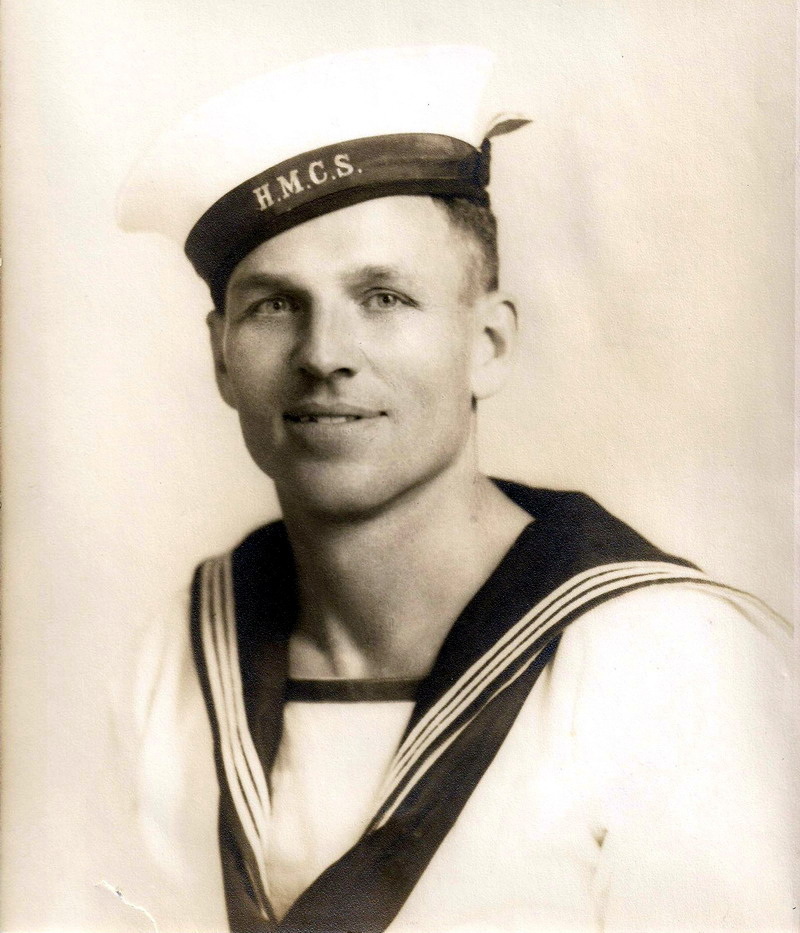
"Mr. Thompson probably owes
his life to the fact that he ran to the south
gate to give the alarm when the first outbreak of fire was noticed.
He said that while he rushed to the gate, Craig ran down the jetty
towards the fire."
Henry was/is remembered fondly by his large family as a
very loving young man.
He grew up on a farm in Aberfeldy, Ontario and was one of twelve children.
HALIFAX BLAST KILLED ABERFELDY SOLDIER
Click here to read about Henry on Genealogy.com
And here is a newspaper clipping and memorial with his picture at
Veterans Affairs Canada
Awards
to the Royal Canadian Navy
http://www.rcnvr.com/C%20-%20RCN%20-%20WWII.php
CRAIG, Henry Raymond,
Patrolman (Posthumous) (V-63822) - Mention in Despatches -
RCNVR - Awarded as per Canada Gazette of 5 January 1946. Home:
Harrow, Ontario.
CRAIG. Henry Raymond, V-63822, Patrol, RCNVR, MID~[5.1.46]
"For outstanding valour in the face of fire during the Magazine
explosion at Halifax in July, 1945. this rating was on duty at
the south jetty when the first explosion occurred. He turned in
the necessary alarm and then attempted to proceed to the scene
to help extinguish the fire. He was killed by the ensuing
explosion before he could reach the scene. His bravery and
resource were in keeping with the highest traditions of the
Canadian Naval Service."
---------
Also remembered is B. J. Pothier
who was
lost at sea in 1947
dumping explosion ammunition, a practice we have long come to
regret.
Note from the Publisher:
This website book is based on a previous
website I published years ago about a
letter written right after the explosion by a man named Cyril in Halifax to his
mother in Cape Breton.
The newspaper article on this other webpage is about this author and
the compiling of this book.
You can read the previous website by clicking this link.
The Other Halifax Explosion July 18-20, 1945
A Letter from Cyril
For Nova Scotians
and those who know not the details of this event, prepare yourself for the
riveting tales
of your local history and the absolutely fantastic
stories of civil service and duty by great
men, women, neighbouring towns and much more that transpired 68 years
ago, before, during and after...
The Other Halifax Explosion!
THANK YOU!
To
H. Millard Wright
For "researching and
compiling"
"He retired in 1992 and began writing as a hobby."
THE OTHER
HALIFAX EXPLOSION
Bedford Magazine
July 18-20, 1945
INDEX
The chapters are all linked for jumping
down and book marking.
Be sure to scroll through, as all the many pictures are not linked.
Introduction
Chapter l,
Pre-Explosion
Chapter 2,
July 18, Explosion and Evacuation
Evacuation
Emergency Services
Chapter 3,
July 19, Explosions Continue
Chapter 4,
July 20, Returning Home, Recollections
Recollections
Chapter 5,
Outside Help, Correspondence
Chapter 6,
Aftermath
Chapter 7, The
Inquiry
Chapter 8,
The Minister’s Press Release
Chapter 9, The Story
From Inside
Chapter l0,
Epilogue
Special Acknowledgements
Resources
& The Author
Back Cover with Mushroom Cloud
Introduction
Although World War II continued in the Pacific, the war in Europe
ended in May, 1945. The Port of Halifax and Bedford Basin had hosted
transport ships, tankers, warships of all types, and merchant marine
cargo vessels, all supplying materials and personnel for the war
effort. They gathered here from all along the eastern seaboard of
the United States, as well as from other Canadian ports.
There was always the fear in this seaport community of a repetition
of the huge explosion of the 1917 ammunition ship collision, when,
on December 6, the Mont Blanc steamed up from the harbour
mouth where she had anchored overnight. Her cargo consisted of TNT,
tons of picric acid, and a deck load of benzol drums. About the same
time, the Norwegian steamer Imo chartered for Belgian relief
purposes, came out of Bedford Basin. At the Narrows, the two
collided. The result was the largest man-made explosion prior to
Hiroshima, with over 1,600 deaths recorded and the destruction of
thousands of homes.
Between this Halifax and the summer of 1945 there had been several
close calls, largely unknown to Haligonians. The V-E (Victory in
Europe) Day riots had caused strife between the service personnel
and citizens, but the City was working hard
to put that in the past.
Trouble came at supper hour on
July 18, 1945, toward the close of what had been a hot summer’s day.
An ignition of a high powered explosive on a jetty at the Bedford
Magazine set off a series of fires, followed quickly by a big bang.
The ground shook for miles around, and the jetty and the barge tied
alongside disappeared. A high mushroom like cloud rose above the
Magazine that could be seen from distances well beyond the populated
areas surrounding Bedford Basin.
Minor explosions continued throughout the night, until approximately
4:00 am on July 19, when a huge blast shattered windows, shook
foundations, blew off roofs, and rattled walls of major buildings
throughout the area. The danger passed, but not before thousands of
refugees evacuated to the parks, protected streets, gardens, and
villages surrounding Halifax and Dartmouth. With limited roadways
leading from Halifax, particularly to the South Shore, traffic was
slow and tiring. Rescue and support systems were organized to give
whatever aid might be required, and to dispense sandwiches and
coffee. Children, adults, and seniors suffered not only physical
hardships but mental anguish and fear of what might yet come.
Fortunately only one patrolman was killed, but it was service
personnel who bravely, and without regard to their own safety,
battled the flames at the Magazine. They saved Halifax from an
explosion with the potential to wipe the city and its surrounding
neighbours off the face of the earth.
This book attempts to describe the events as they occurred and the
resulting investigations into the cause of the disaster. It draws on
written documentation, personal interviews, and archival research.
Chapter 1, Pre-explosion Conditions
In The Story of
Firefighting in Canada, Donal Baird wrote about conditions in
Halifax. The war in Europe had ended in May, 1945 and the City was
overcrowded and strained by its job as the key western terminus of
the Battle of the Atlantic convoy line. Long in fear of a repetition
of the colossal explosion of 1917, and with a couple of close calls,
the citizens and the Navy could now relax a little. The V-E Day riots
had caused bad feelings between the City and the Navy, but it was
now a time for return to normalcy. Troopships were bringing the
forces home, and naval vessels were coming home to be removed from
service.
Before the many naval vessels could be decommissioned, the key job
was to de-ammunition them. This should have been a slow process, as
safety rules allowed only one at a time to unload its lethal cargo
on the jetty at the large ammunition
storage Magazine at Burnside, above Dartmouth on Bedford Basin.
However it was politically important to speed the servicemen home as
quickly as possible, and the regulations with respect to the
handling of ammunition were bent despite
protests. In an inordinate rush, three vessels’ stocks of ammo were
on the jetties at a time. The large, carefully designed magazines in
the rocky hillside on the wooded far side of the Basin were very
safe when the rules were observed.
The possibility of another explosion preyed on the minds of
Haligonians. ln the Halifax Mail Star, May 5, 1987, Alex
Nickerson wrote that prior to the explosion at the Bedford Magazine,
a cargo ship, the Trongate, was sunk by the Navy in Halifax
Harbour in April 1942. The 7,000 ton vessel had been loaded with
drums of highly inflammable toluene, and a quantity of ammunition.
It had been waiting in the Harbour to sail in a convoy bound for
England when fire broke out. In the forts, the gunners were hoping
they might be told to sink the blazing ship, but the more
knowledgeable among them knew that large calibre shells fired across
the water could ricochet and cause great damage and loss of life on
the Dartmouth side of the Harbour.
The Navy, when called in, fired round after round of solid shot from
guns of the minesweeper Chedabucto into the Trongate
below the water line. She went down without exploding between the
Department of Transport wharf and the Sugar Refinery.
Although today the Canadian Ammunition Depot is perhaps an obscure
complex to most Haligonians, during the Second World War the arsenal
on Bedford Basin’s northeast shore presented a constant threat to
the City. As a repository for ammunition, depth charges, TNT
(tri-nitro toluene) waiting to be shipped to the front, it reminded
residents of the 1917 explosion. Not surprisingly, on July 18, 1945,
everyone assumed the worst.
Thomas Raddall in Warden of the North wrote, "After six years
of war, (on VE Day) Halifax was sacked by an unruly mob of its own
defenders and the dregs of its own population." Raddall went on to
philosophize that for complete irony all that remained was to blow
up the City with its own Magazine. The Navy had been busy calling in
ships and men from the Atlantic reaches, and preparing to switch its
efforts to the Pacific.
In Newfoundland, the St.
John’s magazine had been closed and its entire stocks sent to the
Bedford Magazine. Many ships had dumped off their stores and the
magazines were filled up. Still the ships came and the depth
charges, shells, torpedoes, pyrotechnics, and other lethal
ammunition began to pile up in the open, even on the jetties. There
was great pressure on the Magazine personnel to get the ships
unloaded and away, so the rules were broken. For two months Canadian
naval craft of all sorts had passed up the harbour and put ashore
their ammunition.
By July 18 the Bedford Basin
Magazine held an inordinate quantity of shells, bombs, mines,
torpedoes, depth charges, and other powerful materials. Much of the
ammunition was stowed away in the carefully designed and segregated
buildings, but of necessity a good deal had been stacked outdoors
for lack of storage space, and these dumps extended close to the
jetty on the Bedford Basin.
Gilbert Tucker wrote in The Naval Service of Canada,
"Throughout the war the magazines at Halifax handled a tremendous
quantity of ammunition and underwater explosive missiles for many
types of warships, as well as supplies for
defensively-armed merchant vessels. Located in Bedford Basin, the
magazines had been built in 1927 for the joint use of the army,
navy, and air force. Even before the war they had proved inadequate
for the needs of the RCN, and $130,000, a substantial amount in
those days, had been voted in the estimates for 1939 for their
enlargement. Nothing was accomplished before September however, and
during the early days of war, improvised shelter and open storage
had to be used."
As early 1940 the Naval Service had considered the provision of an
inland reserve magazine accessible by rail to all east-coast bases
in order to remove concentration of explosives at points vulnerable
to air attack. A suitable location was chosen at Renous, in
north-eastern New Brunswick, but because of the pressure of other
commitments on labor and materials, construction was not undertaken.
By the summer of 1943, over $1,300,000 had been spent on the
development of the Bedford Magazine, which by this time was used
exclusively by the RCN (Royal Canadian Navy).
Despite this relief the Halifax magazines continued to be so
overtaxed that it was not possible to comply with all safety
regulations. This was particularly true following the cessation of
hostilities with Germany, when numerous ships were being
de-ammunitioned.
For another assessment of conditions, the Halifax Chronicle
carried an eye-witness account of the ammunition which had been
placed on the south jetty shortly before 5:15 pm, about one hour and
20 minutes before the explosion: A frigate was berthed alongside the
jetty and much of the ammunition piled there apparently came from
this ship. On the south side of the jetty, stacked six feet high,
were four and four-point-seven inch shells, cordite charges, fixed
ammunition, and about 400 "Hedgehogs" and some small arms
ammunition.
On the front of the jetty facing Halifax were approximately 80 depth
charges. Facing north were six-foot piles of small arms ammunition,
"Oerlikon" (medium calibre anti-aircraft projectiles) shells and a
considerable number of hedgehogs.
Along the north jetty were three loading barges and three lighters.
Contents of one barge and one lighter were said to be depth charges,
but the contents of the other four were not known. On the jetty was
a hut said to be stacked to the roof
with small arms ammunition, Oerlikon shells and hedgehogs. This was
the situation prior to the initial explosion. Halifax and its
environs were sitting on a powder keg.


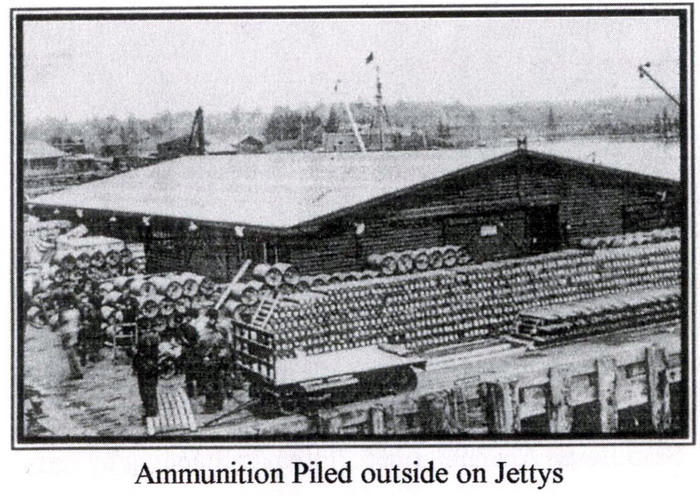
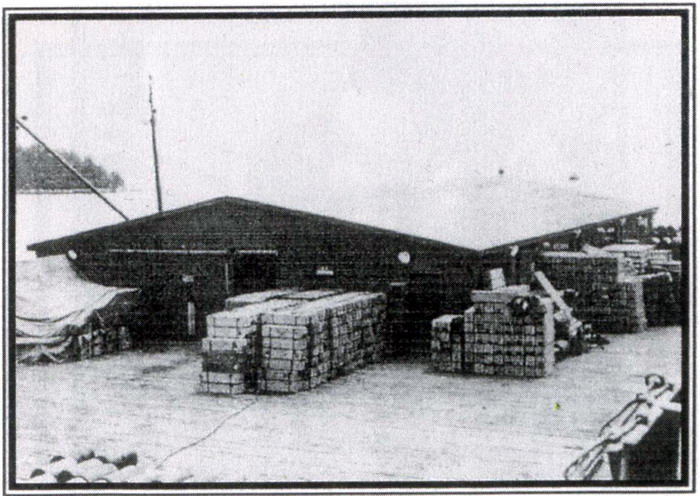

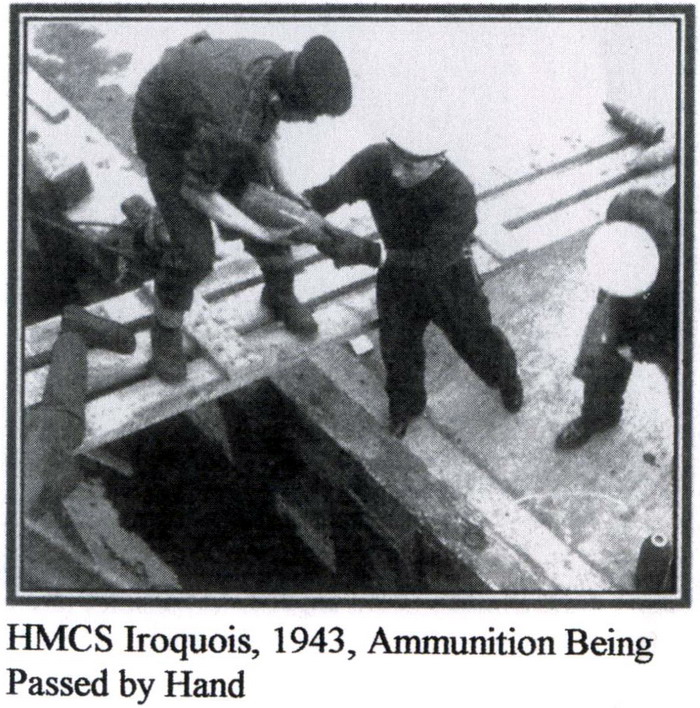



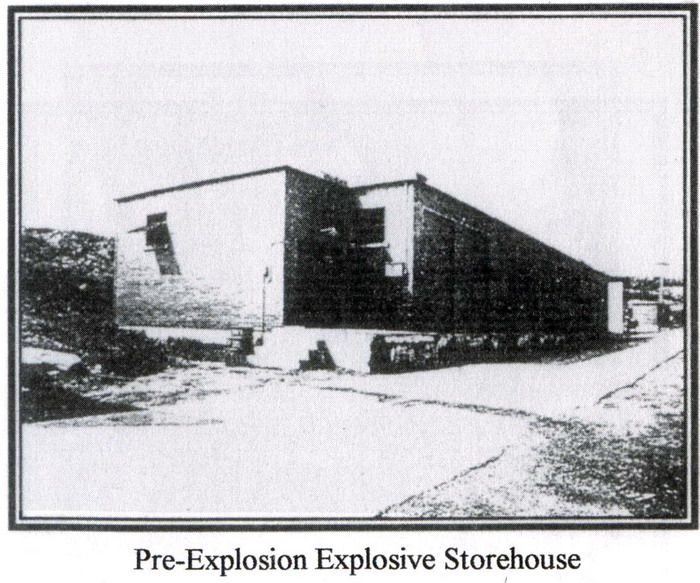
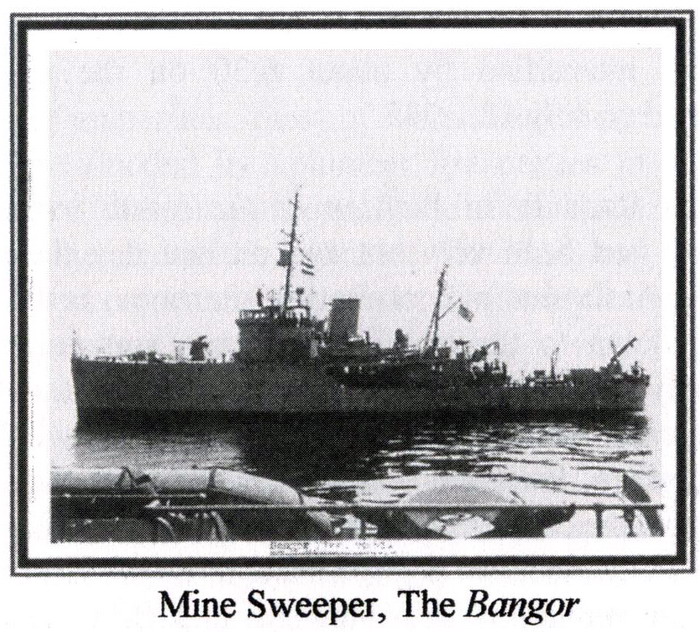
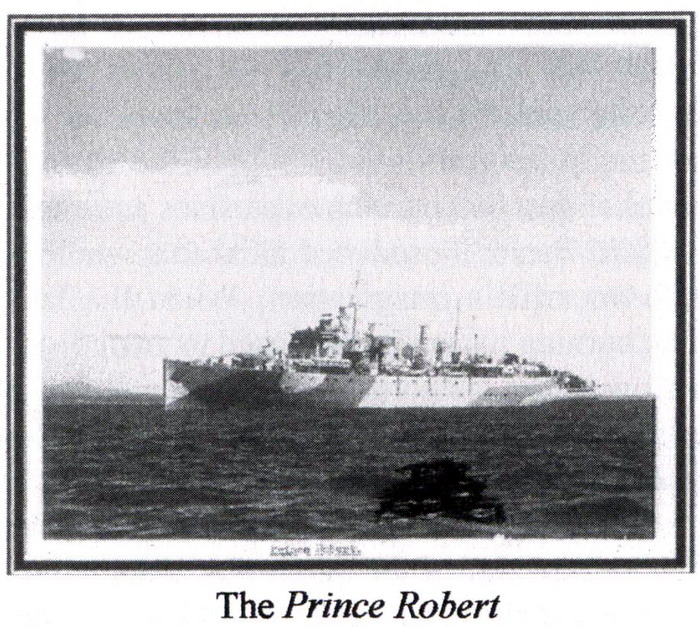
Chapter
2, July 18 The Explosion and Evacuation
Trouble intensified by about 6:30 on the evening of Wednesday, July
18, 1945.
Thomas Raddall, in Warden of the North wrote, "The summer had
been very hot and on that day the heat was stifling. At the end of a
sweltering afternoon, as the city was sitting down to the evening
meal, an ammunition barge suddenly blew up at the magazine jetty.
The blast shook the whole metropolitan area and shattered
windows in Rockingham, Fairview, and the north end of the
city. The
report and the characteristic smoke cloud, a toadstool growing
swiftly in the northern sky, were like those of December 1917 when
the munitions ship blew up in Halifax Harbour and wrecked such
devastation and loss of life. This explosion seemed to come from the
same spot. There followed an uneasy silence, but the exposed dumps
had caught fire, and soon there began incessant rumbling and
concussion which went on for more than twenty-four hours."
Raddall continued, "It was magnificent as the sun went down in a
fine red blaze that lit the whole of the west, and as the huge cloud
of dust and burning explosives arose and diffused over Bedford
Basin, it produced a tint that would have done justice to an
artist’s imagination. When the last daylight faded, the burning
magazine produced its own display, a vast golden glow across the
north, with crimson under lights, with sudden blue-white flashes,
and with fountains of rockets and star shells and flares."
One third to one half of the ammunition dump was in ruins following
the explosion. This would cover an area of approximately 400 acres
and comprised for the most part the older section of the huge dump.
The newer magazines, most of which had been built since I939, were
flooded by volunteer fire parties to avert the possibility of
further explosions. These newer magazines were located in the area
to the northeast. The blaze had started in
the southwest corner and was gradually forcing its way to the new
section when it was finally checked.
Magazine superintendent Tom Underhill much later (circa l990-2000)
studied the explosion. He believed it was sparked by a stove left
burning in a barge. When the explosion went off at about 6:30 pm
daytime workers had already gone home
for the night, Underhill concluded that the ammunition on the jetty
exploded, setting off other stacks of ammunition. The first
explosion killed a night guard, and at about 7:40 pm, just an hour
after the original outbreak, there occurred a second explosion
almost equal in intensity. After that there was a continuous roll of
exploding ammunition of all kinds. The larger blasts could be
anticipated. At the flash of an explosion, "at the end of l0 seconds
we would get the report,
blast and rattle." Finally at about 10:00 pm there was one major
crack that really shook the solid steel and concrete federal
building, at least three miles as the crow flies from the Magazine.
The 30 foot square tower actually rocked back and
forth several times on its foundations.
Fairly heavy explosions occurred regularly until almost midnight
when a very heavy detonation took place. Cartridges, the majority of
which were four-inch, exploded intermittently well into the next
day. The blast blew out windows in Africville, a community on the
west shore of the Basin.
Again, in The Story of Firefighting in Canada, Donal Baird
related personal aspects of the explosion. He writes that Captain
Robertson, commander of the Naval Dockyard, was at dinner with his
wife at the Nova Scotian Hotel. He heard
the boom, and dashed to the top floor of the hotel, and looking
north, had his worst fears confirmed.
As soon as the explosion took place, naval firefighters, the only
people who knew the layout, went to work trying to control the fires
that were spreading in the dry grass and bush near the open piles of
ammunition. In no time, the nearby barracks burned down and other
buildings were blown flat. The water main had been knocked out and
its supply tank wrecked. Captain Robertson arrived at the Magazine
and had, just moved from behind a reinforced concrete building when
it blew up, and he was thrown into a pond.
Naval firefighters under Robertson’s command kept working, to
isolate the fires, in spite of the danger of flying bullets and
explosions that continued throughout the night. Occasionally men
were hit by shrapnel. A brush fire had been set at the railway
siding some distance away, where several boxcars of explosives were
set on fire and a tough battle for control was fought. Using
portable pumps and drafting water from ponds, Robertson’s men
achieved victory after several hectic days. Their wounds had been
patched right on the spot by a courageous nurse.
ln An East Coast Part ... Halifax at War 1939-1945, Graham
Metson quoted from the report of H.B. Jefferson, stored in the
Provincial Archives of Nova Scotia. At the time, he was, by chance,
looking through his binoculars and "right in front of my eyes
fireworks began to shoot into the air. They went up fast and not
very high in a sort of a sheaf of wheat formation, for all the world
like regulation fireworks. This suddenly mushroomed into a ball of
reddish flame, and a huge
ball of black smoke soared into the air above it, followed by the
hot wind of a concussion. Lesser explosions followed the main crash,
accompanied by dense clouds of yellow smoke, and occasionally the
acrid smell of burning cordite could be whiffed."
Almost before the first blast had died away, two large merchantmen
that had been in the Basin could be seen weighing anchor and coming
through the Narrows. Destroyers, submarines, frigates, corvettes,
minesweepers, and scores of smaller craft straggled out to the naval
anchorages east of George’s Island. Vessels under repair at the
Shipyards also were towed or pushed into the outer
harbour.
At the Union Coal Company, W.F.G. Fields, proprietor, was working on
his books when the building was shaken by the explosion. After the
first excitement had passed, he discovered the pen with which he had
been working was not to be found. Mr. Shield’s office escaped damage
probably due to the fact that the front door was open, also a window
at the rear, providing an escape as well as an entrance for the
implosion.
Action of a group of soldiers in averting a possible panic on an
Halifax-Dartmouth ferry when the first explosion came was being
praised by men and women passengers. Concussion of the ripping blast
lurched the ferry dangerously, and the majority of the passengers
feared the ferry itself had exploded. Witnesses said some passengers
were scrambling towards the rails with the intention of jumping into
the harbour waters when the soldiers stepped in. Ordering the fear
stricken passengers to stay where they were, the Army men explained
that the blast was not on the ferry, but at the munitions dump, and
there was no cause for immediate concern.
George Roscoe, who operated a canteen from his home about 300 yards
from the fire, was standing in the doorway of his canteen with his
wife nearby when the explosion occurred. He is quoted in Harry
Chapman’s In the Wake of the Alderney. "I was thrown to the
ground," he told a newspaper reporter. "Our home and the canteen
were completely wrecked. I got up and went out to help my wife to
her feet. We started to make a survey of what had happened when
smoke and flames surrounded us, forcing us to retreat." Roscoe, who
was slightly injured, managed to remove himself and his wife from
danger.
J. L. Smith, whose home was near Roscoe’s, also had a close brush
with death when his dwelling was destroyed by the explosion. "l was
first attracted to the disaster by what seemed like guns going off
followed by bright lights and rockets shooting high into the air. I
realized the danger at once because of my close contact with the
unloading of the ammunition from the corvette onto the jetty." Smith
was uninjured and remained in the area until he was forced to leave
by a military patrol.
Several women from Grace United Church were a few hundred yards from
the explosion as guests at the summer home of Dr. T. Courtney Browne
and his wife. No one was injured. Eight people from the area
however, were immediately taken for medical attention to a
re-enforcement camp set up in Bedford. Three of the men treated were
later taken to the Cogswell Street Military Hospital.
Within an hour of the first explosion, the navy had placed the
entire area from Ochterloney Street north to Bedford out of bounds.
The Town’s civil emergency association established emergency centers
at Dartmouth High School, town hall,
Somme Hall, the fire station, and Notting Park School. All available
firefighters, permanent and volunteer, were sent to the Magazine to
help. Then all available police officers were turned out along with
the military to assist the sick and infirm
and to establish order throughout the Town.
Fire raged, and reports that the largest munitions stock lay in its
path turned the Halifax Commons into a tent city, the Armouries into
a shelter for thousands, and Dartmouth into a ghost town. Service
personnel were on full alert. Ships were removed from the harbour,
civilians evacuated from areas adjacent to the munitions depot and
hospitals prepared for casualties.
Mr. Jefferson recalled that during the night, three more huge blasts
shook the Halifax-Dartmouth area, the loudest and most disturbing at
3:55 am when fire reached one of the small arsenals. "I remember
seeing the blazing red sky and hearing neighbours say, ‘the power
has gone off.’ Within ten minutes, as we hugged the ground, another
explosion punctured the dawn and most people feared imminent
disaster."
"Rumors, including one report by a naval officer that ‘no one in the
immediate area of the blast could have survived,' terrified the
citizens. Relatives called from ‘upper Canada’ to check on families.
I recall one relative asking if it were true that ‘l,200 people are
injured.' In Montreal, a hospital train outfitted with nurses and
doctors waited for the signal to proceed."
"Because adults and media reports compared the 1917 and 1945 blasts
with phrases such as, ‘reminiscent of l9l7,’ and 'the experience of
First Great War still a hideous memory,’ young people assumed that
disaster was inevitable. As rumblings continued, "I expected to see
dead people strewn along Barrington Street or floating in Halifax
Harbour."
When the first blast from the Canadian Navy’s Ammunition Depot
rocked Halifax on that Wednesday evening, July 18, 1945, CBC’ers
(Canadian Broadcasting Corporation staffers) were at the studios, on
outside duty across the city, or at
home. When they found out what had happened and what was likely to
happen, everyone who could struck out for the Sackville Street
studios.
As the evening wore on, and the situation grew worse, preparations
were made to keep the local transmitter, CBH, on the air all night.
Regional representative, George Young, kept in touch with the local
authorities by telephone and made
arrangements for special committees on the explosions for the
national hookup. News editor, Jim Kinloch organized a double night
shift in the newsroom to take care of the news reports and official
bulletins and warnings from emergency
headquarters, and the program engineering departments portioned out
the night’s duties to announcers and operators.
The news bulletins were handled very carefully. The full
significance of the situation was not minimized, but great care was
taken not to give cause for panic. During Wednesday night and
Thursday morning nearly one hundred items of one kind or another
were aired.
On July l9, the Halifax Mail reported on the events of the
day before. "Amid the calm and peace of a beautiful summer evening
an explosion from the Bedford Magazine came like a giant
thunderclap. From 6:30 pm onward, all through the
night, it kept on like a continuous roll of drum-fire. It was a
reproduction in flashes and flames and thunderous detonations
through a pall of fire and smoke, which all soldiers experienced
from mass guns firing along a battle-front. What began on the shores
of Halifax Harbour did not end with the first terrific blast. It went
on and on without a break, a continuous succession of detonations,
punctuated frequently by roaring blasts of greater volume, vivid
sheets of flame,
Iurid and awesome. And the inferno raged on all through the night."
Zen Graves was working at the Magazine Hill ammunition depot in the
summer of 1945 when it caught fire. Shells flared skyward, leaving
arching trails of smoke as they exploded in the woods or the waters
of Bedford Basin. "There were these
explosions going on all around, and you had to keep diving in the
ditch."
Bill McCall, a retired Mail-Star editor who was an army
captain at the time, remembered, "I went up to the Magazine and when
I got there I realized that terrible things were happening;
everything was a shambles. Everything was exploding from inside the
magazine. I didn’t know what was happening; shells were coming and
going like rockets."
The heavily bunkered design of the depot ensured that all of the
ammunition could not explode at once, but fed by dry shrubs and
bushes, the flames quickly spread and storage facilities were
destroyed. Only a l4-hour vigilance by military
and volunteer forces, and a lot of luck, prevented a major disaster.
Fortunately the fire never reached the main magazine housed at the
bunker where 50,000 depth charges were stored. "I don’t know just
what to think of the dire predictions about what would have happened
had the fire hit the main
magazines. Some of the experts claim everything would have been
levelled right down to Point Pleasant Park," Mr. Jefferson wrote.
Remarkably there were many less casualties than had been feared.
Henry Craig, of Windsor, Ontario, a naval seaman on watch that
night, was the lone casualty. He was believed to have been standing
on the jetty when the first blast occurred.
One of the few persons on the scene of the first explosion was Ted
Thompson, a student at Pine Hill Divinity College, who was working
at the magazine as an assistant timekeeper. Mr. Thompson probably
owes his life to the fact that he ran to the south gate to give the
alarm when the first outbreak of fire was noticed. He said that
while he rushed to the gate, Craig ran down the jetty toward the
fire.
The roll of injured was reduced to five, none of these seriously
hurt, all members of the Veteran’s Guard. Civilians seemed to have
escaped altogether in spite of the fact that in the areas nearest
the magazine, both in Dartmouth and Halifax, houses were tossed and
twisted, roofs crumpled, windows broken, sashes cracked and doors
caved in around them.
Naval firefighters, under the guidance of the ammunition foreman,
the only people who knew the layout, went to work to try to control
the fires that were spreading in the dry grass and brush near the
open piles of ammunition. The nearby barracks burned down; other
buildings were blown flat. Keeping clear of the shells and casings
they worked on the blazes constantly being set by flying ammunition,
risking their lives every minute.
Among several big explosions, the largest came at 4:00 am, Thursday,
July 19, when a concentration of over 360 depth charges and bombs
went up, leaving a huge crater. The shock wave crossed the broad
expanse of Bedford Basin to ricochet through the streets of downtown
Halifax, breaking windows alternatively from side to side. The
booming, banging, and whizzing went on for several days, but the
worst was over.
Major city damage had been confined to broken windows, dishes and
mirrors, and doors that had been blown out by the blasts.
Surprisingly, looting was minimal, even though thousands had vacated
their homes and places of work.
Halifax churches were damaged and among them was the Zion AME Church
on Gottingen Street. Ten windows were blown out and much of the
plaster destroyed. The 105-year old edifice had only recently been
renovated.
Extensive damage was caused to Saint Joseph’s Church on Russell
Street. The incident was not new to Saint Joseph’s, which had been
completely levelled in the disaster of 1917, and up to 1945, had
never been rebuilt beyond the basement. At Mount Saint Vincent
College, which faced Bedford Basin, the large glass dome of the
chapel was demolished.
Evacuation
H.B. Jefferson learned that orders had been given to evacuate the
whole North End as far down as North Street, opposite the Dockyard.
All Dartmouth residents, 10,000 or more, were being withdrawn to
A-25 Artillery Camp beyond the Eastern
Passage airport.
Patrols enforced the ban, and also kept watch for looting. With the
first blast, glass started shattering, the business, community of
downtown Dartmouth being especially hard hit. Many businesses in
Halifax and Dartmouth remained closed
during the day, and ferry crews, which had been working all night,
kept one ferry going.
During the early evening of July 18, Citadel Hill was black with
people afraid to stay within flying glass range of buildings. City
parks were crowded with people from the North End and elsewhere. The
Commons was packed with cars filled with people ordered from their
homes during the emergency. People wrapped themselves in blankets
and spent the night out in the open. Emergency shelters were set up
in both Halifax and Dartmouth. In the latter, naval authorities
declared "out of bounds" all North Dartmouth from Commercial and
Ochterloney Streets intersection to Bedford through Tufts Cove and
Burnside. Some 2,000 people from the area were moved to the army
artillery training center at Eastern Passage.
Just before midnight, WRENS (Women’s Royal Naval Corps Personnel)
were evacuated from HMCS Stadacona and Peregrine, and hundreds of
them bedded down in Point Pleasant Park, navy trucks bringing down
their cots and bedding. Later they were transferred to the
Gorsebrook barracks.
Police co-operated in the evacuation Wednesday night when they
issued certificates authorizing service station operators to provide
gas long after hours, filling the tanks of cars parked with women
and children eagerly hoping to be taken from the danger zone.
At 9:00 pm July 18, Naval headquarters broadcast a warning that all
people living between North Street and Bedford Basin should evacuate
their homes at once. Later the warning was extended to all living
north of Quinpool Road, more than half the City.
Some of the refugees went towards the south end of the City where
the woods of Point Pleasant Park offered space and shelter, but most
headed out of the peninsula altogether. Here rose a problem
envisioned during the war. The Halifax
isthmus was a perfect bottle-neck. Only two roads led out of it, and
the main one ran along the Bedford Basin shore, fully exposed to the
blasts from the burning Magazine. The whole evacuation had to be
made by the single road past the head of the Northwest Arm. Soon a
solid mass of vehicles, ten miles long, crawled slowly to the west.
Some of the cars and trucks carried mattresses, and even a few
chairs lashed to the top or rear of the cars. There were baskets of
food, blankets, and luggage of all sorts crammed with family
valuables. Along the roadside trudged a multitude on foot, many
pushing perambulators, pulling hand carts, carrying babies, or
leading little troops of wondering children.
There was no panic. The faces were serious, the voices low. In the
crowd there were many soldiers wearing the stripes of long service,
and now leading their families away from a scene such as they had
often witnessed across the sea.
But thousands still remained in the North End, refusing to abandon
their homes. These threw open windows and doors to save them from
air blast, and went outside, sitting on pavements, in back yards and
gardens, to watch the fireworks.
From time to time a major explosion sent a huge yellow flame
upwards, and all threw themselves flat, counting the seconds aloud
and waiting for the blast.
Newspaper pictures showed a variety of Halifax shots. Swinging in a
hammock slung between two trees in Grafton Park, a three-month old
baby caught some sleep while the rest of the family lay on the
grass. There was little sleep for a
group at the Public Baths on Horseshoe Island. Clutching bedclothes
and personal effects, refugees from the Explosion walked along
Quinpool Road, and home was anywhere you could make it, some taking
refuge on the back of a truck. There were coffee and refreshments at
Francklyn Park supplied by the Red Cross. At the Navy League
Recreation Center, over 1,000 sought refuge on the spacious grounds.
Staff members led in the singing of hymns and songs.
Volunteers donated blood at the Cogswell Street Military Hospital in
the event of heavy casualties.
Naval and army vehicles helped evacuate people in the Bedford area.
The RCAF sent a convoy of trucks from the A23 Training Center at
Eastern Passage to help evacuate people from Dartmouth. In addition,
hundreds of people drove or walked to Waverly or Eastern Passage.
The Halifax Herald was quoted in the Senior’s Advocate,
June 1986, "Every house for miles around the Magazine area was
ordered to be evacuated as military and civilian police took action
to avert a greater disaster should the larger
ammunition dumps blow up."
Bedford immediately became the scene of the greatest military
activity ever witnessed in that area. Sunnyside, the popular dine
and dance centre, was taken over by the Army. ln nearby Tuft’s Cove,
windows and doors crashed in after the
First explosion and people streamed from their homes to get what
protection they could find close to the ground. Within a few minutes
orders came from police and naval headquarters closing the area to
all who approached it.
Later those orders were extended and applied to all Dartmouth from
which poured practically every resident as places of business and
houses alike were evacuated.
The same situation was developing in Halifax, where wild rumors
spread, fortunately without causing panic. Whole families by the
thousands rushed to the Commons, Public Gardens, Point Pleasant Park
and the Dingle. Their numbers
were exceeded possibly only by the throng which filled the Shore
Road toward the Head of Saint Margaret’s Bay. All movement out of
the City toward Bedford was stopped early in the evening, and
residents surrounding the Basin were
ordered from their homes.
Police told a Mr. Barnes, his wife and their three children, to stay
in a nearby field, away from the dangers of a collapsing home. Mr.
Barnes said his family was sitting under a large tree, "when all of
a sudden a big piece of iron took a branch off over my head and I
said, ‘the hell with the bloody police. I ain’t staying here’. He
ran with his family to safety further south. "I carried my daughter.
She weighed about ten or fifteen pounds when I started and by the
time I got to Preston Street I thought she weighed a ton."
The Barnes family ran to a relative’s house. There was no room for
them, so they were taken in by a neighbour and waited out the night.
By 9:00 pm, July 18, a large convoy of army trucks left A-23
Training Centre for north Dartmouth. There more than 2,000 residents
were loaded on board and taken to the military base in Eastern
Passage. The entire facility, including the hospital and medical
staff, was put at the disposal of the evacuees. Several people
arrived in a state of shock, and some had to be treated for minor
injuries. As many as 10,000 people were evacuated from Dartmouth and
the surrounding area that night.
Anne Rockwell Fairley recalls: "Citizens were advised to spend the
night outside. Haligonians carried chairs, tables, afghans, blankets
and pillows to their lawns and driveways. Many prepared to sleep in
the middle of the street. Everyone
tried to place himself as far away as possible from windows and
doors. Neighbors chatted, tea was made, and many of us played kick
the can. Thousands climbed Citadel Hill and thousands more relaxed
on the grass in the Public Gardens."
Dartmouth was hard hit by the blasts. The Town suffered immense
property damage and hundreds of casualties. Evacuation of
practically the entire civilian population from the Town, Tufts
Cove, Albro Lake and adjoining areas was carried out. Hundreds of
members of the armed forces, the entire personnel of Dartmouth Civil
Emergency Association, town and auxiliary firemen and countless
others worked heroically to relieve the suffering and distress for
well over ten hours. In fact, the majority of them remained on duty
at the town hall, or in patrolling the streets, operating the bus
fleet, motor trucks and cars, until long after the break of dawn.
Pitiful scenes were enacted following the first terrific blast, as
all the families from the stricken area and beyond it started to
leave their homes, mothers carrying infants, when other
transportation was not available. Following the first blast,
scores of motor cars sped to the Naval Magazine arriving before time
permitted for any organization to function. Wild confusion reigned
for a time until the Mounties, Shore Patrol, and other members of
the armed services, along with the
Dartmouth police, newly organized service police, ARP (Air Raid
Protection) workers, with the generous co-operation of hundreds of
private citizens, got in complete control.
Five kilometres away in downtown Halifax, thousands of people,
forced from their homes either by a military evacuation order, or
scorching heat, began to gather on Citadel Hill to watch the
spectacle. In the meantime thousands were being evacuated from the
communities that ring Halifax Harbour and Bedford Basin. Most spent
the night variously out-of-doors in the open, in fields, on the
Commons, at Point Pleasant Park, in the Public Gardens, on Citadel
Hill, at Woodside, and in many other locations away from the blasts.
Peter Richards described the
situation in Dartmouth. "In the midst of the confusion, I managed to
hitch a ride in the back of a half-ton truck which was heading out
of the immediate danger area. As we drove slowly along, I noticed my
friend walking along the side of the road, so got the driver to stop
I and pick him up. We were left off at my parents camp, whereupon I
quickly checked to make sure all were safe. Then I ran down the hill
and found our neighbour’s cottage abandoned. I eventually made my
way to the SF (Semper, Fideles) grounds and was vastly relieved to
find my sister and her son along with a number of other cottagers.
The SF grounds were not in direct line with the magazine and was
away from falling objects and unstable structures. Bullets
were still firing and the popping continued unchecked. At this
point, we had no means of transportation out of the area, nor any
idea of the dangers that faced us."
"While we were at the SF grounds, we witnessed extremes of human
reaction, from the selfish to the selfless. One car with the back
seat unoccupied drove by without a glance to those needing
transportation. Then another car came into the field and picked up
some of the most needy, while shortly thereafter a half-ton truck
came along and gathered up the remaining cottagers, and we headed
off toward Dartmouth. The road was crowded with pedestrians and
vehicles, all heading away from the magazine as fast as conditions
would permit. As we drove through Tufts Cove, I caught a glimpse of
our dog, Bingo, running along the side of the road. The driver
stopped, I got out, scooped Bingo up in my arms and jumped back on
the truck. The poor thing was absolutely terrified and was shaking
uncontrollably. For the rest of his life, whenever there was a
thunder storm, Bingo would hide under a bed until the storm
subsided."
"My sister and I eventually made our way home in
Halifax, only to find our parents had gone to Dartmouth looking for
us. When told the entire area had been evacuated, and no one was
allowed to enter, causing my parents a few anxious moments, but when
they returned to the house, they were overjoyed to
find us there safe and sound, and by and large unharmed. By then,
the authorities were encouraging all residents to evacuate the city,
since no one knew how far the fire would spread. They did know that
certain of the ammunition bunkers were in immediate danger and could
cause an explosion which would dwarf that which occurred earlier in
the evening. My father decided to accept the advice and we headed
for Herring Cove."
Stationed at Sandwich Point, Wedgepoint native Israel Pothier was
used to dealing with explosives. In the summer of I945, Captain
Pothier recalls hearing a "large crack" that people thought were
depth charges going over in the harbour. When word came in, he and
other military personnel found themselves conducting an evacuation
of Dartmouth.
“We were moving everyone down towards Eastern
Passage. The only ones who would not leave were a group of women
from St. John’s Ambulance who said they had to stay in case they
were needed," said Captain Pothier.
"We had just about everyone evacuated when the second blast came. I
was standing downtown, near the ferry terminal, when I saw a flash
towards the Bedford Magazine. I got down flat in the middle of the
street and when the blast came, the stores shook and the trees
almost bent down to the streets."
Traffic and communications were severely
disrupted by the explosions. After arrival of the Maritime Express
at 7:30 pm, all incoming trains were held at Windsor Junction and
there; was no information when they would be permitted to proceed
toward the City. Outgoing trains likewise were cancelled and the DAR
(Dominion Atlantic Railway) train scheduled to leave for the Valley
at 8:30 pm was kept at the depot.
Traffic on the Bedford Road was banned to all except official
vehicles. The usually well-travelled highway was dark excepting for
the occasional stabbing of the blackness by the headlights of
speeding ambulances conveyed by motorcycle escorts. The still of the
night along this picturesque highway was punctuated only by the
continuing explosions and the wail of sirens.
North End train service was discontinued early in the evening,
although Belt Line and Armdale cars were kept in operation until the
usual hour. Taxi pool switchboards reported a deluge of calls from
persons desiring to leave the City. They reported that the 20 cars
operating had succeeded in handling every
emergency call originating north of North Street, the area ordered
cleared by authorities. The pool reported that more than 200 calls
had been serviced, the cars filled to capacity, transporting more
than a thousand persons to destinations
along the St. Margaret’s Bay Road.
While telegraph and telephone companies reported no line
disturbances, they were unable to handle the rush of business. Long
distance telephone officials reported the deluge of calls from
people wanting to advise friends and relatives of their safety
exceeded the rush of V-E Day.
On orders from authorities, the Canadian National
Telegraph Company evacuated all employees from its operating
positions in the upper floors of the building at George and
Barrington Streets. The operators took up positions on lower floors.
Little food reached the weary evacuees who were moved out of Halifax
and Dartmouth along country roads the night of the great explosions.
They scrambled for food at cross-roads stores and stripped
farmhouses and cottages of what they
contained. Some of the evacuees were not only weary but hungry as
well, as they made their way back to their homes Thursday afternoon.
In the long procession every sort of vehicle had been seen,
including horsemen and horsewomen with blanket rolls and other
supplies tied about them. This was one of the strange features when
the sky was lit up by the fitful flashes from the Magazine; a dozen
or so horses trying to make their way through the jumble of traffic
headed for St. Margaret’s Bay.
Without fuss or excitement, the Control Centre had been speedily
manned by key personnel and the work began to run with rapid,
smooth, coordination. Consultation with Naval authorities on the
danger of further explosions enabled the organization to decide on
the areas to be evacuated. Citizens were directed out of the danger
areas, traffic diverted, and evacuation supervised. Temporary air
raid shelters were arranged for those who could not be moved. The
Control
center kept messengers and firewatchers posted, and citizens
responded "splendidly."
Emergency Services
The Red Cross had been given permission by
military authorities to use the Armouries as shelter for Halifax
citizens. It provided blankets, as did the Civilian Defence
Committee, and arranged for the distribution of food for groups of
citizens in various parts of the City.
At the time of the explosions Mayor Alan Butler was out of town, so
the civic end of the business was being handled by Deputy Mayor
Sham. When the question arose of sandwiches and coffee for the
people on the Commons, Sham ruled: "Go ahead and dish them out. We
can let the council and the government worry about who’s going to
pay for them."
Between 1,500 and 2,000 residents of North Dartmouth and the Tufts
Cove area had been given shelter at A-23 Artillery Training Center
and the RCA (Royal Canadian Army) Base at Eastern Passage. Dartmouth
residents were also sheltered at the Somme Hall and Greenville High
School, and Clarence Park Recreational Hall in Eastern Passage.
ARP and First Aid workers were called out immediately after the
first blast. The Brandram-Henderson plant, Richmond School and
Alexander MacKay School were used as clearing points. After the
order for people to evacuate the North End, a first aid post and
blanket depot were established in the Armouries. There 3,700
blankets were distributed, while 200 were sent to persons who had
sought refuge at the Dingle and 500 to Francklyn and Point Pleasant
Parks.
Stretcher bearers and women members of the St. John’s Ambulance
Brigade were among those who remained on duty for 20 hours. The Red
Cross opened soup kitchens and used mobile canteens to feed
thousands. Ambulances were kept in readiness and workers helped
locate lost children and quiet any signs of panic among the fearful
crowds. When the evacuation to the south end began, First Aid posts
were moved to Point Pleasant Park and Gorsebrook.
Lorna Innes wrote about the explosion in the Halifax Nova Scotia,
Saturday, July 13, 1985: "At the Naval Armament Depot, three miles
from the Magazine, Leading WREN Ruth Kidd, and WREN Marjorie
Kwalheim manned their switchboards in turns throughout the night.
They wore in helmets, ‘awkward things to work with when you have
headphones on.’ After the heaviest explosion at about 4:00am had put
the lights out, the girls worked by flashlight, putting calls
through from crouched positions on the floor. Plaster covered the
switchboard like snow. At the Dockyard, another WREN manned a
switchboard while shattered window glass fell around her."
Families provided with accommodation at the RCAF A23. Artillery
Training Centre, including the Military Hospital, and the Halifax
County Hospital, following their evacuation, speak highly of the
treatment received.
Everything possible was done for their care and comfort, declared
all who were interviewed after their return to their homes. "We
could not have received better attention, care and treatment, if we
had been paid guests," they said. "The personnel of the staff at all
these places were most kind and generous to us." Mothers with
infants and older children expressed themselves as most grateful for
the attention given and the generous meals served at regular hours.
The infirm, sick, and those suffering from shock were all placed in
the Military Hospital at A23, Eastern Passage, by special
arrangements made by Colonel Meighen. The Colonel came to Dartmouth
and supervised the transfer of large
numbers to the hospital, refusing not a single case even when he
knew the facilities would be overcrowded. Every inch of hospital
space was pressed into service. Many of the guests required special
care and attention. One confinement case was handled. As the
hospital was not specifically equipped to care for such large
numbers of nursing cases, an emergency call for feeding bottles and
nipples at 2:00 am on Thursday morning July 19, brought a ready
response from the Dartmouth druggists. One guest, speaking on behalf
of a large group said: "We cannot express in words the kindness
extended to us, the care and attention we received, and we are most
grateful."
More than 2,000 people, mostly women and children, were given food
and shelter in the Navy League establishments in the City of Halifax
throughout the night of July 18. The following day more than 15,000
meals were served to those
who were unable to find accommodation inside. Volunteer workers
laboured throughout the night to provide hot coffee, sandwiches,
soothe and wash frightened children, and help prevent the spread of
panic which would have been disastrous in the crowded quarters.
At the Merchant Seaman’s Club one aged lady, accompanied by her 80
year old husband brought her own stool to sit on. After a glass of
hot milk she went to bed and slept peacefully all night. One woman
reached the club with six children, complaining bitterly that her
husband was in jail for six months and they wouldn’t let him out to
give her a hand. Around midnight several women on the street outside
went into hysterics and had to be brought in and calmed. Across the
street a premature baby was born.
The Halifax Mail, July 20, reported that the Letitia,
acclaimed to be the world’s most modern hospital ship, was being
readied for emergencies and that it had been turned over for use in
the explosion-stricken Halifax area. The ship had been berthed at
Pier 20, five miles from the scene of the blasts after arriving on
July 16 with more than 700 servicemen on board returning from
Europe.
Services of the mercy ship’s staff and the facilities of her medical
equipment were offered soon after the first detonations rocked the
harbour. Fifty-eight patients were transferred by ambulance from the
Halifax Military Hospital to the Letitia. Five were members
of the Veteran’s Guard of Canada, who were injured while on duty at
the Joint Services magazine when the original explosion occurred at
approximately 6:30 pm on Wednesday July 18. None of their conditions
was considered to be serious. The other 53 patients recently
returned from fighting in Europe. No returned veterans remained in
the hospital. Reasons for the move were to allow greater room in the
hospital for handling explosion casualties. The hospital itself was
believed not be in any danger.
Emergency services were made quickly available to the thousands
affected by the Bedford Magazine explosions. It is apparent that
although the war was over, facilities and organizations were
fortunately still in a state of preparedness.

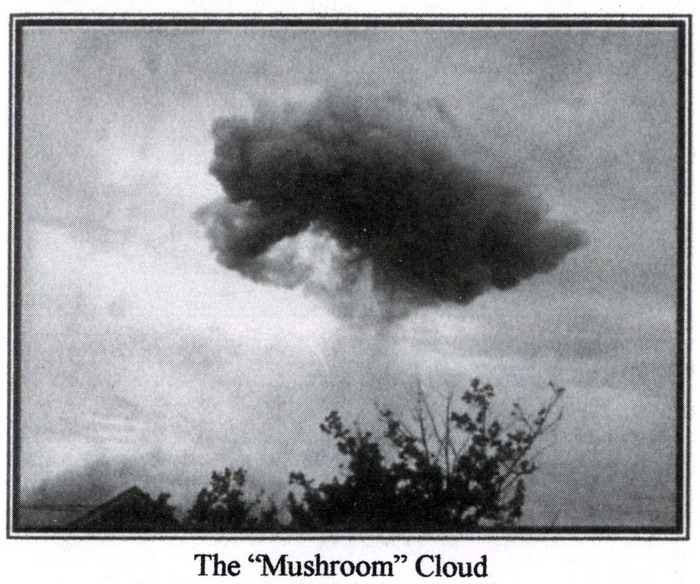

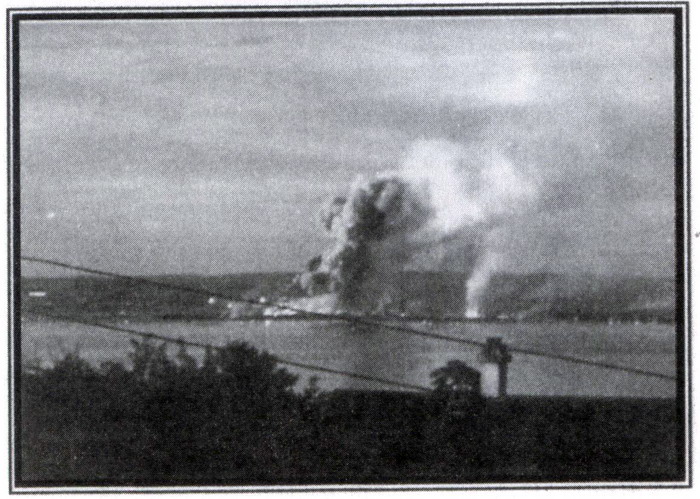
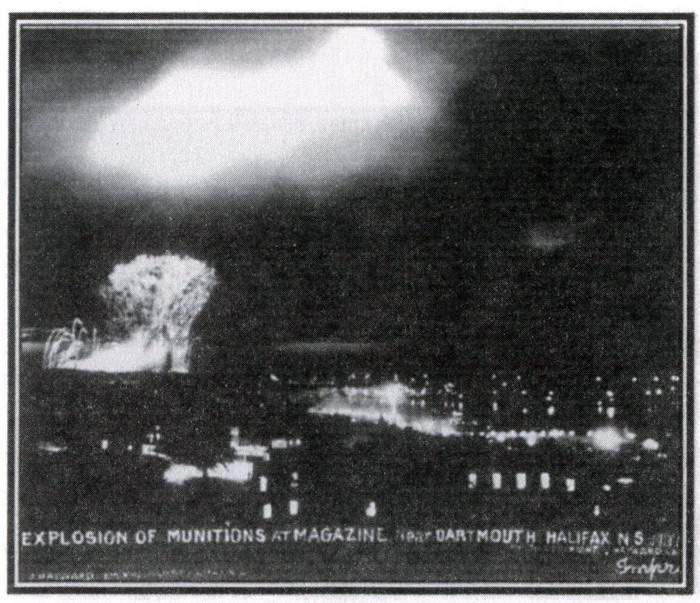
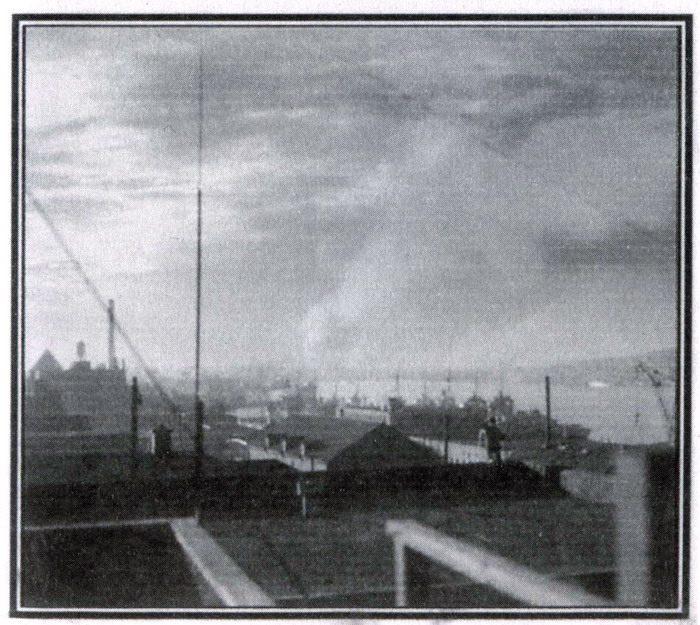


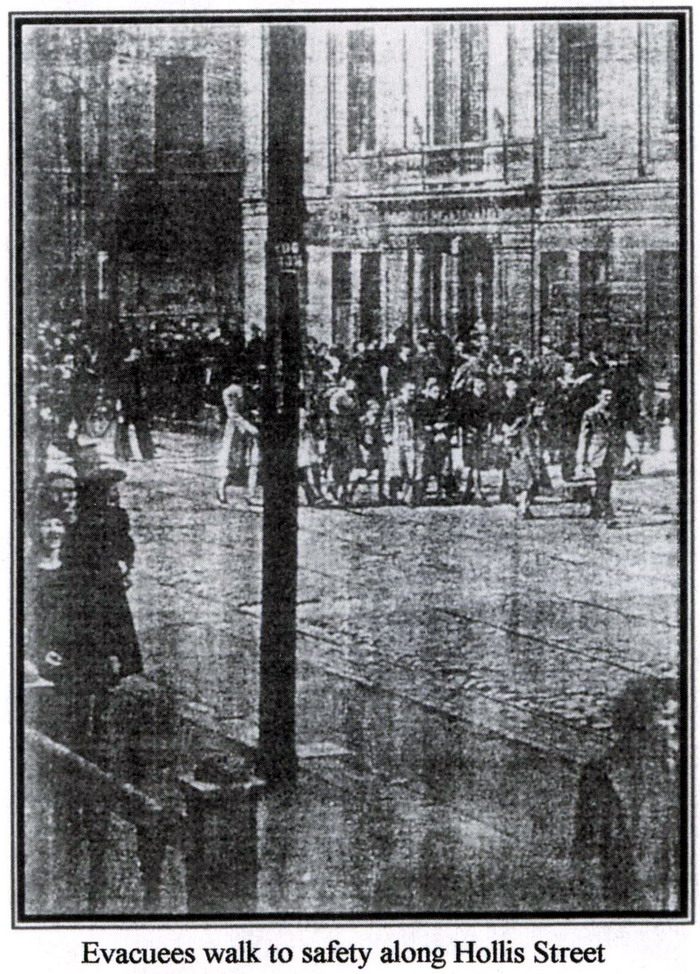

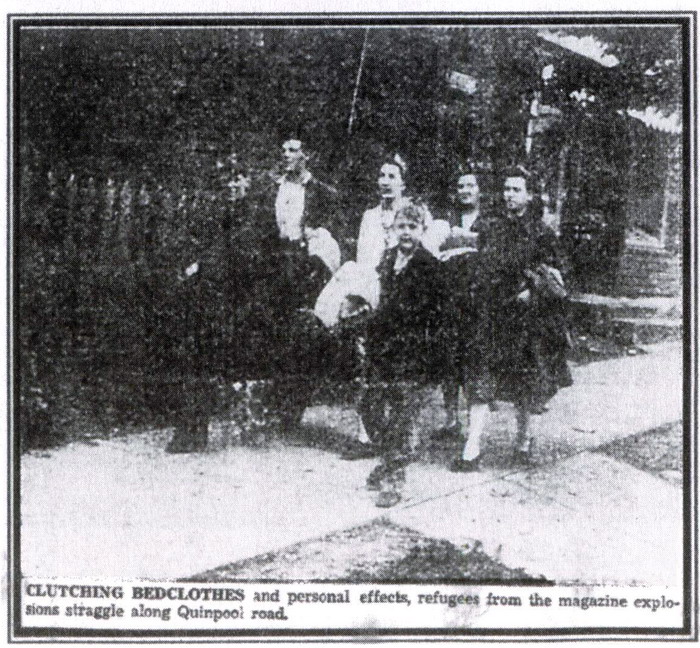
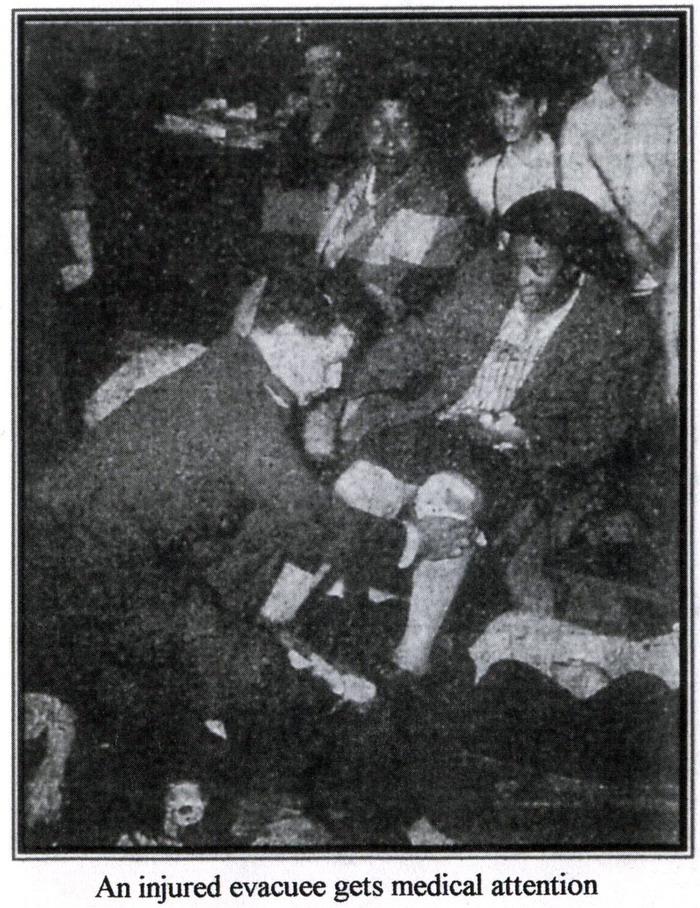

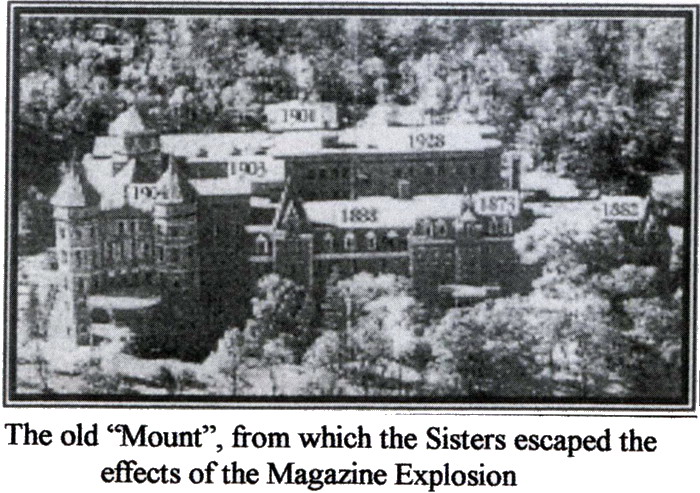
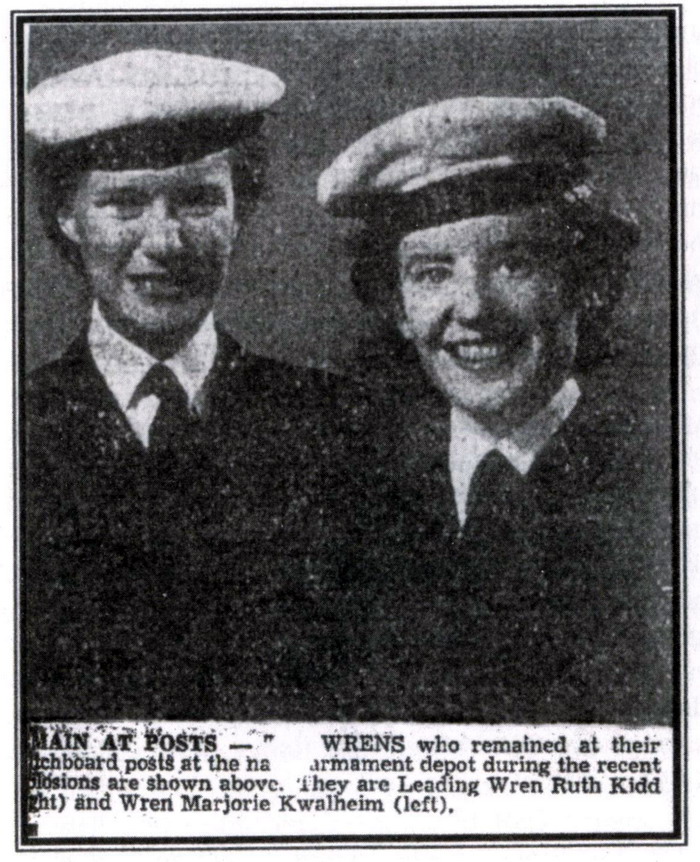
Chapter 3, July
19 Explosions Continue
Huge quantities of ammunition were embarked in ships alongside docks
in Halifax, because it was the only Canadian high explosives export
centre and the single depot for stocks going to Britain during the
war, and later to the Continent.
Thousands of Halifax citizens were aware of this. They did not know
from night to night, how soon or how late a great catastrophe might
occur. The danger was continuous and there was no averting it, but
the City, as a national port, took
this in stride. There was no complaining nor any demand that the
movements of explosives be handled at some other, isolated and less
congested port. lt was looked upon as part of the war effort, and
that Halifax, as a naval and export base, must make its
contribution.
At about 3:30 am on July 19 there was a major explosion which
knocked out nearly all the plate glass on Barrington Street. Those
who saw it said that the preliminary flash lit up the whole
countryside as bright as day. The big Acadia Sugar plant in
Dartmouth had been stuffed full of munitions during the greater part
of the war. It was the possibility this might "go up" that led to
the early evacuation of Dartmouth. This was unlikely because the
plant was about four miles from the Magazine. The only real chance
of an explosion there would be as a result of the Magazine fire from
a heavy concussion, or by being hit by a stray shell.
In The Warden of the North, Thomas Raddall wrote about the
events that frightened all of the citizens of the extended Halifax
area. "The worst explosions came in quick succession about 4:00 am
in the morning of the l9th, rocking buildings, shattering glass, and
tumbling plaster and crockery. The design of the Magazine prevented
the whole thing from going up at once, but there was a particular
store of high level explosives which could level the whole north end
of the city, and naval headquarters continued to warn the remaining
population of a terrific blast yet to come. Still the stoics
remained. The telephone, broadcasting, and power house staffs stayed
at their posts. Household radios, turned on full,
blared through the open windows of a succession of bulletins and
warnings mingled with strains of music. This was the strangest part
of a weird night for those still crouched or lying on the ground."
The explosion was heard 219 miles away in Yarmouth County. Those
calling claimed they heard the noise or experienced the accompanying
concussions of sound from the time of the first blast which shook
the Halifax area. Many within the town limits of Yarmouth itself
heard echoes of violent explosions from late evening, near midnight,
at four in the morning, and later around 6:30 am. The times
coincided with the actual blasts in every detail. It was also
Iearned in Halifax that cloud reflection caused by the fire and
explosions could be seen quite clearly on the highway between Truro
and New Glasgow, and even as far away as Antigonish.
Later in the afternoon on Thursday, July 19, the danger of new and
greater explosions at the Magazine had decreased materially, and
restrictions were relaxed. Rear Admiral G. C. Jones made the
announcement on his return from a personal inspection trip to the
flaming munitions storehouse. This was reported in the Halifax
Mail, which went on to relate that the Firefighters were
believed to have the fire under control. They had been assisted by
the City’s fireboat Rouille which was pumping water to the
buildings along the waterfront at the Magazine, where huge
stocks of high explosives had been letting loose for 18 hours with
only minor let-ups.
On his return from the inspection, Admiral Jones issued the
following statement: "Following an aerial survey of the Bedford
Magazine area early this morning, a rough examination has been made.
Naval fire and patrol parties are controlling the area. It is still
dangerous and must be avoided, except by those on official business.
Rail and bus traffic on the Halifax side has been resumed."
Said one observer, "Admiral Jones went right into it at the height
of the morning explosions. Of course he went down in the mud every
time we did; with the stuff that was flying around. He’s got guts
all right ..."
Compounding the problems, hundreds of tons of unexploded shells,
parachute flares, and ammunition for anti-aircraft guns were thrown
into the ground over a wide area. They were down from five to thirty
feet, and no one knew then how to
move them. Traffic in the area was halted until the roads were
hand-swept for explosives. The explosions had damaged water mains,
adding to the problems of the firefighters.
Although the Navy had cautioned that the fires were very difficult
to control, miraculously by sundown of the following day only minor
bush fires continued to burn. With risk of more explosions
pronounced "small and remote," people began to return to their
homes. But even with assurances from Mayor A.M. Butler, many
remained unconvinced and families camped for one more night.
Haligonians finally discovered that rumors of dead, dying, and
injured had been grossly exaggerated.
On Thursday morning, over 75% of the shops, stores and restaurants
located in the main business section of Barrington Street were
either closed or expecting to close before noon according to a
survey made earlier in the morning. Reasons
given for the closings were mostly lack of staff. Other reasons
however, were broken glass, staff needing rest, and because the
"other fellow" is closing. Practically no restaurants in the main
downtown district were open by 10:00 am, and it was difficult to get
a cup of coffee.
All naval and merchant ships containing explosives were removed from
the danger zone around Bedford Basin to places of safety at the
south part of the Harbour. Corvettes, destroyers, and other naval
craft occupied berths at the mouth
of North West Arm, and behind George’s Island. They remained there
until the danger of further explosions was over.
Most merchant shipping agents had reported they did not consider it
necessary to move ships which not containing explosives. The fire
ship James Battle was standing by at the Halifax Shipyards
along with the smaller Rouille. Cunard White Star reported
that the troop ship Ile de France had left port earlier in
the morning after being cleared the day before.
The stories told by Halifax residents are many. It was not only
those who were in the direct path of the explosion who suffered
injury. One man, eager to gain a better view of the blast, leaned
out of his fourth storey window just as another explosion occurred
and down came the window with the gentleman’s neck still under it. A
Halifax woman was discouraged from standing in open doorways, when
pausing in the front door of her home, another explosion slammed her
door shut, and propelled her down the hall. Another woman was
distraught at the loss of her heirloom china, while her neighbor’s
only casualty was a dozen eggs.
Efforts to revert to normal conditions were readily marked with
surprising results. Weary and fatigued workers pushed ahead to
re-establish home life which had been disturbed with dramatic
suddenness from the disaster. Lack of rest and food did not deter
them from carrying out their work of community service until long
after the regular hours of a working day. The morning and part of
the afternoon of July 19 marked the slack period in comparison to
what followed from the hours of 4 pm to l0 pm. lt was during these
hours that the heaviest part of the important and pressing demands
were handled with success and dispatch. lt was during this period
that things just had to be done. And they were done.
Reports of families stranded overnight in the woods, while deadly
blasts rocked the countryside were investigated first thing Thursday
morning. Investigation unfortunately proved them to be true. One
case involved the parents and their five children, ranging in age
from one to fifteen years. The eldest child of this family was a
girl of fifteen. They belonged to the Tuft’s Cove district. All
during Wednesday night and Thursday morning they feared every moment
they would be hurled to their deaths from the flying of metal or
suffer concussion from the blasts. The plight of the parents and
their family was pitiful and everything was done for them once they
were located. Walter Meridith heard of an ARP group in
North Dartmouth that was the first to discover the case and, with
assistance, had the family removed to comfortable quarters.
Three women and two men paralysed with fright, were found in the
cellar of what was left of their home, one and a half miles from the
centre of the danger zone. When the evacuation of all families in
the area was ordered late Wednesday, these distressed people just
could not muster sufficient courage to leave what they felt was
their only means of protection from the great danger which
surrounded them. So they remained hidden in the cellar of their
home, surrounded by trees and brush.
Excellent news pictures which showed some of the devastation in the
initial explosion at the magazine, were taken by the well-known
Dartmouth photographer, Allen Benjamin. As the explosions occurred,
Benjamin proceeded to the danger area and succeeded in getting
graphic pictures of the scenes of destruction.
Newspapers reported on several "human interest" episodes. A west-end
home, abandoned when windows started to fall in on the occupants,
was invaded by looters, who were foiled in their attempts by a l7
year-old boy brandishing a revolver. Unnoticed by the looters, the
barrel had been removed from the revolver.
Add one female deer to the known casualties of the explosion.
Fleeing in long-legged bounds from the flames and rumbling blasts,
which muttered angrily from the Bedford Basin yesterday, the doe
swam the harbour waters, and entered the Halifax Shipyards. Here it
suffered a broken back when it attempted to jump a ten-foot fence
near the railway tracks in the yards. Yard workers including Ben
Shaw, No. 1 Staff louse, saw the deer kicking in agony, and
mercifully ended
its suffering.
A Buffalo, New York woman, Mrs. Charles McKenzie, visiting Halifax,
and feared to be injured in the blast, had been blinded in the Great
Halifax Explosion of 1917. Her husband appealed to the rationing
board in his city for gas to drive to Halifax, but his request was
denied. She was visiting her father here, but his address could not
be confirmed, and police said they had not been contacted on the
matter. Local telegraph offices said it was possible she received
the telegram from her husband and attempted to reply, but due to the
thousands being sent out at that time, it was possible her reply was
delayed.
Peter Hayes, in the Daily News reported on the "Other
Explosion." The northern portion of Halifax presented a forlorn
sight the following day (July 19). Very few windows were left,
shingles were tom off roofs and houses, and things were generally in
a state of confusion. Some people returned to their homes to find
plaster hanging, wallpaper ripped from the ceilings, brickwork
shattered, and houses looking as though a cyclone had struck."
Buildings, wharves, and sheds had disappeared. There was nothing to
be seen but shreds of charred timbers, gaping craters, and bare
earth. It was the older section of the property which had suffered
the most damage. There the magazines had been separated by only
earthen walls, instead of the concrete blast blocks used in the
adjoining more modem erections. Two wooden piers and probably a
dozen small, scattered ammunition dumps, none more than one storey
high, had disappeared.
Until records were searched, it was impossible to
estimate the quantity of ammunition destroyed, or the value of the
wrecked property. The other two-thirds of the area, containing the
main magazines while suffering some blast damage, was chiefly
intact.
In spite of the devastation and confusion, some interesting events
continued without significant interruption, including a wedding at
St. Mathew’s United Church Thursday evening. During one of the heavy
explosions early on the morning of the l9th, a piece of glass from
the bell tower window severed a coupling pipe in the bellows, but
the couple, not to be outdone, went on with their wedding without
music. Flying Officer Robert Woolsey, was united in marriage with
WREN Helen Rose.
Among the heroes of the night were firefighters from the National
Harbours Board’s fire patrol. Chief James M. Coady, describing the
work of the crews of the two fireboats, James Battle and
Rouille said, "All on board proceeded to the scene at great
personal risk. I feel very proud to be privileged to command a crew
of men who showed so much devotion to duty and who went into that
inferno. I am thankful to Almighty God that they came out again
...... "
The Battle, commanded by Captain Howard Verge with fire crew
commanded by Captain John Zong, and the Rouille controlled by
the Halifax Fire Department and commanded by Captain George Scott,
braved falling shells to work as close to the Magazine as possible
and put out a number of fires raging along the beach area. The next
day, the Rouille cruised along the shore of Bedford Basin, pouring
water on fires and extinguishing them. When civilians were allowed
to return to their homes later in the day, the move was made
possible "because scores of men had run the gravest risks to make
the community safe."
Captain Robinson, with other naval officers and men, stayed on the
scene throughout the night, in and out of the Magazine zone, "trying
to get a picture of what was going on, hopping from jeep to ditch
when discretion demanded it." Captain Robertson spoke later of the
courage of firefighters: naval, civilian, and volunteers. Of one
group he observed, "They took pumps to the top of a hill. Down there
were a lot of four-inch shells; they were popping off and going into
the hill and over the heads of the firemen who were trying to save a
big magazine building loaded with explosives."
The firefighters were standing on top of what turned out to be a
pile of depth charges, 400-500 in all. None exploded. "Then," added
Captain Robertson, "when that building went, we decided to get out.
There was no point staying." They withdrew to a safer place known as
Father Martin’ s Hill. They had a chart of the magazine buildings
and their contents and used this to follow the progress of the fire.
Thirty-five of the Magazine’s buildings were destroyed. "Finally,"
said Capt. Robertson, “when a 14-inch shell landed alongside us, we
got away from there."
The explosions had damaged water mains, adding to the problems of
firefighters. William Sawler, civilian foreman of works, raced to
the Magazine from Sunnyside. "When the pumping station power went
off, he stuck to the job with a gasoline driven pump sending water
down through to the navy’s firefighters in the heart of the
conflagration. Duncan Lynch was with him and when fuel gave out, he
set out afoot for Sunnyside to get more. The authorities would not
let him return and no one could venture in to tell Sawler, who
worked until the pump stopped of its own accord. Then he came out,
not knowing that for hours the mains had been broken and the
500-gallon machines had been driven back long before. The
firefighters had to be ordered out before they would leave."
Chapter
4, July 20 Returning Home, Recollections
As Raddall wrote, behind the announcements that the danger had
largely passed, "There was an epic of heroism and endurance on the
part of the men who for twenty-four hours had been struggling to get
the Magazine fires under control. Chiefly the credit was due to
naval volunteers who dragged fire-fighting equipment to the very
edge of the inferno and remained there throwing themselves to earth
for the greater explosions and working tenaciously at the blaze in
the intervals, in a rain of stones, broken brick, unexploded shells,
and whizzing fragments. As if the dangers were not enough, the
parched woods and brush all about the Magazine caught fire and
burned for two days."
Interestingly enough the results of the explosions were mixed. In
the quarters of the Magazine staff, many window panes were left
intact, yet the heavy ironstone masonry of All Saints Cathedral in
the City’s south end, five miles away, was rocked and severely
cracked. A lighthouse keeper seventy miles away along the coast
reported a strange low rush of air about 4:00 am on the 19th, "as if
a cat had brushed against my legs."
At 6:30 pm on Thursday, July 19, on the advice of Naval Authorities,
Mayor Butler said that all might return with safety to their own
quarters. That finished the exodus, though many lingered through the
evening, finishing up what had
been to the children a great picnic day.
Not so for many of the elders. There was actual suffering. Added to
their anxiety over what was to happen if the reputed 50,000 depth
charges in the main Magazine went up, was the fatigue of the long
treks on foot through the City and along country roads. They spent
the night without sleep and the day was hot and humid. But the good
humour of the crowd on both sides of the Harbour continued, and there
was general appreciation of the work of the volunteers in manning
food
dispensing stations where thousands upon thousands of sandwiches and
cups of coffee were served.
The Mayor felt that there was always an element of danger in the
handling of explosives and this would continue. Amplifying this, a
naval authority said that one further explosion of a minor nature
was possible, but only remotely
possible.
As the body of Henry R. Craig, patrolman, the lone casualty was
brought to the City from the Magazine, life went back to normal in
Halifax. Offices opened, factories resumed operations, services were
restored, and thousands of families picked up where they left off at
6:35 pm in the evening of July 18, many of them well fed for the
first time in a 24 hour period.
Business blocks were boarded up. Cleaners had carted away the bulk
of the broken glass which had strewn the pavements in Halifax and
Dartmouth. What the cost of the blast would amount to had not yet
been estimated, but so far as windows were concerned, more seemed to
have been knocked out than during the V-E Day riots.
The question of reparation was on the minds of citizens. The mayor
reported that on commercial establishments, payment would be depend
on whether or not insurance policies had been taken out by the
owners. Civic property was covered and would call for substantial
payments for schools, as well as churches, which seem to have been
the main sufferers.
One example of "making do" was at the City Market. There the windows
were badly smashed and countrymen and dealers were forced to vend
their wares in the open. Before 7:30 am on July 20, the crowds of
buyers had begun to assemble, grabbing what they could from
partially filled benches. However, grocery stores reopened, and
general food supplies were back to normal. Milk deliveries which had
been called off, were undertaken again, and dairies reported
adequate supplies. The same was true of the bakers.
About half the City went without mail, although because most
businesses were closed, and many people away from their homes, the
inconvenience was not significant. Post Office officials said that
only half the regular work force of letter
carriers showed up for work on Friday morning, July 20.
Although train traffic into and out of the City was suspended during
the series of shattering blasts, little congestion resulted. There
was not much freight moving at the time, and when the "all clear"
was given, traffic was moved with dispatch. The incoming train, the
Ocean Limited, which had been held at Elmsdale Wednesday night, was
finally given permission to enter the City.
Theatres which had advised their audiences to leave after the first
blast on Wednesday, the l8th, remained closed until Friday the 20th.
Major O. R. Crowell, Director of Civil Defence, paid tribute to
co-operation and calmness shown by Halifax citizens to the work of
the Halifax Civil Emergency Corps, and members of the armed forces.
"After four years of intensive training and just when the 6,000
workers were beginning to wonder whether their services would be
needed in a major emergency, the Halifax Civil Emergency Corps had
an opportunity to prove its worth."
All through the night of July 18 and early morning of July 19,
police patrolled the streets, directed traffic, prevented looting,
and performed other duties as required at the moment. Auxiliary fire
groups assembled at their group headquarters. First aid stations and
registration centers were established near the assembly centers and
their locations announced by radio and sound trucks. Temporary
shelters were selected and information on their locations
transmitted to the public.
The Armouries became a source of food, milk, and blankets for the
tired mothers and children who were spending the night on the
Commons. St. John Ambulance women in uniform moved around the
crowds, looking after their comforts, soothing frightened children,
diverting panic, and treating hysteria and shock. At the same time,
First Aid men with the assistance of wardens looked after the male
population in a similar manner, even when all the lights went out.
The Red Cross on short notice served about 25,000 lunches on
Thursday and Friday. The cooperation of dairies, bakeries, and other
food merchants in supplying quantities of food was essential to the
comfort and hunger of the evacuees.
The clergy were quickly on the spot. The senior Protestant Chaplain,
Lieutenant Colonel. H. F. Cox, was one of the first to arrive. Army
officials who accompanied the Padre said he refused to return to a
safer area at Bedford and was responsible for rescuing an injured
Naval rating.
Two Roman Catholic priests were also at the scene. Father John L.
Quinan, Pastor of Saint Thomas Aquinas Church, had stationed himself
as close as military officials would allow him, while Father J .J .
Lanigan, Pastor of Saint Ignatius Church, Bedford, was pictured at
the entrance gate to the Magazine.
Halifax citizens whose explosion fears were lessened by the cheerful
glow of street lamps, owed gratitude to the employees of the Nova
Scotia Light and Power Company who stuck to their posts throughout
the long hours of the various blasts. Street lamps were more
important than house illumination. Mr. Jack Smeltzer of Dartmouth,
operator of the Tufts Cove substation, located dangerously near the
burning ammunition depot, stayed at his station despite the advice
of authorities.
Recollections
Everyone who was in Halifax at the time had a different perspective
of events, particularly as to what each was doing, and what each saw
and heard. Among the civilians who arrived on the scene shortly
after the first explosion, and who
stayed until the next day, was A. Allen Benjamin, a Dartmouth
photographer, who said later, " Fires were burning on the jetty and
at the Magazine when I arrived. The first place I stopped was John
Sawler's, a quarter of a mile from the explosion. The interior of
his home was a shambles. The whole front was blown in and the
veranda was torn off. I saw women and children under a shed in the
yard .... only their heads were showing."
Benjamin went on, "At the main entrance to the Magazine were navy
men placing injured in cars and getting extinguishers. A hill rises
between the north and the south gates of the Magazine, which
apparently acted as a buffer, as the the northern section was not
damaged. The woods in the rear were catching fire, and the Dartmouth
ARP sprayed water on them. Explosions occurred all the time I was
there."
Malachi Jones (now Judge Jones) recalls that it was a very
warm evening on the night of July 18, 1945. At about 5:30 pm he
decided to go for a swim in Bedford Basin near his home at Bathing
House Field. He found the water cold, in spite of the day’s heat, so
he was just wading when the first of the explosions started, minor
at first but then quickly followed by a large one. He immediately
headed for home, up the hill over the railway tracks, and then
across the Bedford Highway.
When he walked up to the Bedford Highway from the beach, he found
cars, jammed bumper to bumper but busses rushing by, leaving people
stranded at scheduled stops.
When Jones arrived home, he found the house shaking as it might have
during an earthquake, although there were no windows broken then and
the family had felt no concussion. However, he could see debris
falling into Bedford Basin, and
the fireworks from the explosion. He quickly changed his clothes,
grabbed a blanket, and climbed the hill behind their house into the
woods. He thinks it was the Quarry Road where he found some shelter
and protection.
Later in the evening Jones climbed aboard a military truck which was
gathering up evacuees, after telling all to leave the area
immediately. He spent the night on the Commons, near Cunard and
Robie Streets. He could hear the sound of crashing glass from stores
on Robie Street, and at times the whole Commons was lit up from the
exploding ammunition. This kept up all during the night, and in the
morning portable toilets and tents were set up to service the
thousands of people who were stranded on the Commons.
In spite of orders, some "old timers" living in shacks in the woods
took it all very calmly They sat on their porches, rocking back and
forth, smoking their pipes, refusing to leave.
David Jones was 17 years old at the time of the explosion,
living with his family in Rockingham. He had made arrangements the
night before to meet a friend, Norm Wright, at Carroll's Store and
Canteen. They intended to catch a bus and go into Halifax to see a
movie. As they waited in front of the store for the 7:40 pm bus they
heard a thump, thump sound, and ran up the hill to see if they could
see better just what was happening. When they realized it was the
Magazine on fire they ran back to the canteen, and got under a
booth, because from the time they were children, they had heard from
their elders that if the Magazine blew up, it would destroy Halifax.
The first big explosion rattled the building and they peered out to
see a huge mushroom-like cloud rising over the Magazine. The bus
came along, but didn’t stop, so David walked home, only to find all
the doors locked, and no one about. For the next several hours he
walked westerly along a series of roads and power lines, meeting
people who were seeking shelter among the trees and rocks above the
Bedford Highway. Some were terrified, others viewed the spectacle
calmly, including two "old timers" who were sitting on a board
nailed to two trees, and who told him they had no intention of going
anywhere.
David eventually returned to his home, got some blankets and a
flashlight, and got on the back of a truck carrying evacuees, on
which he rode as far as the Kearney Lake Road. He walked to Hammonds
Plains from there, and spent the night watching the fireworks. At
4:00 am there was a huge explosion that left
the sky blood red, lighting up the area for miles around. One person
in the group had a portable radio, so they listened to status
reports.
One little episode was rather interesting. As they were riding a
truck on one occasion, they caught up with two youths who were
followed by two bear cubs. Apparently the boys thought they were
just large dogs, but the men who were aboard realized the mother
bear could be nearby, so chased the cubs away. The explosion was
affecting more than humans!
By mid-morning David returned to his home and found that it had
suffered substantial damage, with broken windows, ceiling plaster
cracked and fallen to the floors in a number of rooms. It was truly
a "Night of Terror" with a lot of destruction to homes and other
buildings for miles around the blast site.
A relative of Mrs. David (Marie) Jones, Evelyn Martin, was at the
theater in the Magazine grounds. After she and some friends had
watched a movie for fifteen or twenty minutes the explosions
started, so they immediately got out of the building and headed to
the Dartmouth-Bedford highway. There they were picked up by an uncle
of one of her friends and taken to Lake Major. They stayed up all
night watching the fireworks as was so typical of all the people in
the area. The following day they went on to Musquodoboit Harbour
where they spent the next few days.
On the evening of July 18, 1945 Rube Hornstein, Officer in
Charge of the Eastern Air Command Weather Office was heading for a
Halifax and District baseball game at the Wanderer’s Grounds. He
recalled it was a beautiful warm evening after a hot day, and he was
looking forward to a good game, because the H & D League was
semi-professional, and the baseball was of high quality. Shortly
into the game, Hornstein heard the loud bang of the first explosion,
and then he could see the pillar of smoke. From then on, Ace Foley’s
official announcement of the game was frequently interrupted as he
broadcast orders for service personnel to report for duty.
Coincidently another game was being played at the same time. It was
called in the fifth inning. The Intermediate Baseball game had the
Shipyards ahead of the Armament Depot by 3 to l. Gradually fans
began to drift away, and when the second blast came, umpire Jack
Shipley called the game.
There were rumors of sabotage ..... Germans had landed .... and
other extreme guesses as to what was happening. As the stands
emptied, the H&D game was called off, and Hornstein began to walk
home. At the time, he was living at the comer of Robie and Morris
Streets, diagonally opposite the fire hall. He could see people with
blankets making a spot for themselves on the grass in the median
between the north and south running streets. His own home was
undamaged, so after getting the real story of the blasts, he went to
bed. About 3:00 am, another big blast awoke him He thought he
smelled gas, which was then in general use for cook stoves,
including his own. Hornstein ran across the street to the fire
station, and a fireman came back with him to check the source of the
odour.
It turned out that the blast had snuffed out the pilot light on his
stove, and gas was flowing out into the house. The problem was soon
corrected, but if he hadn’t awakened, the consequences might well
have been serious.
On the technical side, Hornstein saved a barograph tracing of the
night’s activities, which showed a sharp dip down and then an
equally sharp wave up at the times of the major explosions.
Mrs. Peter (Patsy) MacNeil was at the same ball game. She and
a friend made their way to Citadel Hill, curled up in the grass, and
watched the activities going on across the Basin. Later in the
evening, they went to a friend’s house on Queen Street, and spent
the rest of the night under their dining room table.
Don Tremaine was a teenager, living in Rockingham in July,
1945. His home was just across Bedford Basin from the Magazine. His
mother was at a church supper, so he and his sister were in the
process of making sandwiches for
themselves when they heard a peculiar popping sound. Tremaine went
up stairs to. see if he could see what was happening, when there was
a huge bang, and the window blew in on him. He was not hurt, but not
unexpectedly, a little excited, and when his mother arrived home,
having seen the mushroom cloud of smoke, he was relieved to have her
there with them. For a while they all sat out on the lawn to watch
the "fireworks", but then realizing the potential danger,
headed for the hill behind their house where they found a sheltered
spot in the woods. From the hill they could still see the explosion
site, and watched with awe as the tracers flew overhead.
Later in the evening came the command from a bull horn, "Anyone in
the woods will have to be evacuated." About midnight the Tremaines
boarded an open truck and were taken to the Halifax Commons where
thousands of evacuees had already assembled. No one was sleeping,
and there was much speculation as to what might happen. There was
another large blast, and to make matters worse, it started to
sprinkle rain, so as many as possible squeezed into the Armories.
There they lined up for doughnuts and drinks, but about 4:00 am
there was another huge blast, and the lights went out. An hysterical
woman started to scream, so a number of attendees quickly took her
in hand, and eventually got her calmed down. The main concern was
that it might precipitate a panic, which of course could have been
extremely serious.
Close to dawn, Tremaine and his mother and sister started walking
down Quinpool Road. All around them they could hear and see glass
storefronts and house windows come crashing down. It was still a
very scary sight. They went to the home of an aunt and uncle on
Churchill Drive where they had breakfast. About noon on July 19
after it seemed safe, Tremaines grandfather arrived to take them
home in his car. There they found nine broken windows, the front
door blown in, and plaster down in the ceiling of the front room.
Eventually compensation was received for the damage. With cheques in
hand, some homeowners purchased new cars, which became known as
"Explosion Cars". Tremaine also remembers some "old timers" refused
to move, staying with their homes, in spite of all the orders and
instructions intended to hasten their evacuation.
Maxwell Barnes, a former boiler maker at the Halifax
Shipyards, had just returned from work when the explosions began. "I
went out to the store on Gottingen Street to buy some things for
supper. I was in the store and there was a tremendous explosion."
Barnes ran home and saw his Leaman Street house had been badly
damaged by shock waves triggered by the explosion several miles
away. "The cellar door was a thick door, a heavy door, and it was
rolled up like a roll of toilet paper and
it was across the cellar. And the big, main beam in the cellar had
moved sideways half an inch and plaster in the front room was
cracked. I don’t think any of the windows were broken, but the back
door was smashed in."
"Every once in a while there was a minor explosion. You couldn’t
sleep you know. Scared to death. Then all of a sudden at four
o’clock the depth charges or something caught fire and I thought the
house was coming down. The big glass
chandelier was swinging back and forth, and the plaster cracked and
ran down inside the walls."
"My kids started to scream so my wife and myself threw ourselves on
top of them to keep them quiet," he said.
Russell Harkness of Amherst was interviewed by the Halifax
Chronicle Herald’s Amherst Bureau and was quoted on his memories. "A
bunch of the guys were out back of the Provost Corps barracks on
Cogswell Street playing horseshoes, when there was this loud
explosion around 6:30 pm. At the same time we could see this large
mushroom-like cloud. It was a very dark, black cloud with a tail. It
drifted high in the sky and stayed there a long time. We all stood
there for a moment wondering what was happening."
Harkness, then 25 and a member of the Canadian Provost Corps, soon
learned the magazine had caught fire and was exploding. Around the
same time Harkness’s horseshoe game was interrupted, his wife
Gwynne’s uncle, Arthur Patton, was relaxing on the back porch
of his Quinpool Road home when he heard the explosion. A
photography buff, he raced inside, found his camera and ran back to
the porch in time to photograph the cloud.
"Bullets were flying into the sky for much of the night. A lot of
them were tracer bullets, and as a result you could see them clearly
and they were going everywhere. At times it was just like fireworks,
very pretty."
Harkness spent much of the night driving evacuees to the Halifax
Commons, which became a tent city. He particularly recalls the fate
of one downtown store. "Its big front windows were blown in. It was
the third time the windows had been
damaged that year. The first time happened when one of our van’s
brakes didn’t work while going down the hill. It ended up going
through the window. The second time was during the VE Day riots."
In the Halifax Nova Scotia, Saturday, July 13, 1985, Anne-Rockwell
Fairley wrote about her vivid memories of the Bedford Magazine
Explosion. She was riding her bicycle down Chebucto Road, when a
large thunderclap threw her off balance, and she landed on the
pavement. Immediately people rushed from their homes, shouting, "it
must be the Magazine!" Everyone assumed the worst.
Sisters Mary Martin, Ellen Keller, and Cecelia Rooney of the
Sisters of Charity, remembered vividly the evening of the explosion.
All were at the "old" Mount Saint Vincent (destroyed by fire in
1951) where summer classes were being held, and a retreat was in
progress. At the time of the first blast, Sister Keller was on the
way to the lavatory to wash her hands, when suddenly the windows
blew in on her. She swiftly departed the building and headed up hill
to what was known as the "second farm." As they waited for
instructions or news, Naval trucks arrived on the scene, and took
the group to Saint Mary’s Basilica. She recalled they slept on
benches, and had strawberries for breakfast!
Sister Rooney had a similar story. She was teaching novices, and was
walking along a corridor parallel to the Bedford Highway when the
library windows blew in. She immediately went to the back of the
corridor only to discover a young girl
lying prostrate on the floor. It turned out she had only fainted
from fright, but it gave the others a scare for a moment. As there
was a farm up the hill from the Mount, the farm manager led a number
of them out of range of any possible
explosive activity. Other people from Rockingham soon joined them,
and they stayed deep in the woods all night. Some of the Rockingham
men were veterans, and were able to give advice on how each could
protect herself: "lie face down on the ground, open mouths, and
cover ears."
Sister Mary Martin was a novice at the time, and when the first
blast hit, they were evacuated from the building, and instructed to
go up the hill. They were eventually picked up by Naval trucks and
transported to Saint Mary’s Basilica,
where they remained for two nights. The rumors were not encouraging,
persistently being circulated that the next blast may be the last
one...in other words the City would be levelled. She and her fellow
novices slept on benches in the basement, and were fed by Sisters
from Saint Mary's Convent which was one of the few that didn’t have
to be evacuated. Others, such as St. Patrick’s, St. Joseph’s, and
Home of the Guardian Angel were all abandoned, as was the orphanage
on Quinpool Road. They returned to the Mount in the morning of the
20th, also to begin the clean up, which took weeks.
The next day the Rockingham infants, huddled in the woods with their
mothers, were in need of nourishment so Mr. Campbell went down to
the farm and brought back milk and light snacks. As the day wore on
(Thursday, July l9) they felt more secure and ventured back down the
hill to the farm, where they were fed and housed. The Rockingham men
ventured out periodically and came back with reports of the
explosions. It was the only source of news they had. Late in
the afternoon, it seemed safe enough to return to their homes.
Peter Richards (now Judge Richards) related his experience in
the Chronicle-Herald, July 19, l99l. He began, "I was staying
at our summer camp in Burnside. I guess we called it a ‘camp’ since
it had no running water or inside plumbing. With me was my sister
and her infant son, and their dog, Bingo. My father and mother who
normally stayed at the camp in the summer, had gone to Halifax to
entertain friends at a dinner party. Burnside was not, as now, a
bustling industrial park. It was "country" with a few permanent
residences and a large number of summer cottagers. Our camp was to
the north of the SF (Semper Fidelis) grounds on a knoll overlooking
the Cove and Navy Island. It commanded a good view of the entire
area. The DND (Department of National Defence) Magazine was, and
remains today, the explosives and ammunition storage facility for
the armed services. The more dangerous material was stored in
underground bunkers and, during the war, was transferred to the
waiting ships in Halifax Harbour and Bedford Basin by steel-hulled
barges. Magazine security was entrusted to members of the Veteran’s
Guard, men who had served in World War I, and were either too old or
medically ineligible for service in World War II."
"Members of the Guard were housed in barracks located outside the
Magazine gates. As part of the guard complex there was a recreation
building at which movies were held weekly. The veterans graciously
permitted ‘cottage kids’ and other residents of the area to enjoy
the movies with them."
"On this day (July 18) the movie was scheduled to start at 7:00 pm.
After an early supper I left the camp to head for the movie. I met a
friend on the road, and we walked the half mile to the veteran’s
barracks. We arrived in good time, took our
seats, and waited patiently for the show to begin. Shortly before
seven o’clock, 6:35 to be precise, the serenity was shattered and
the assembled moviegoers were terrified by an ear-splitting blast of
indescribable intensity. The rec hall shuddered and shook, shards of
glass flew wildly about, all combining to create an air of
pandemonium. We quickly found our way to the outside, instinctively
sensing that the trembling wood frame structure presented more
danger than
protection."
"Once outside, I vividly recall looking skyward and seeing a huge
and ominous mushroom cap of dust and cloud with what appeared to be
giant light bulbs spouting from it. I noticed my friend was bleeding
somewhat freely as a result of the flying glass, and he noticed the
same about me. I recall busying ourselves with picking the glass
shards and fragments from each other’s hair, neck, face, and arms.
The cuts, although bleeding profusely, were quite superficial. They
did give us the appearance of casualties, which further intensified
our feelings of adventure and foreboding. Adding to the rapidly
unfolding drama were the constant popping and the ominous sounds of
machine gun fire. I assume this resulted from exploding ammunition
which had become overheated."
Albert Mackie, a member of the Guard, counted himself the luckiest
man in Canada. He escaped unhurt although six-inch shells were
whizzing by all around him. A heavy jagged base plug from a shell
plummeted through the roof of the sentry box in which he had been
standing moments before. "I was on duty at No. 3 jetty about 100
yards from the explosion, " Mackie said. "First I heard two or three
little explosions and about two minutes later the whole thing went
up. The
concussion knocked me flat, but I picked myself up with the idea of
getting to a fire alarm. I tried to ring two, but both were knocked
out of order."
"By this time shells were going off all over the place. Five inch
shells were whizzing by me, some landing on the asphalt road and
others going over my head. Some shells landed point first and on
their sides by the road bed, many of them driven practically out of
sight. I didn’t know which way to turn. Everywhere I looked were
dumps of ammunition, and I didn’t know when they would go up. All
around the place I saw buildings flattened. I remember seeing two
sailors running toward the jetty when the first little blasts went
off, then I saw them running back. I don’t know what happened to
them after that."
Chapter 5,
Outside Help, Correspondence
The Ottawa Journal said that, "Halifax deserves
the most support possible from this country: its contribution to
victory in Europe is literally beyond computation. For its people,
suffering this new blow, there will be widespread sympathy, and a
desire to help them in every possible way. For whatever damage was
done, the government is responsible and no doubt the government will
put its great resources immediately at the disposal of the harassed
citizens of the Atlantic Port."
Under the heading, "Honor is due", the Montreal Gazette, picturing
the "anxieties and suffering experienced at that time in Halifax,"
suggested that this new misadventure brought forcefully to mind what
the people of Halifax have endured in two World Wars.
The Ottawa Citizen, expressing thankfulness that the casualties
caused by the Naval Magazine explosions had been so few, and
visualizing what must have been for the inhabitants "a most
unpleasant night," expressed the hope that Halifax, "which has come
in for some rough usage at the hand of fate in recent years, may
henceforth be spared."
The Globe and Mail, Toronto, noted that "the ancient City of Halifax
has some reason to count itself a child of misfortune, considering
the recent V-E Day goings-on, as well as the great tragedy which
took place in l9l7."
Under the heading, "Guardian of the Gate" the Herald Tribune
of New York printed the following editorial: "During the two great
wars, Halifax has stood guard at the approaches to the North
American continent. The navies and merchant marines of the world
filled her magnificent harbour; much of the wealth
of the west in men and materials, has flowed through the port to
stem on distant battlefields the threat of aggression and tyranny.
The old fort crowning Citadel Hill has been a symbol for Canadians
and Americans alike of common resolve and common action."
"The enemy did not come to Halifax. But this City has paid dearly
for its proud and dangerous role. For this, Canada and the United
States can join in congratulating Halifax and Dartmouth, while
paying a tribute of respect to the guardians of their Atlantic
gate."
As soon as news of the Magazine Explosion was broadcast to the
outside world, offers of help came from far and wide. Food was
rushed into Halifax from Nova Scotia towns. As reported by the
Halifax Mail on July 20, from Bridgewater, came Mayor E. J. Learman,
Chief of Police Donald Oikle, and L. H. Corkum, with some 3,000
sandwiches and 75 gallons of coffee, prepared by the citizens of the
South Shore town. The food was turned over to the Red Cross for
distribution.
Over 200 sandwiches were forwarded to the City from Windsor, also
prepared by the citizens of the Town. Telegrams of eagerness to help
were received from the mayor of Pictou, who volunteered to furnish
housing and to make arrangements
to feed 1,000 persons. From Mayor Donald Macleod of New Glasgow came
an offer of "all assistance in New Glasgow’s power, while Mayor R.
T. Forbes expressed the sympathy of Fredericton and urged Halifax
not to hesitate to ask for any help needed."
The Red Cross reported over 20,000 evacuated persons were given food
throughout the organization. During the day over 100 pounds of
coffee were purchased and distributed. Also thousands of gallons of
milk for the children, and over 2,000 loaves of bread were purchased
by the Red Cross to feed the
tired refugees.
The Salvation Army under Majors C. Lynch, and Pedlar, served some
3,000 persons on the Commons, at the Dingle, and on the Gorsebrook
Golf Club grounds. They were assisted by Betty Muir and Millie
Tucker, and worked throughout the night of July 18, and during the
day of July 19. The group also
served coffee and sandwiches to ARP (Air Raid Protection) wardens
and the soldier-sailor personnel on duty in the North End, while the
big explosions were at their height.
The Saint John Ambulance Brigade, under Lady Provincial
Superintendent, Mrs. Guy Little, OBE, was on duty with a strength of
70 workers. They operated in four sections of the City after the
first big blast, and later moved to the Armouries,
where they administered first aid, and assisted the Red Cross in
supplying food to the hundreds there. The Brigade group supplied
food on its own during the early part of the night, and operated an
ambulance and staff car from that centre. Many who suffered cuts
from flying glass were treated by the workers.
Major O. R. Crowell, Director of Civilian Defence, expressed
appreciation for the valuable services rendered by thousands of
volunteer workers in the Halifax Civilian Defence Emergency Corps.
Appreciation was also expressed to the Army, Navy, and Air Force for
their cooperation. Major Crowell cited the Army’s prompt response to
help when they quickly supplied several thousand blankets and made
available the use of the Armories and its staff, who rendered
valuable assistance.
Letters were received and exchanged from a variety of sources, some
expressing concern over payments or conditions, others offering
assistance and support. Offers were received from Toronto and Saint
John, which were prepared to send a mobile canteen. The authorities
declined the offer when a survey revealed there were ample food
supplies and facilities on hand. Official appreciation was expressed
to the two cities.
From Brooklyn, New York, a man offered to provide glass and men to
install it. The mayor of Halifax, Allan Butler, thanked the man for
his generous offer, but explained that there was sufficient glass in
the City to make the necessary repairs. Transcripts of some typical
correspondence follow:
July 20, 1945
His Worship Mayor E. G. Leaman
Bridgewater
Nova Scotia
Dear Mayor Leaman:
May I on behalf of the City Council and the citizens of Halifax
express to you the people of Bridgewater our very great thanks for
the tangible assistance you brought to our City yesterday. This took
the form of sandwiches and coffee and other foodstuff and the
distribution of it in the areas where evacuation had to be ordered
was something which brought forth the thanks and appreciation of the
people who were the recipients of your generosity.
Bridgewater because of its solid proof of friendship will mean
something special in the future to the people of Halifax as they
journey there.
Yours very sincerely,
A.M. Butler. MAYOR
July 20, I 945
His Worship Mayor Ira B. Lohnes
Windsor
Nova Scotia
Dear Mayor Lohnes:
I am anxious to write you early this morning, now that the people of
Halifax realize the danger which threatened them is over, to voice
the thanks of its citizens to you and the people of Windsor for the
tangible proof of generosity shown yesterday.
You prepared and brought to us an abundant supply of sandwiches and
other food and this assistance, when it was finally distributed to
the people played a most important part in restoring them to normal.
All during the day their nerves were taut and apprehensions were
many. The food supply was scanty and in their homes which they had
evacuated there was practically nothing to eat.
You may be assured that in acting in the generous way you did you
gave us cause to remember the people of Windsor in a very special
way.
On behalf of the people of Halifax I extend formal thanks.
Yours very sincerely,
A. M. Butler
MAYOR
July 20, I 945
His Worship Mayor H.F. Harper
Town of Pictou
Nova Scotia
Dear Mayor Harper:
I acknowledge your telegram of July 19th which did not come to my
attention until this morning, not through fault of the Telegraph
Company, but simply due to the fact that I was not in my office at
all yesterday.
May I express on behalf of the people of this City our gratitude for
your generous offer to house and feed so many of our citizens.
As you now know the danger appears to be over and I think it is safe
to say it is over and therefore we shall not have to avail ourselves
of your generosity. Let me, however, convey to you and the people of
Pictou our warmest thanks and appreciation for what you stood ready
to do for us.
Yours very sincerely,
A. M. Butler
MAYOR
July 20, 1945
Vice-Admiral G. C. Jones, C. B.
Commander-in-Chief Canadian North West Atlantic
HMCS Stadacona
Halifax, NS
Dear Admiral Jones:
As mayor of the City I should like to request that the City of
Halifax be permitted to send a representative to the Naval Court of
Inquiry which you propose holding in connection with the explosion
at the Bedford Magazine. The representative I have in mind would be
entitled only to watch the proceedings and not participate in them,
unless, of course, such permission would also be granted.
Perhaps the regulations are such that representation by a municipal
corporation is precluded but because of the fact that the Bedford
Magazine is not merely an outgrowth of the war but a permanent
establishment for the peace time activities of the navy as well as
wartime, I am of the opinion that the public interest of the
citizens of Halifax is such that a representative of theirs should
attend.
Would you be good enough to give this request consideration and let
me know if it is within your authority to grant it.
Yours very truly,
A. M. Butler
MAYOR
July 20, 1945
His Worship Mayor Ray T. Forbes
Fredericton
New Brunswick
Dear Mayor Forbes:
The telegram you sent me offering help came to my attention this
morning. Yesterday was a busy day and all efforts were directed
elsewhere.
Would you please convey to the citizens of Fredericton and its City
Council the thanks I extend to you on behalf of the citizens of
Halifax for your sympathy and the offer of help which you expressed
in the wire.
Fortunately, it will not be necessary to avail ourselves of your
offer as the situation in Halifax appears to be over with everything
secure again. Nevertheless we are grateful and I
am prompt to express the thanks and appreciation of our citizens for
help you stood prepared to give us.
Yours very sincerely,
A. M. Butler
MAYOR
July 23, 1945
Vice-Admiral G. C. Jones, C.
B.
Commander in Chief Canadian North West Atlantic
HMCS Stadacona
Halifax, NS
Dear Admiral Jones:
Reports have just come in to me from the Chief of Police that cases
of explosives have drifted to the shores of Bedford Basin on the
western side in the vicinity of Africville and locations north of
that point.
I would request that some action be taken by the Naval Authorities
to patrol the shore daily in order to collect any such explosives
that are still afloat. I would also suggest that a patrol of the
waters should be maintained with the object of removing any
explosives seen moving about. It is important to do everything
possible to prevent them getting into the hands of the public who
have still failed to appreciate the danger which might result from
their being handled.
Would you be good enough to advise me if you will be in a position
to meet my request.
Yours very truly,
A. M. Butler
MAYOR
16 Regina Terrace
Halifax, NS
July 24th, 1945
A. M. Butler, Esq.
Mayor of the City of Halifax
Nova Scotia
Dear Mr. Mayor:
In this morning’s "Chronicle " your references to the explosion
situation last Wednesday-Thursday were read with deep interest and
entire concurrence.
As one citizen of this area, may I ask you to put on foot,
preferably through one of our Members, a Campaign to have the
Magazine removed elsewhere.
To the best of my belief such action was taken in England by the
City of London as regards Woolwich Arsenal in 1937, to the great
mental comfort of that City ’s inhabitants.
Yours faithfully
(Signed) Mr. H. Churchill-Smith
July 25, 1945
Mr. H. Churchill-Smith
16 Regina Terrace
Halifax, NS
Dear Sir:
I am in receipt of your letter of July 24th and note with interest
your comments on the removal of the Bedford Magazine to some point
which will offer security and comfort to the people of Halifax.
Your letter will be kept on file and when the matter is discussed in
future it will give me an opportunity to consider the point of view
you now express.
Yours very truly,
A. M. Butler
MAYOR
Halifax, NS
July 26th, 1945
Dear Sir:
Would you please tell me what is going to be done about the damage
caused by the explosion to property. I have a house at 99 Maitland
St. The tenant was down to see me. The plaster is down, the windows
broken, the doors are out of place, and the chimney is cracked.
Please see about it as soon as you can.
Oblige
Honora V. Killeen
297 Brunswick St.
July 28, 1945
Mrs. Honora V. Killeen
297 Brunswick St.
Halifax, NS
Dear Mrs. Killeen:
In reply to your letter of July 26th, it would appear from an
official announcement at Ottawa that full payment of all claims will
be made to a point and will include the value of the losses you
sustained.
It will be some few days until an announcement is made as to how it
is to be paid, but I would suggest that anything that needs repair
urgently and cannot wait, that it be dealt with and the invoices
showing the expense carefully kept and later filed.
Yours very truly,
A. M. Butler
MAYOR


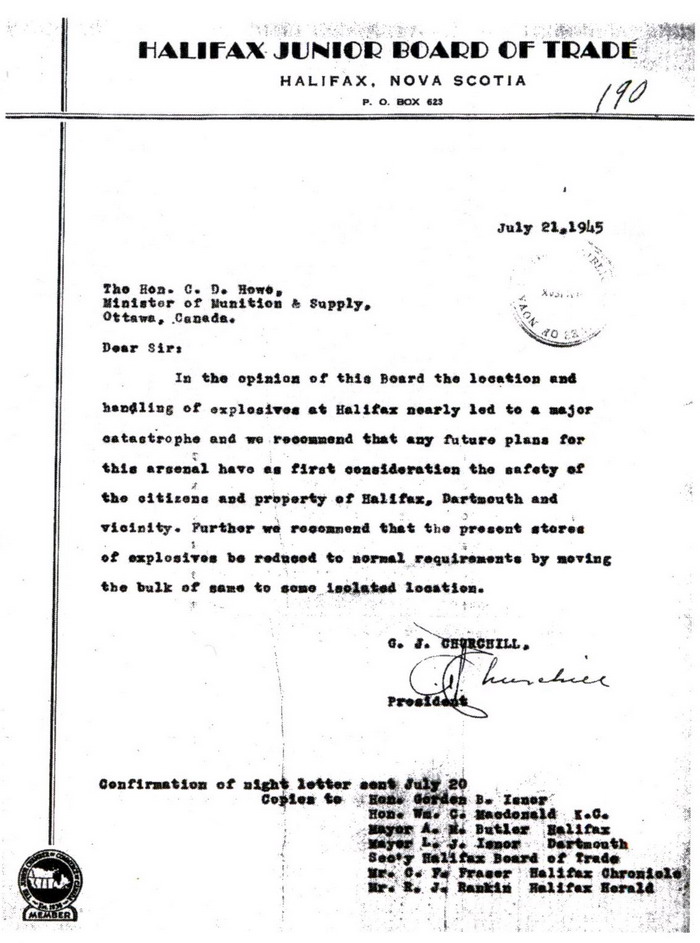

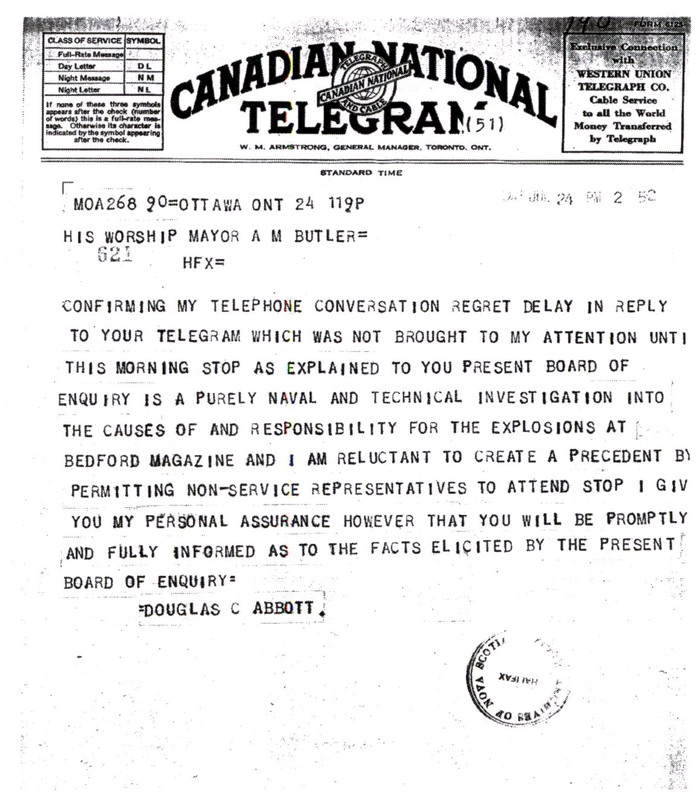

Chapter 6,
Aftermath
An editorial in the Halifax Mail, July 20, 1945 expressed the
feelings of the entire populace of Halifax: "The tens of
thousands of people in the Halifax Harbour area endured a
night of terrors and alarms, and yesterday long agonizing
hours of fear and anxiety, knowing not the minute that might
bring an explosion far greater than those shattering blasts that
had gone before."
"It was a dreadful experience, particularly for the women and
children, the aged and infirm, the bed-ridden invalids, for
veritable armies of citizens driven from their homes onto the
roads, into the fields, fleeing before a menace the proportions
of which were to them beyond calculation. The terrific blasts
were in themselves appalling enough, but what racked nerves
and tortured minds was the haunting uncertainty, the living
from minute to minute, hour to hour expecting the next
second to produce the cataclysm. It is natural therefore, for
the citizens of this community on the shores of Halifax
Harbour to be asking questions: what caused it? And, could it
have been avoided?"
"We are bound, of course, to proceed on the assumption that
in its original design and construction the Bedford Basin
magazine was laid out and built in conformity with well
defined plans and principles; that safety was the dominating
factor. As all with knowledge and experience in these matters
will affirm, there are well-defined plans and established
principles in relation to the establishment of such ammunition
depots in proximity to large populated areas. And we are
bound, as we say, to assume that Safety was the dominating
factor in such design and construction. How then did it
happen? And could it have been prevented?"
"lt had been no secret to the public, within and outside this
community, that the de-commissioning of service ships had
been proceeding at a rapid rate on this coast. Merchant ships
also had been in-process of being stripped of their armament
and ammunition. Does the answer lie there?"
"With the war in Europe ended, with ships being de-commissioned, has ‘loose’ ammunition accumulated at a rate that
entrenched upon safety? Did ammunition dumps grow up
in the Bedford depot to the extent that they overtaxed the
facilities of the establishment, and thus compromised
established safety procedures? We do not know. But we do
know that these questions are in the public mind today."
"In that item from the New York Herald Tribune, headlined,
‘Guardian of the Gate’ the reporter praised the citizens,
‘Haligonians are a tough breed,’ he wrote. Not many would
disagree."
"It is announced from Ottawa by Capt. Harry DeWolfe,
assistant chief of the naval staff that there would be an
immediate investigation into the causes of this holocaust and
the circumstances surrounding it. The purpose of such an
investigation is, obviously, to determine the facts as a guide
and a guard for the future."
As far as the Bedford Magazine was concerned, the older
portion had been badly damaged; 90-foot craters in some
cases were all that remained of some of the storehouses.
Magazine sections that had been built during the war had
been damaged, but much of their ammunition and explosives
remained intact. There was criticism of the rapid
de-commissioning of navy ships and armed merchant ships
which had led to the vast supplies of explosives being stored
at the Magazine.
First estimates of the damage were about $500,000 in Halifax
and at least $100,000 in Dartmouth. It was also announced
that businessmen and householders would be reimbursed
from the federal government’s War Risk Insurance fund for
explosion damage. Under the fund, householders were
covered to the extent of $3,000, whether premiums had been
paid or not. In the end, substantially more, about $4,000,000
was paid in compensation, and all claims were settled within
three years.
On the whole, the people acted calmly and without panic or
hysteria. They were admirable under conditions of peril and
mental anguish. Moreover, they were disposed to await a
disclosure of the facts before passing judgement. It was the
position of citizens who, having looked Death and
Destruction in the face, were capable of restrained attitudes
and an honest desire to know the truth. It was hoped the Naval
Court of Inquiry, which opened in camera, (preparing a report
for presentation to Ottawa) would find out.
There was no one on the jetty at the time of the first
explosion. As previously noted, the one man who saw the
fire’s early flickering, and went down to see, was killed.
Others were at the shore and escaped injury when crackling,
not much louder than that of rifle fire, started. From the jetty
area flames spread to depth charges, four-inch ammunition,
rockets, flares, and the like, which had been left on the jetty
by an corvette "de-ammunitioned" the day of the blast.
Magazine workers who walked and climbed over the boxes to
get transportation to their homes wanted to know all the facts
too, and in the evening of July 21 considered the situation.
One of the resolutions approved by Local 148 of the
Dockyard unions said: "From our own experience .... that the
general conditions which brought about the explosions were
wholly due to the overstocking of the total Magazine area and
jetties through too rapid de-ammunition of the
de-commissioning of the naval ships since V-E Day"
In the Penalties of War, Historic Halifax, W. C. Borrett wrote
about the explosion and described the conditions in the City
during and after the initial blast. As he noted, "Haligonians,
who had been evacuated from their homes to country villages
twenty and thirty miles away, never expected to find any of
their City left standing when they returned in the next day or
two. As the explosions became less and less, and by 6:30
Thursday evening (July 19), just 24 hours after the first blast,
it was officially announced that the main danger had passed,
and that while more explosions might be expected, they
would not cause any significant damage as the fire was dying
down and had practically burned itself out."
Haligonians gradually began the trek back to their homes, and
for the second time in two months, the stores had to replace
their plate- glass windows. It was a terrifying experience,
wrote Borrett, and citizens should congratulate themselves on
how well they came out of what might have been a very
serious situation.
The authorities reminded citizens that they should not go
wandering around the Magazine area, and if anyone should
come across an unexploded shell, it should be left alone. They
were also reminded not to go souvenir hunting but to leave
salvage activities to the men who knew what they were doing.
The Provost Corps or Ordinance Depot men would be the
ones to remove any stray shells in the woods, and people
could help most by staying at home, or at their regular places
of employment.
Also, the July 21 edition of the Halifax Mail reminded hikers:
"If you’re walking along the shores of Bedford Basin and find
a box or case which has floated ashore, don’t touch it! It may
contain quantities of high explosives. Just such boxes have
already been found, police said last night, one of them
containing 10 sticks of high explosives weighing 12 pounds.
Reports have also been received of children bringing home
what appeared to be detonators. All such materials, Deputy
Chief George Fox said last night, have been turned over to
Naval authorities for disposition."
A serious problem was posed by scavengers. The casings that
contained explosives were largely made of brass and any man
or woman who cared to collect them could earn twenty cents
a pound from any local scrap dealer. Unfortunately it was very
difficult to determine if a shell were still dangerous. Even the
Crown Assets Disposal Corporation, which only disposed of
casings certified "danger free" received an irate phone call
from one unfortunate scrap dealer, who claimed that his
furnace had been blown up by one of these "danger free"
shells. If the experts were having such a tough time, one can
imagine how accurate were the observations of untrained
civilians.
The scavengers were to be found not only on land. Ambitious
scuba divers, it was later learned, swam beneath the South
Jetty, and made off with as much material as they could
handle. Clearance problems were staggering. Ammunition
was washed ashore on the nearby beaches with regularity, and
on land some of the shells were buried in the ground. In 1960
some cartridge cases were discovered that were filled with
cordite propellant. Although they had been submerged for
fifteen years, the resulting tests showed that the ammunition
was just as good, if not better, than anything available at that
time. It is a misconception that explosives are de-activated
when submerged.
Edgar Kelly, editor of the Halifax Herald and the Halifax
Mail wrote an editorial entitled "Their Part" .... "And now a
word for this community and its citizens - this community or
group of communities that ring the perimeter of the Halifax
Harbour area and lie within range of the menace of vast
quantities of explosives stored or in transit."
"The City of Halifax itself, the Town of Dartmouth,
Woodside, Imperoyal, Eastern Passage, Tufts Cove, Burnside,
Bedford, Millview, Prince’s Lodge, Birch Cove, Rockingham,
Fairview, Armdale, Melville Cove, Jollimore ..... these are
some of the communities of the greater Halifax area whose
citizens, to use the words of the Mayor of Halifax, have
displayed such ‘steadfastness in the face of danger’, not this
week alone, but constantly during the war years."
"Passing through long hours of terrors and alarms, the citizens
of this port community have been magnificent .... men, women,
and children, old and young, the sick and the well, the aged
and the infirm. There has been no panic, no hysteria. Here the
people knew, as one writer has put it, ‘probably better than
the residents of any other city in the Western Hemisphere’
what the danger was and what measures had to be taken to cut
down destruction and loss of life. To quote a Canadian Press
news story in comment on the threat under which the citizens
of this community ‘had been living for the last six years’."
W. C. Borrett’s The Penalties of War mentions at least twice
during that time the threat of an explosion was extra close.
Once a burning freighter containing ammunition was sunk by
shellfire in the harbour, and on another occasion a blazing
ammunition ship was towed safely to sea, passing close to the
heart of Halifax before it reached open water.
Halifax’s radio station CHNS kept on the air throughout the
hectic period. Their periodic broadcasts on the progress of
the north-end calamity were instrumental in quieting the fears
of the entire populace. The staff there worked without rest for
twenty-four hours, squelching rumors of impending blasts and
bringing up-to-date information to their great listening public.
These "explosion" broadcasts probably contributed more to
relieving the minds of the harassed public of Halifax and
Dartmouth than any other means of communication.
The total claims ran into the millions of dollars, which upon
verification, were presented and honored by the government,
all claims being settled within three years.
The Maritime Command’s publication Trident, of August 9,
1978, looked back on the impressiveness of the cleanup
operations. The same skill and efficiency that the Navy had
used in controlling the blasts were put to use to clean up the
damage. Surrounding woods were scoured for live and dead
shells and the sea was dredged to a foot below the deepest
explosive discovered. Divers worked for five years gathering
ammunition, lifting it on to flat barges, towing it to sea, and
dumping it.
No one has yet put forward a really satisfactory explanation
of why the explosion occurred, although obviously the extent
of the blast was due to the overstocking of the Magazine.
Many theories were advanced before the Naval Magazine was
identified as the source. An airplane had passed over the City
just moments before the blast, and many believed the aircraft
had exploded. Others believed the shock came from the
Dockyard, and others still, remembering the disaster of 1917
were sure another ammunitions ship had blown up.
And yet, ironically, the disaster overcame the bad public image of the Navy following the V-E Day riots which had
taken place two months earlier. The work done by naval
volunteers reached heroic proportions. They fought the blaze
for 24 hours, often being hurled to the ground by repeated
blasts. They laboured under a constant barrage of shells,
stones, broken brick, and other flying debris. Haligonians
soon realized that it was because of the valiant efforts of naval
personnel that their city had been spared more extensive
damage.
Soon after the dangers from the Magazine explosion were
well under control, a meeting was held in the council
chambers at Halifax city hall under the sponsorship of the
Halifax North aldermen. Mayor A. M. Butler disclosed he had
attempted to obtain civic representation at the Navy’s
investigation into the Magazine’s blasts, but his request had
been denied. He was told the inquiry dealt largely with
technical matters and was "somewhat over our heads." The
meeting, called to consider measures to be taken as a result of
the explosion, also heard that all citizens, whether their
claims for damage were small or large, should be
appropriately compensated.
A suggestion was advanced that the munitions storehouse
should be transferred at least 25 miles from the City to
remove the menace of explosions similar to that which had
shaken the city on the night of July 18.
Reverend W.W. Clarkson, rector of St. Mark’s Church,
declared that the Magazine must be removed, pointing out
that "people in Halifax have been living in subconscious fear
during the war years. We want to know that they will remove
this menace altogether from the City of Halifax," he declared
amid applause.
Reverend C.F. Curren, pastor of St. Joseph’s Church,
declared it was only through God’s intervention that loss of
life had not been heavier He urged that the government be
petitioned to have the Magazine moved 25 miles away.
A.M. McKay, representing the Board of Trade, said two things
should be done: First, citizens should be recompensed, and
second, the "menace under which Halifax has lived for six
years should be removed."
Although the explosions had subsided and the fires put out,
the dangers to the public were not yet over. The military and
the police were expending much of their efforts protecting the
public from harm. Many of the shells were not only still alive,
but they were buried close to the surface of the ground, where
some unsuspecting individual might easily take his last step.
The surrounding woods were full of 4 inch shells, many of
which had lost their protective caps. Signs were quickly
erected that said, "GOVERNMENT PROPERTY.
TRESPASSERS WILL BE FIRED UPON WITHOUT WARNING." One set of parents called authorities in to look
at something their small son had dragged home behind his
wagon. It was a 4 inch shell, and it was still very much alive.
In a delayed aftermath nearly two months later, when at 4:30
p.m. on Wednesday, September l2, 1945, an explosion
occurred aboard a gasoline powered harbour craft, berthed on
the south side of the north jetty at the Bedford Magazine.
Gasoline was showered on the water within a few feet of
barges loaded with ammunition. Fears were renewed for a
third Halifax Explosion.
Three barges, loaded with hundreds of tons of damaged,
unexploded ammunition, were less than forty feet from the
naval harbour craft. A cache of 3,000 depth charges was about
300 yards behind the flaming boat, and a number of war
heads, mines, and 14 inch shells, were less than 100 yards
from it.
One naval rating, a member of the crew of the craft, was
hurled into the water as a result of the blast, but was hauled to
safety by civilian workers. The rating suffered bums about his
body. Approximately 260 civilian workers and a few naval
personnel were engaged in work in the arsenal at the time.
The harbour craft, known as H. C. 20, was sent from the
Dockyard to pick up a bomb disposal officer, Lieutenant.
Rollo, who was at the Magazine. It docked shortly before 4:30
p.m., and as Rollo was proceeding down the jetty to board the
craft, two naval ratings started the motor. It was then the
explosion occurred. Gasoline from the craft spread all about
the area, and flames shot as high as forty feet in the air from
the blazing boat.
Two workers, engaged in demolition work on a barge less
than forty feet away, cut the tow line of the craft, and
attempted to beach her north of the jetty. Then naval
firefighters assisted by civilians, worked strenuously to
prevent spread of the flames to another of the nearby barges.
Naval authorities reported the fire aboard the boat was
completely out by 6:00p.m. Nevertheless, with the explosion
of July 18 so recently in the minds of naval and civilian
personnel, the scare of this event was enough to bring a sigh
of relief when it was brought under control.

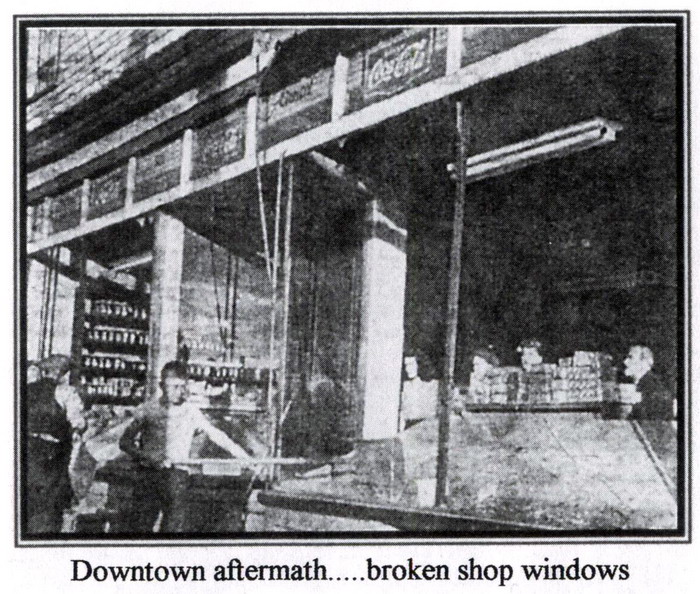
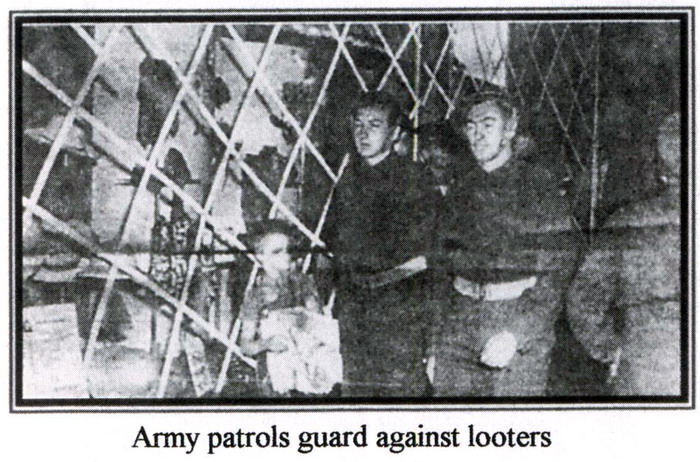

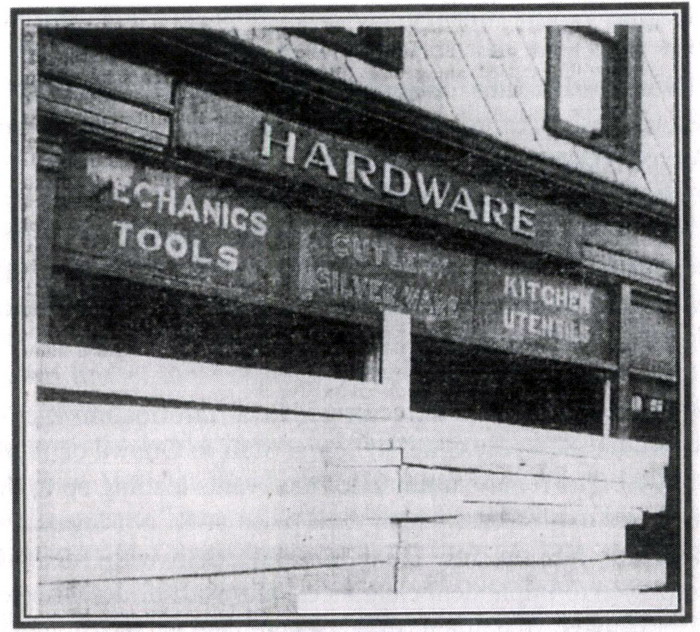
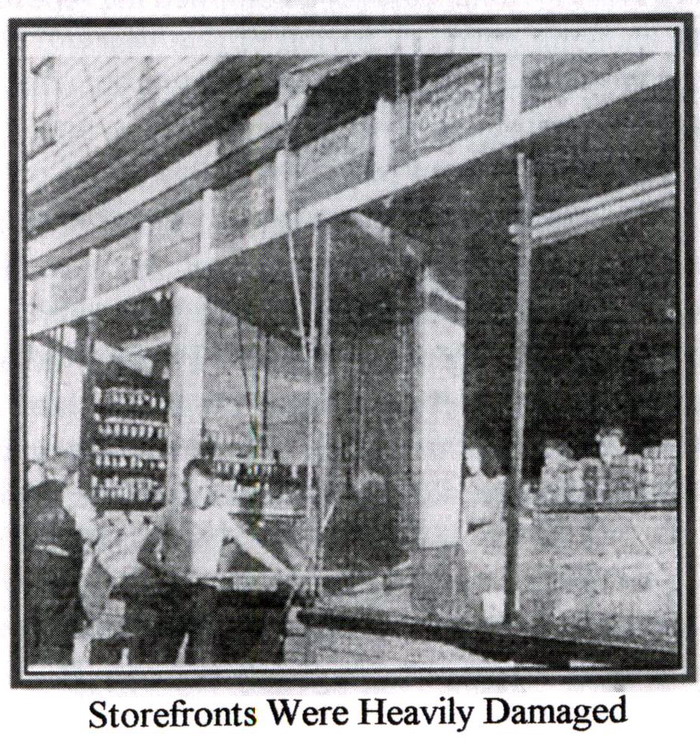
Chapter 7, The Inquiry
"Events Leading up to the 1945 Explosion at RCN
Magazines, Bedford, NS and the Clearance of Devastated
Areas." (Dated April 3, 1946).
This chapter presents a condensation of the Inquiry,
conducted following the explosions at the Bedford Magazine,
with some deletions, amendments, and interpretations, which
do not alter the conclusions.
William Strange, the Director of Naval Information filed a
report to the Deputy Chief of Naval Staff in Ottawa on April
3, 1946. The report summarizes the events leading up to the
fires and explosions, which took place at RCN Magazines,
Bedford, NS on July 18, 1945, together with methods
employed to implement clearance. The Staff of the Director
General of Naval Ordnance, RCN, compiled the report, which
relates to happenings over a period of five years.
The Site
Firstly, the report delineated the general location of the site
which was approximately two-thirds of the way between
Dartmouth and Bedford. It extended from the water’s edge to
the highway connecting the two towns. Property adjacent to
the Magazine was sparsely settled, although the shore around
Navy Island Cove was used as a summer resort, and many
camps were scattered along the southern shore line of the
cove.
Across the Basin were houses of a more permanent nature,
scattered the full extent of the highway between Bedford and
Halifax. The Magazine is located approximately four miles
from the center of Halifax, three miles to Africville, with
Dartmouth four miles to the south, and Bedford two miles to
the north.
The Magazine area extended along the shore of Bedford
Basin one and one-quarter miles and inland a distance of
approximately one-quarter to one-half mile. It was
completely surrounded by a security fence, enclosing
everything other than six official residences, three jetties, a
pump house, the Veteran’s Guard Barracks, and an empty
warehouse. The south area of the Magazine was
comparatively old, having been turned over to the Canadian
Navy in 1941, at which time the north area was completed
and occupied. The area was developed originally from a farm
owned by H. Curran Inglewood.
Buildings in the south area were constructed generally with
concrete foundations, tile and brick veneer walls, and wooden
peak roofs, although some had flat, precast concrete roofs.
The terrain, which sloped downward from north to south,
permitted buildings to be placed in rows at different levels, with
one roof overlooking the roof of another.
Due to the terrible catastrophe at Halifax in 1917, when some
1600 people were killed and thousands were injured by the
exploding of a freighter carrying bulk high explosives, the
general populace of the entire area was very explosive
conscious. When this emergency arouse, people acted
promptly and exactly as directed. When the authorities
decided to evacuate the northern end of the City and the
complete Town of Dartmouth, the residents immediately left
their homes and proceeded to open areas and the adjacent
countryside. Even without being instructed to leave, people
started to evacuate these sections and the ease with which Air
Raid Precaution Wardens, who were deputized police,
performed their duties was an important factor as to the
extremely low number of casualties. During the time the
explosions were occurring, it was feared 22 persons had been
killed and 12 injured, although when missing people re-appeared, this figure was reduced to one killed and l2 injured.
From the time of the initial explosion until noon the following
day, the entire population of Halifax and Dartmouth was
warned to stay outdoors and 1,700 people had been evacuated
from their homes. In addition to this figure, an untold number
of residents were directed to vacate from Bedford and along
the west shore of Bedford Basin. Nuns and summer students
of Mount St. Vincent were among this group.
Operations
The Magazine received stores by both water and rail.
Deliveries by rail were accommodated by two spur lines, with
platforms built along one side of the rails. There were two
jetties, the North Jetty, "L" shaped, was initially used for the
de-ammunitioning of ships and receipt of stores, while the
South Jetty was used for the issuance of munitions to HMC
ships. Each jetty held sheds, including a hose house, with
water being supplied from Anderson Lake, three-quarters of
a mile to the north-east. For fire fighting purposes, a six-inch
pump had been installed, to make use of salt water.
Magazine staff consisted of two main departments: Stores and
Laboratories. During the latter months of 1944 some five
hundred men and women were employed at the establishment.
In early 1945, due to rapid personnel turnover, it was
necessary to augment the civilian staff with varying numbers
of naval ratings, used primarily to drive trucks, and
occasionally for the handling of munitions.
During the period immediately prior to the cessation of
hostilities in Europe, and for the period subsequent to V-E
Day, the return of ammunition from warships, merchant ships,
and other depots increased considerably. These demands
served to accentuate the already overtaxed capacity of
magazine facilities. Steps were taken to remedy the situation
but due to various reasons, there were, on July 18, 1945, as
great, but not appreciably greater, quantities of explosives in
the Magazine area as on any other previous occasion.
Records reveal that during the period May 1 to July 18, 1945,
a total of 83 ships, among which were 12 destroyers, the rest
mainly frigates and corvettes, were de-ammunitioned at the
Magazine. The manner in which most ammunition was
returned from ships, as well as the condition of some stores,
left much to be desired from the aspect of safety procedures.
Explosive stores were landed, accepted, and stored in
contravention of regulations. The landing of large quantities
of unboxed cartridges in particular led to a potential hazard.
In addition, considerable quantities of depth charges were
stowed in outside storage dumps. A number of lighters and
barges were nearly always moored alongside the receiving
jetty. Serviceable ammunition was removed to one general
area, while repairable items usually found their way to two
large dumps, and this type of storage practically nullified any
safety distance provisions.
Because of the congestion, and with staff unable to cope with
the overwhelming quantities of ammunition being returned,
much of it without proper packaging, each jetty usually
contained some hundreds of tons of mixed ammunition. This
was the situation prior to the initial explosion.
From what can be ascertained, the fire started at
approximately 6:40 PM on July 18, 1945 at the extreme
north-west corner of the South Jetty. Smoke and sparks were
seen to be rising from this comer of the jetty, followed almost
immediately by an explosion. Fragments and burning
propellants were thrown over an area of approximately four
hundred yards by this initial blast, spreading fires through the
underbrush and piles of boxes along the shore adjacent to the
jetty. A series of minor explosions followed which were
attributed to small quantities of ammunition around the
buildings located near the wharf. It was noted that with the
first blast, which was extremely heavy, many of the roofs of
the old type magazine buildings had collapsed, leaving only
the roof trusses remaining.
A patrolman, Henry R. Craig, on duty at the South Jetty was
killed instantly in the first blast while a member of the
Veteran’s Guard received wounds from shell fragments, but
managed to make his way out to the South Gate from whence
he was sent for treatment. No action could be taken to cope
with the spreading fires in the South Area by way of the South
Gate so all fire fighting forces were sent to the North Gate and
subsequently despatched down through the upper area.
Road blocks were erected about five hundred yards north and
south of each of the two entrances leading to the Depot from
Highway 7, while a party was rushed to the rail siding to lay
out hose lines and stand by in the event of fires starting in or
around the loading platforms which were laden with
ammunition. To ensure water supply, the Clerk of Works
stood by the pumps at Anderson Lake throughout the night
and fire boats were sent from the Dockyard, but proved of
little value, due to the heavy blasts and amount of debris
flying through the air. All communications had been disrupted
completely and it was necessary to install an R/T set in the
North Gate Guardhouse, which became the temporary
headquarters.
Fairly heavy explosions occurred regularly until almost
midnight, when a very heavy detonation took place. The crew
which had been unloading the lighter of its cargo of explosives
had knocked off for supper just before the initial blast and to
this fact they owed their lives. The barge and jetty to which it
was tied, were blown to bits.
Two-Man Bucket Brigade Brave Death at Magazine
A weary naval official who said he was, but a spectator, told
how two courageous naval ratings, armed only with buckets,
braved imminent death Wednesday night as with shells
bursting around them they tried to prevent spread of flames
which followed explosions in the Bedford Basin ammunition
depot.
The officer was Lt. V. L. Coade, Livingstone Place,
Halifax, while one of the ratings was Shore Patrolman A.
Hill, of Ontario. Name of his companion in the hopeless fight
against the fire could not be determined. With Surgeon Lt.
Cdr. Lemuel Prowse, of Charlottetown, Surgeon Lt. W.
Tidmarsh of HMCS Algonquin, and three Sick Bay
attendants, Lt. Coade was among the first to reach the blast
scene after the first heavy shock at 6:35 pm.
Hill and the unknown rating were included in naval personnel who
fought the rapidly-spreading fire, despite the danger of
injury or death, until ordered from the area when officials
decided it was no longer tenable.
Buildings were blowing up around the two ratings as they
tried, with buckets of water, to stem the flow of the flames,
said Lt. Coade, Medical Stores Officer for the Atlantic coast.
"I was skirting around looking for casualties, and was really
the only spectator", he related. "But the medical officers
Prowse and Tidmarsh, went in beside the ratings and took
them out. Hill had a bleeding wrist and the other fellow was
suffering from shock."
Recalling the events of the hectic night, Coade said he and the
two doctors sped to the scene, shortly after the initial severe
shock, in the "Moby Dick", the Admiral’s barge which was
the only immediate fast vessel available to them in the
Dockyard. With them they took a chest of emergency
medical equipment, including morphine syrettes, in
expectation of heavy casualties. "When we got to where the
jetty was before the explosion, there was nothing but small
bits of wood floating in the water," he recounted. "The cove
was thick with the wreckage. We landed at a concrete jetty
still standing further down the cove."
Carrying their medical supplies, the officers and the sick bay
attendants with them proceeded towards the explosion area
searching for casualties. "On the way, shells were flying all
around us," said Coade. "We could judge where the big ones
bursting in the air would land, but there was no telling what
the smaller ones would do."
Before they arrived at the heart of the blazing area the party
could see naval firefighters swinging into action against the
blaze, the officer added. "Apparently there was little water
pressure after the first blast," Coade said. "We passed at least
one navy pumper and went toward the flames looking for
casualties. When we got near we saw two naval ratings in the
center of the fire, with buildings going up all around them,
trying to put out the fire with only three buckets in which they
were carrying water."
Coade continued, "Prowse and Tidmarsh went in along side
of them, while I skirted around looking for casualties. I saw
them down in a hollow and then everything started to pop and
I threw myself into some bushes until things quieted down.
Then I started back towards the roadway. On the way I met a
sailor and a member of the Veteran’s Guard trying to get to
the road. We had to walk backwards with our eyes on the
stuff falling from the shells exploding in the air. We could
hear other stuff shooting by us."
"Just as we got to the road I noticed a large black puff of
smoke rising from the ammunition sheds area. It turned red
and orange as it rose and I threw myself flat before another
blast shook the ground. Coade remarked that when things
stopped falling he made his way between blasts to the gate
leading into the magazine area, where more fire apparatus
had been gathered. A small hose wagon entered the danger
area to remove Prowse, Tidmarsh, and the two sailors. When
Prowse came back he was all in, the officer recalled. "He had
on a new uniform which had been ripped where something
tore through it."
Later Surgeon-Lieutenant Prowse related he and Tidmarsh
went within 30 to 45 yards of where the first blast occurred in
order to evacuate the fire-fighting ratings. Tidmarsh told
Coade to give Bell a shot of morphine before he started to
leave the zone. "We were about half-way to Bedford when we
met a padre. He had a faster car, so we transferred the ratings
into his care and he took them to hospital."
The three officers and the sick bay attendants with them were
in the danger zone for more than an hour. It was nearly
midnight before Prowse returned to Halifax on a fire truck.
Reports were received that the first blast was felt 27 miles
away, and that plate glass windows were shattered or pulled
from frames in the most southerly extremities of the City.
Low lying areas in Halifax felt the effects of the first blast
more than higher sections as the detonation waves were
transmitted from water level. The northern portion of Halifax
presented a forlorn sight the day after the explosion. Very few
windows were left, shingles were torn off roofs, and houses,
signs and telephone poles were broken, leaving lines hanging.
The northern ends of both Halifax and Dartmouth were
evacuated as well as Bedford, because of the heavy
explosions. By July 19 the explosions had diminished and it
appeared that the major ones had passed and that the
remainder of the Magazine could be saved.
The Naval inquiry went on to document the chain of events
that took place at the Magazine. In the morning of July 19
extremely heavy explosions were felt at 1:00, 2:00, and 4:00
am, while cartridges, the majority of which were four inch,
exploded intermittently well into the day. The heavier
detonations were apparently caused by a concentration of
depth charges and 250 pound aerial bombs, depth charges,
and stacks of "Squids" respectively.
The Captain of the Dockyard, utilizing the two other services,
employees of the Magazine, and all fire fighting equipment
available, personally directed all phases of the fire fighting.
The whole area along the Dartmouth-Bedford Highway was
ordered to be cleared, and in this the Army and Air Force
rendered valuable assistance. The northern ends of both
Halifax and Dartmouth were evacuated as well as Bedford,
because of the heavy explosions. By July 19 the explosions
had diminished in volume and strength and it appeared
feasible to suppose that the major explosions had passed and
that the remainder of the Magazine could be saved.
The contours of the land between the older area and the new
undoubtedly prevented complete destruction of the entire
Magazine. This is evidenced by a pile of approximately 800
depth charges lying just over the brow of the hill being
disturbed by the blast, but otherwise not harmed in any way.
On Thursday night (July 19), fires were noted in the densely
wooded area east of the Railway siding, and trucks were used
to clear the loading platforms of exposed ammunition.
Portable pumpers were brought in to use along with backpacks
and with the aid of nearly two hundred Naval Ratings from
the Dockyard, the fires were brought under control by the end
of the following week. Fire patrols were continued both at the
railway siding and inside the Area until the end of the month,
at which time all danger of fire recurring was considered
remote, but due to the nature of the country, a sharp vigil was
maintained.
At 4:00 am on July 19, a flash lit up the sky like high noon.
Seconds later, a vicious explosion erupted from the Magazine,
blowing out windows, ripping doors off hinges, and levelling
trees. The throngs sleeping on Citadel Hill and in parks were
shaken violently awake.
Military officials warned the worst could be yet to come.
A huge stock of depth charges, one estimate said as many as
50,000, each weighing 180 kilograms, was in the path of the
fire. A munitions expert warned, "If those depth charges had
all gone up together, it would devastate things for miles
around."
The Naval Inquiry indicates that low lying areas in Halifax
felt the effects of the first blast more than higher sections, as
the detonation waves were transmitted from water level and
the greatest impact was felt along the western shore of
Bedford Basin at low levels. Africville and areas along the
south-east side of the City were hit hardest, although the
outward force ricocheted along the streets of Halifax and
Dartmouth. The vacuum caused by this particular explosion
appeared more serious than the blast shocks, as windows
which withstood the shock were pulled from their frames and
smashed on the street.
By July 19 very few windows were left, shingles were tom off
the roofs of houses, signs and telephone poles were broken,
leaving lines hanging. Things were generally in a complete
state of confusion. When some people finally returned to their
homes they found plaster hanging, wall paper ripped from the
ceilings and walls, clothing strewn around, dishes smashed,
brick work shattered, and houses looking as though a cyclone
had struck.
Land contours supplied a natural buffer for the Town of
Dartmouth and Village of Bedford, and very little damage
was caused to either of these areas, with only a few chimneys
and some plaster cracked by the concussion of the four larger
explosions. Here too, people accepted damage in a more-or-less matter-of-fact manner.
The Director of Naval Services Report of April 4, 1946
catalogued the events that led up to the Magazine being
returned to usable condition. On Saturday, July 21, three days
after the original explosions, a meeting was held by Naval
officials to discuss requirements and steps to be taken in order
that the Magazine could be put back on a working basis.
It was decided that the first steps to be taken would be the
closing off of the broken water mains and the erection of a
stand pipe. This would enable all the lines to retain full
pressure in case of any further emergency. The Nova Scotia
Light and Power Company was to be contacted for the
reinstallation of their pole lines, as these had been blown flat
almost the whole length of the Magazine along the highway.
A temporary communication line was to be installed at once.
Danger signs were to be prepared and placed in strategic
positions along the main highway and the fence repaired. A
security patrol was also considered necessary in addition to
the routine fire patrol. A pass system was devised whereby
only authorized personnel could have access to the areas
where live ammunition was scattered about. Clearance of
brush was considered of high priority. Heavy equipment,
jeeps, and pick-ups were to be provided by Motor Transport
as required. Approval had been received to ship any stores
surplus to stowage facilities at Renous, NB, and as certain
large items still remained in outside stowage, it was deemed
necessary to begin shipments immediately.
A dumping program had been inaugurated as soon as the
North Jetty became serviceable, and from then on scows were
dispatched to sea at the rate of two a week. These scows
averaged one hundred and fifty tons of ammunition per load
but did not prove nearly as satisfactory as the frigates, which were
used later. During the period from July 18 to October 1
approximately twenty-two hundred tons of ammunition were
transported to sea and dumped.
Hundreds of Navy and Army personnel worked for five years
to clear the magazine of buried munitions. Tonnes of
munitions were dumped at sea, and one man was lost while
unloading a barge off the coast. Some men were paid "danger
money" at the rate of 25 cents per hour for digging armor
piercing aerial bombs, torpedoes, depth charges, 40mm Bofor
ammunition and hand grenades from the rubble.
Compared with the Halifax Explosion of 1917 that claimed
more than 1,600 lives, casualties at the Bedford Magazine
explosion were remarkably light. The magazine was remote
from dwellings, and explosions detonated in succession
instead of all at once.
Organization of Bomb Disposal Personnel
The next item on the agenda was to dispose of any active
ammunition or armaments. It was decided to enlist the
services of a Bomb Disposal Officer who was fully trained in
the handling of explosive objects. Naval ratings were
available at HMCS Cornwallis, and Royal Canadian
Engineers stationed at Debert, NS could be called upon to
give assistance, so 100 of these men were employed. Army
personnel arrived the Monday morning following the
explosions, being billeted at the Naval Armament Depot,
Dartmouth, and were used during the first part of the week to
clear roadways. When the Naval Ratings arrived later in the
week, it was considered the organization of the clearance
body was complete.
In view of the condition of the remains of the South Jetty,
along with the fact that ammunition once stored there had
been blown into the water rather than exploding or burning,
it was decided that clearance of this section would be
necessary also. The Mine Disposal Officer, a qualified diver,
was appointed to these duties and he and a staff of fourteen,
four of whom were divers, accepted the difficult task of
implementing all underwater clearance.
Clearance of Land Areas Outside the Magazine
The land outside the Magazine area itself also had to be
cleared. Ammunition from the South Area was scattered
throughout an undetermined area. So as not to overlook any
portion, plots were delineated, ten yards square, and one
hundred plots constituted a grid.
It is of interest to note that the possibility of using Polish
Mine Detectors was considered, but the ore content of the
rocks and stones on the site was sufficient to continually
attract the detector, and buried objects could not be
overlooked. A visual inspection was the only practical
alternative. The heavy undergrowth made it imperative to exercise extreme care to avoid tramping over explosives.
The operation was successfully and safely completed between
July 23 and July 29, in spite of the discovery of numerous
explosive objects, particularly adjacent to the Depot’s railway
siding. It is also of interest to note that a four hundred pound
squid projectile was encountered 450 yards beyond the siding,
with no visible damage, having travelled a distance of over a
mile.
The grids within which the Dartmouth-Bedford Highway ran
were swept by the search crews four times and, much to
everyone’s disappointment, a fourth sweep findings were as
numerous as during the first search. Through lack of bush
training, the Naval Ratings were having considerable trouble
crawling over rocks, and instead of maintaining position
would walk around obstacles instead of over them.
Consequently Army and Navy personnel were mixed rather
than separated into uniforce units, and the results were
immediately deemed an improvement.
Owing to the nature of the terrain, the heavy undergrowth, the
fact that some people were not as observant as others and that
this search was entirely visual, it was impossible to declare
these sections free from explosive materials. Nevertheless
authorities were satisfied that the clearance was as thorough
and as complete as it could be made under the circumstances.
Clearance of Waters and Shores of Bedford Basin
Directly after the explosions, the waters of Bedford Basin
were literally covered with floating debris. It was thought that
amongst this floating rubble detonator cylinders and possibly
shells, which had been fired into logs and timbers would be
found. A trip aboard a harbour craft was made throughout the
Basin on the Monday following the explosions, and from the
articles sighted it was very obvious that clearance of some
means would be necessary.
The water was cleared by suspending a hundred foot line
between two harbour craft, with floats tied every five feet along
the line to hold it on the surface, and by sweeping the entire
Basin in this manner, most of the floating objects were
recovered.
After clearance of the waters had been completed, which took
two weeks, one craft with a crew of four was anchored at the
Narrows to watch for objects which might float in and out
with the tides. The remainder of the search party, with the
harbour craft, searched and cleared the foreshores of Bedford
Basin. Suitable equipment was supplied and orders given that
everything along the shore be moved to allow a thorough
search. Logs and timbers were to be rolled over and debris to
be shifted. Difficulties were experienced in sheltered shallow
coves where the craft could not proceed and where debris
remained thick on the surface. These areas, seven in all, were
cleared by Naval Ratings swimming through the rubble in
search of objects. It was only through their diligence and
conscientious devotion to duty that this was completed
successfully.
Heedless of constant warnings to the general public regarding
the handling of or moving of displaced ammunition, people
continued to expose themselves to these hazards.
Underwater Clearance
On the following Tuesday, July 24, work began on clearing
the waters off the Magazine. In view of the possibility of
explosive objects having rolled off the North Jetty, and this
being the only wharf where ships could now be moored, it
was essential that this section be cleared first. As it turned out
explosive materials were not numerous in this section, an
eighty foot path covering both sides of the jetty.
After completion of this operation the divers moved to the
South Jetty, or what remained of it. A fifty ton crane was
brought to the area, and everything projecting from the water
surface was removed, with a diver assisting. Clearance was
exceptionally slow and hazardous as the floor of Bedford
Basin was very muddy. After a diver worked for half an hour,
he could no longer see what he was doing, so had to depend
on touch alone to discover ammunitions.
During the early part of December the weather became very
cold. Although water temperatures would permit
continuation, diving suits froze as soon as the men surfaced
so that clearance operations were suspended for the year.
Clearance of the Magazine Area
Upon completing the clearance of the outside areas, it was
decided that Naval and Army personnel would be used to
search and clear sections within the Magazine proper.
The clearance started along the most northerly fence, and
extended from the shore to the road. Recoveries were
exceptionally heavy in the southern areas, but the search
continued slowly and systematically until September 29,
1945. Explosive materials recovered were packed in sawdust
and dumped from flat scows into the Basin.
With reference to disposal of materials, practices were
established in 1945, and enforced at all subsequent times:
(1) Everything that holds or once held an explosive charge is
to be dumped at sea, except items which are recovered from
non-explosive storehouses and which are certain to be empty.
(2) Whenever digging for explosives, beryllium copper
implements are to be used.
(3) When loading trucks a man is to be stationed thereon and
he is to move all debris being loaded and extract any
suspected items.
(4) A man is to be stationed always on the dump and he is to
move everything dumped from trucks.
A further requirement was that recovered ammunition is, on
no account, to be allowed to accumulate without being
boxed, and boxes were to be distributed about the area and
are to be piled in stacks of fifty with fifty feet between piles.
When the main roadways were cleared, the tedious task of
clearing building foundations commenced. After the buildings
themselves were cleared, three men remained behind to
attempt to dig the shells from the top eighteen inches of soil.
To explain why work had to be suspended for five months
during the winter, the climate in Nova Scotia from December
to May can be cold. Although snow does not cover the ground
continuously throughout this period, occasional heavy snow
falls are experienced, and the earth can remain frozen up to a
depth of three feet. This, and the fact that the worker’s hands
would become too cold to handle explosive objects, caused
the delay.
Clearing resumed in the Spring of 1946, and continued
through 1947, 1948, and 1949. Improvement in the use of
equipment and training of personnel contributed to ever more
efficient clearing and disposal of explosive and potentially
explosive materials. There were a few mishaps, but none
serious. Private contractors were employed to assist service
personnel, and they helped speed up the recovery.
It was recommended that the beaches and shores be re-cleared
annually until the quantities of materials recovered were
reduced greatly, and carried out in warmer periods as wading
in water was necessary to ensure a thorough job. Re-fencing
of the entire devastated area was deemed necessary, and to
finalize the overall clearance program, it was recommended
that the areas be levelled and graded for future use and
expansion.
Final Report
On December 20, 1951 a letter was forwarded to C. M. Drury,
Deputy Minister, Department of National Defence, Ottawa,
which in part stated:
"The general course of action in clearing the devastated area
as suggested in the Committee’s report of August 22, 1945,
and in the later report of July 11, 1946, has been followed.
Although it has been appreciated that the operations would of
necessity be very lengthy, and would entail great labor, care
and perseverance on the part of the personnel, the full
magnitude of the task could only be realized when the step by
step progress of the undertaking was unfolded and brought
under careful review."
"With, but one qualification, we have no hesitation in
classifying the area as fit for re-use. While we are satisfied
that everything possible has been done to ensure underground
clearance, yet no one could guarantee that no item remains
undiscovered. In view of this, and not in anticipation of any
real hazard, we do feel that, in the event of any excavation (as
for foundations) having to be done, it would be advisable to
have that excavation carried out under the control of an
experienced representative of your department."
The letter was signed by committee members, chairman
G. Ogilvie.
Fire patrols were continued both at the railway siding and
inside the area until the end of the month (July), at which time
all danger of fire recurring was considered remote, although
a sharp vigil was maintained.
Immediately after all buildings had been examined, work began,
making repairs, raising roofs, and clearing debris from badly
damaged buildings in order to allow all explosive materials to be
removed. Danger signs were prepared and placed in strategic
positions, and the fence repaired. A security patrol and pass system
to ensure that only authorized persons would be allowed to enter
the area. Clearance of brush from around buildings was deemed to
be of an early priority.
The question of salvage was raised, and it was considered
possible to reclaim many tons of old brass, but the cost was
estimated to exceed the value of the reclaimed material, so the
idea was discarded.
The dumping program was inaugurated immediately, and
scows were dispatched from the North Jetty to sea at the rate
of two a week. From July 18 to October l, approximately
twenty-two hundred tons of ammunition were transported by
frigates and scows to sea where it was dumped.
The official report of the Naval Service Headquarters noted
that by continual fire fighting the hazards from inside the
area were brought under control by Saturday July 20, and
maintaining a routine fire patrol during the following week,
it was presumed the danger had passed. Throughout the early
part of the following week an extreme period of hot weather
was experienced, and it was interesting to note that in the
evening, about 7:00 pm, as the air began to cool, the
occasional shell "cooked-off" and that this was observed on
three consecutive nights.
When the fires and last small explosions had ceased, picked
squads of naval officers and men began to work in the
Magazine area, removing to safety a great number of live
shells, depth charges, and other explosive objects which had
been flung in all directions by the blasts. Curious Haligonians,
staring across Bedford Basin, could see part of the Burnside
slope scorched and torn, and a few chaired pilings where the
jetty had been. But they also saw how many of the grim brick
buildings had been saved. It renewed the admiration of the
Navy whose devoted efforts had saved the City.
The casualties were miraculously small, as previously noted,
with only the one person killed by the first explosion. By
chance the initial explosion had happened after 6:00 pm,
when nearly all of the Magazine staff had withdrawn for the
day. There were few civilian casualties, and no lives lost.
Merchants lost plate glass store fronts, but there was no
looting nor disorder of any sort. Halifax breathed again. It had
been a narrow escape.
An assessment of the damage by Naval authorities began
almost immediately. The South Jetty where the fire originated
had disappeared with the exception of approximately thirty
feet of the shore end and a few odd pilings. Apparently the
roadway was intact, but covered with every size of shell from
20mm to 8 inches, as well as being liberally strewn with other
projectiles. These appeared to be in every possible condition
and a great many seemed to have burned out rather than
detonated.
In almost all instances the outline of the foundations of the
buildings could be traced, and they appeared to have held
their form. All in all, 39 buildings of every size had
disappeared and nothing was visible other than debris and a
few structural members. Areas were originally covered with
grass and some bush, but traces of grass and trees were just
about obliterated. There were three large craters, one 160 feet
in diameter and 80 feet deep, another was 100 feet in diameter
and about 60 feet deep. These were the most distinct holes,
although there were numerous others of varying sizes, but of
no great depth.
Dozens of buildings were flattened or rendered useless for
recovery. They seemed to have suffered mainly from the
effects of the blast, whereas two buildings of new
construction had the end walls pulled outwards. This is
attributed to the extremely large concrete wings and
earthenware traverses, which by forcing the blast waves to
pass over the buildings and around the exposed sides, had
created a partial vacuum, forcing the ends outwards. Damage
to a Detonator Storehouse proved to be the most surprising,
as there was absolutely nothing remaining of the structure
except small piles of debris. Yet not one box of detonators,
with which it had been completely stowed, appeared to have
been detonated.
Roadways in two areas, although not covered with spoil, were
littered with shells and cartridge cases as well as a great many
fragments. The clearance of these roadways appeared to be
the first job in order to enable transportation to function. The
railway sidings had been disrupted and platforms badly
burned in some locations, and the siding road was also
covered with thousands of rounds of unfired small arms
ammunition.
An inspection of power lines leading to the area had been
disrupted and all pole transformers were down. Water service
appeared to be in fair condition with the reservoir full. Water
lines to Area "C" were cut off so that pressure could not be
maintained. It was not possible to assess damage to steam
lines although the North Central Heating Plant appeared
serviceable and it was discovered that many steam pits were
still in good condition.
Jerry Doyle, who was employed at the Magazine at the time
of the explosion and spent more than fifty years there,
recalled that he and his co-workers spent many years picking up spent ammunition and other explosives. Day added that
even today personnel are ever vigilant for any that might have
been overlooked.

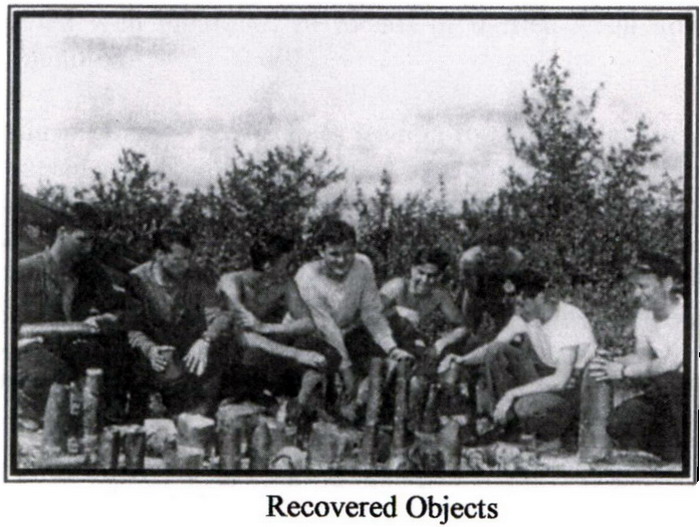

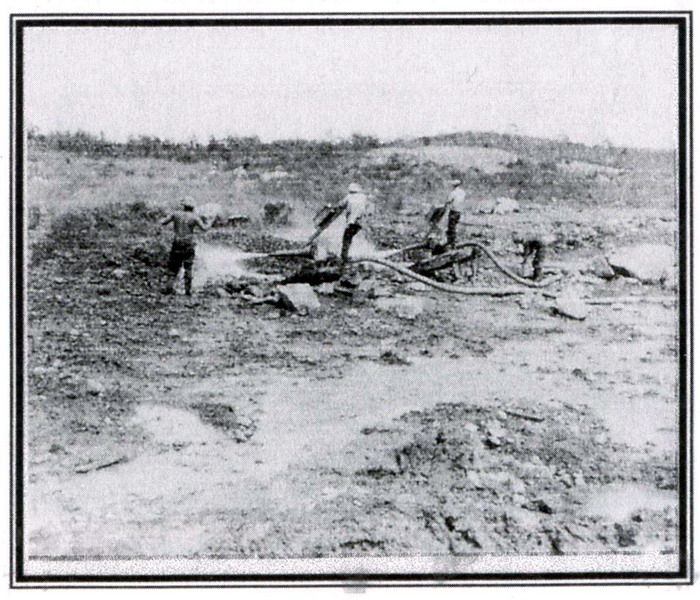


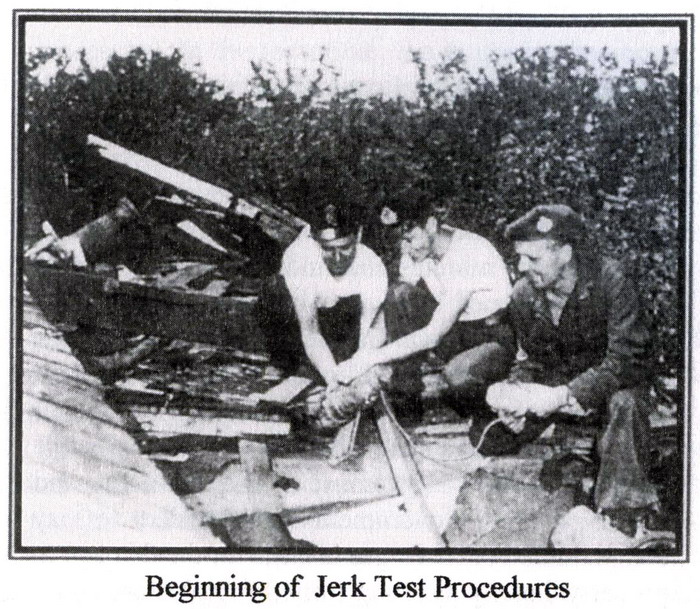
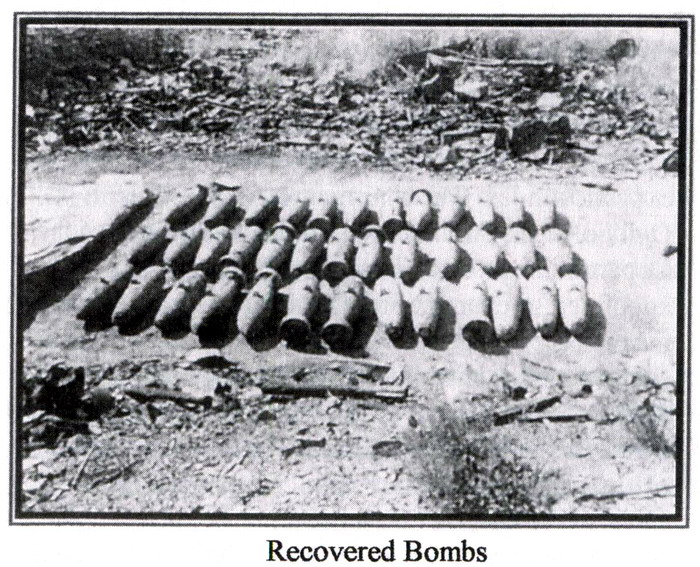
Chapter 8, The
Minister’s Press Release
On August 17, 1945 the Royal Canadian Navy issued this
Press Release. Its contents are as follows:
The Honourable Douglas Abbott, Minister for Naval
Services announced today that he had received and
examined the minutes and findings of the Board of
Inquiry convened to inquire into the causes of the
explosion at the Royal Canadian Naval Magazine at
Dartmouth, NS, on the 18th and l9th of July, 1945.
The Minister stated that while it has not been possible
to determine the exact cause of the initial fire and
explosion, the Government has decided to pay
compensation on an ex gratia basis for the damage to
property directly resulting from the explosion.
So far as the future of the Magazine at Dartmouth is
concerned, the Minister stated that, in cooperation
with the Hon. C.D. Howe, Minister of Munitions and
Supply, an independent committee of explosive
experts, under the chairmanship of Lt. Col. G.
Ogilvie, of the Ammunition Production Branch of the
Department of Munitions and Supply, has been
appointed to examine into the history of the present
magazine, its general design from a technical
standpoint, the suitability of the existing buildings and
facilities, the adequacy of the safety precautions
which had been in force, and the methods of disposal
of ammunition which are now being carried out.
Active steps are now being taken to clear the damaged
area and to effect such temporary repairs as may be
necessary. In the meantime, the magazine has been
declared completely non-operational and, apart from
the necessary clearing, no further transactions in
explosive stores are being carried on.
The Minister summarized the findings of the Naval Board of
Inquiry as follows:
The Board was unable to determine the initial cause of the
explosion. From the evidence it would appear that fire caused
explosives to ignite, thus increasing the intensity of heat to
such a degree that detonation resulted. There was no evidence
that fire had been observed by any person prior to the hearing
of the first small explosions.
The possible sources of fire were unextinguished smoking
materials or sparks, and spontaneous combustion of waste or
other material.
Contributing factors to the possibility of fire and the major
explosion which resulted were as follows:
(a) The landing of ammunition from ships to be declared
surplus to requirements.
(b) The landing of ammunition from ships required for the
Pacific Theatre which were to be refitted.
These factors resulted in a large accumulation of explosive
stores on the South Magazine Jetty, where the original fire
occurred, further accentuated by the fact the North Magazine
Jetty was unusable due to its having been cleared to allow
essential repairs to be undertaken.
The Board also found:
(a) That certain explosive stores had been accepted and stored
on the South Magazine Jetty in contravention of Naval
Magazine and Explosive Regulations and Regulations for
Naval Armament Services.
(b) That the organization with respect to supervision was not
sufficiently defined nor was enforcement insisted upon which
would have made it impossible to smoke in prohibited places,
and since the South Jetty is in all respects part and parcel of
the Magazine Area, all magazine regulations should have
been rigidly enforced.
(c) That there were not at this time included in the
organization any arrangement for a guard to be placed on the
jetty to ensure that smoking restrictions were enforced, both
with respect to the jetty itself and also harbour craft secured
thereto. This factor was most important at the time of the explosion
on July 18th in view of the fact that large quantities
of explosive stores were stored on the jetty.
(d) That the construction of the building and south jetty
planking were of wood.
Taking into consideration the above factors, and having heard
the evidence of witnesses who were in the immediate vicinity
of the jetty just prior to the outbreak of the initial explosions,
and the evidence of others who viewed the jetty from various
locations, including observations of a passenger in an aircraft
flying over the area, it was the Board’s opinion that:
(a) The fire and explosions did not originate in a Lighter or
other craft moored alongside the South Magazine Jetty.
(b) The first explosions observed or heard appeared to be at
the seaward end of the South Jetty.
(c) No fire was seen before the initial explosion.
(d) The cause of the explosions was considered to be fire, the
probable origin of which was due to unauthorized smoking
and carelessness with respect to disposal of ignited smoking
materials.
Other possible causes considered by the Board were:
(i) The possibility of spontaneous combustion, as the
congested state of the jetty would have made it difficult to see
that all materials that might be subject to ignition were
moved.
(ii) The shifting of insecurely piled ammunition and the
consequent striking of Primer caps.
(iii) Sparks from smoke-stack of the coal fired boiler on the
floating Pile Driver operated by the private Contractor. This
was not considered very likely as the boiler fire had been
banked at 4:00 PM on Wednesday, 18th July.
The Board reported that all personnel had left the jetty by 5:45
PM, and the only person proceeding on the jetty after that
time and prior to the initial explosion was the duty Stoker,
who at approximately 6: l5 PM had completed rounds of the
power Lighters secured to the jetty. He had seen no evidence
of fire at that time.
In inquiring into the events of the l8th-l9th July, the Board
found that when the fire and explosion occurred, the alarm
was promptly turned in and responded to by all Departments
concerned. The fire party attached to the Magazine area
brought to bear all equipment at their disposal and advanced
to a position as close as was prudent, playing water on
buildings and ammunition dumps. They were in turn assisted
by the Fire Departments of the Naval Establishments in
Halifax and Dartmouth. The extent of fire and explosions was
such that it was deemed uncontrollable in a fire fighting
sense, and withdrawal became necessary. The Board found
that at great personal risk all personnel, Civilian, Veterans
Guards and Naval had made a determined effort to bring
under control a situation that was beyond their power, and
that the withdrawal of personnel was not premature.
The Board further found that all Senior Officers concerned
were recalled and promptly assumed their responsibilities. All
Civilian Authorities were advised regarding areas
recommended to be evacuated and the response and
arrangements were effected efficiently having regard to the
conditions prevailing. Prompt steps were taken to keep the
other Services informed of the situation, the co-ordination
being entirely satisfactory. Prompt steps were taken to resume
fire fighting in the area as soon as an aerial survey and
observation of the area on foot had been completed, and had
disclosed that resumption was practicable.
The Board also found that certain conditions prevailing
throughout the Magazine affected the efficiency of the area as
a whole. Some of these conditions were as follows:
(a) The over stowing of Magazine Buildings and the stowage
of explosive stores in the open in the Magazine Area in
contravention of the regulations prescribing safety distances.
(b) The presence of wooden and other unsuitable buildings
and of brush and grass in certain areas constituted a fire hazard.
The Board also reported that with the exception of the
Inspection and Laboratory Staffs, practically no organized
training had been carried out for the remainder of the staff
which constituted the largest group of personnel at the
Magazine. This resulted in a low average of technical
knowledge. Organized training was rendered difficult owing
to press of work and large turnover of staff in this group.
An adequate sense of responsibility respecting adherence to
regulations was not instilled in all personnel attached to the
Magazine area. This, combined with the fact that there were
not sufficient guards and experienced Foremen and Charge
Hands available, led to a laxity in enforcing the Safety
Regulations and the Regulations for Naval Annament
Services.
The Alarm system as installed was not in accordance with
accepted modern practice, and no hook-up with the Naval and
City Fire Stations could be effected in order to ensure
immediate assistance as the situation demanded.
So far as personal responsibility is concerned, the Board,
having been unable to determine the cause of the original
explosion, were unable to attribute direct blame to any person
or persons.
The Board found, however, that:
(a) Explosive stores were landed, accepted, and stored on the
South Magazine Jetty in contravention of “Naval Magazine and
Explosive Regulations," and "Regulations for Naval Armament
Services" in force at that time. This constituted a hazard.
(b) Notwithstanding that certain Regulations could not be
adhered to in their entirety, and that in certain specific
instances these conditions had been authorized or acquiesced in by higher authority, it was the opinion of the Board that an
energetic policy of enforcement was not pursued by those
responsible in the Magazine itself.
The Minister further stated that Rear Admiral V. G. Brodeur,
CBE (Commander, British Empire) Commanding Officer
Pacific Coast, has been appointed Acting Inspector-General
of Naval Ordnance charged with the duty of enquiring further
into the situation at the Dartmouth Magazine and also of
reviewing the present condition of all Naval Magazines
throughout Canada, making whatever recommendations to the
Minister he may consider necessary.
A further release, File: l70l, 4/4/46:
ROYAL CANADIAN NAVY PRESS RELEASE
FOR IMMEDIATE RELEASE
Most of the magazines destroyed in last July’s
explosion at Bedford will not be rebuilt, according to
an announcement released by Naval authorities, and
the main storage will be at Renous, NB. The Halifax
magazine will primarily be used in future for servicing
the fleet operating out of the port and in such a
capacity, will not be required to handle the large
quantities of explosives it contained at the time of last
year’s accident. Rebuilding such as is contemplated
will be commenced with the completion of clearing
up activities in the devastated area.
Speeding of the latter operation will get under way shortly. Winter
conditions necessarily curtailed the work that began last fall, but
favourable March weather has made possible an early start in the
clearing up operations.
The extension planned is not for the purpose of providing additional
storage for explosives, but is to provide additional safety
arrangements and the relocation of the administration and technical
buildings. These will be built adjacent to the old
explosive area, in all probability.
Chapter 9, From The Inside
For many years Magazine personnel diligently scoured the
blast area and beyond to recover any dormant ammunition or
explosives that might remain. One cannot help but be
impressed with the thoroughness of the investigations and
clearing operations that began immediately after the explosion
of July 18, 1945. Safety was paramount, not only for service
personnel involved in the search, but for unauthorized others
who might penetrate the Magazine area.
Typically the recovery year would begin early in May with a
three-day training period. During this time, the Bomb
Disposal Officer, M. E. McDowall would deliver lectures on
explosive ammunition generally, displaced ammunition;
related how the operation had progressed to date, and how it
is proposed to finalize the clearance. Industrial safety training
and practises were also included in the instructional period.
This was followed by an examination and supervisors
appointed.
As the physical activity got underway, brush cutting would
commence, followed by a thorough surface examination of
the site to recover all visible ammunition and explosives.
This in turn was followed by flushing with high pressure
pumps to a depth of several feet. Existing and newly-made
water sources were used. A dammed-up swamp and creek
brought water levels up by more than five feet in one area,
and this provided an enormous supply of fresh water.
Sluiceways carried the debris away from the site after any
explosives were culled out and removed. This was continued
until explosive objects were no longer found in the sub-soil.
In 1947 approximately 660 tons of displaced ammunition was
dumped, this being taken to sea aboard a flat-scow, which
was towed by CNYC Riverton in six loads. Other than
burned out objects, this ammunition was all packed in
sawdust in boxes and dumped from the scow on shoots.,
which were permanently installed, two on either side of the
barge.
All through the summers of 1946 to 1949, weekly reports
were submitted by the Bomb Disposal Officer to the
Superintendent Naval Armament Depot describing the events
of the week, and how the various functions were carried out.
Many obstacles were encountered, some perhaps unexpected.
For example early in July of 1947, it was obvious that
prowlers were entering the restricted areas in search of scrap
brass. At midnight on Saturday, July 5, 1947, several military
staff and an RCMP officer hid inside a shed and within a half
hour observed four persons approaching the area. They passed
by within feet of the shed, and at about 1:00 am, "Legs were
sighted against the whiteness of the roadway. It could not be
distinguished how many people were approaching, owing to
the poor visibility. They were allowed to come within thirty
feet of the hut, when Constable Skinner ran out, shone a light
in their eyes, and apprehended the thieves. They were each
carrying a sack of scrap brass."
Following a search, a small coal shovel, a pickaxe, and
twenty-nine more sacks were found, of which five were filled
with brass. The prisoners were questioned, and a Studebaker
truck was discovered parked in front of a nearby house on the
Dartmouth-Bedford Highway. The thieves were taken to the
Halifax Police Station, where they were booked on a charge
of theft. They appeared in County Court and pleaded guilty to
the charge, "Theft of a quantity of scrap brass, valued at more
than $25.00, the property of His Majesty the King, from RCN
Magazine, Bedford, NS." They were fined $30.00, with the
alternative of twenty-five days in prison, and all elected to
accept the jail term.
This report, like many others was signed by M. E. McDowall,
Bomb Disposal Officer.
Reports continued to describe the clearance operations, which
were primarily by hydraulic means, high pressure pumps
pumping water through long stretches of hose forcing rubble
and ammunitions to be exposed and separated and collected.
To ensure safety, a high degree of discipline was mandatory,
even to such related activities as the transportation of
personnel. Three men were observed standing in the box of a
truck while in motion, and were deemed to be punished by
suspension or dismissal.
While suspicious objects discovered outside the Magazine
area were reported on a regular basis, often such objects were
examined and found to be non-explosion related. During the
week of August 9, 1947, the RCMP (Royal Canadian
Mounted Police) reported an object along the shores of
Bedford Basin. Following investigation, "The object was
found in two (2) feet of water, and was determined to be an
old gasoline tank, measuring eighteen (18) inches in diameter
and forty-four (44) inches in length, that had been discarded
from a small boat. It was left exactly where it was found."
On another occasion, on August 20, 1947, it was reported
that a forty-five gallon steel drum had been sighted off
Terrence Bay by three fisherman. This had to be investigated
of course, as were all suspicious objects, but it turned out to
be harmless and were not dumped by RCN Magazine.
There were often legitimate discoveries. On Sunday,
September 7, of the same year, a night watchman on Kempt
Road, Halifax, had found a projectile. The Bomb Disposal
Officer, M. E. McDowall, went to investigate. He found the
watchman in the heart of Africville, and was an employee of
a Montreal firm who was dismantling barges purchased from
War Assets Corporation. He related that while making the
rounds of the barges, he spotted the shell in about eighteen
inches of water. He also said that there was no need to handle
the object with caution, as it would not "go off," because he
had unscrewed the fuse and when nothing happened, he screwed it back down again. The man was given a severe
warning, after which he replied, "Oh yes, I know all about
these things, I was in the Army for five years!"
The projectile was four inch, from a fixed round, fitted with
a badly damaged fuse. It was thought it came from the
Explosion area, and that it was thrown the two miles during
the explosion of 1945. It was taken to the Magazine, and
packed with other explosive objects to be dumped.
McDowall told the RCMP that his department was only too
willing to investigate reports of explosive objects, and
acknowledged that a good deal of his time was spent in just
such activities. He went on to request that a procedure be
followed in making such reports. Pointing out that in his
experience, practically all materials recovered had been
tampered with at one time or another, and it could be
expected that an accident would eventually occur. lt seemed
that it would be in the interests of the public to have the local
newspapers publish an article on the dangers of handling
objects about which people had no knowledge, and that are
usually in a damaged or deteriorated condition.
Another tragedy occurred on Thursday, October 9, 1947. A
loaded scow was taken to sea by CNAV (Canadian Naval
Auxiliary Vessel) Eastore and dumped. Six workers and the
Bomb Disposal charge hand accompanied the scow to sea, but
during the implementation of this operation, a member of the
squad was lost at sea. The worker, B. J. Pothier, 47 years of
age, was employed dumping boxes of ammunition which had
been recovered from the sub-soil at the Magazine site. It
appeared that his gauntleted hand became jammed between
the handle of the box and the box itself, pulling him into the
water when the box was dropped overboard. He did not come
to the surface until the stern of the tow was well past the spot,
but a lifebelt was thrown to within five feet of him. The crew
reported that Pothier made a definite attempt to swim, but he
appeared to be stunned, and once more the body disappeared,
and was not sighted again.
The handling of boxes by their handles was contrary to
standard safety regulations, as it was feared that the bottom of
the boxes might collapse, causing the explosives to be
dropped. In this instance none of the workers was wearing life
jackets. Although safety of personnel was a prime objective
of officers directing operations, lapses were bound to occur.
This was a case in point.
Again in 1947, as the construction of the Bedford-Dartmouth
highway proceeded, the contractor cut, piled, and burned the
brush along the right-of-way. Ten or so men were working
around the fires when a heavy explosion occurred, and three
workers were knocked to the ground by the blast. Luckily no
one was injured, although there was a great deal of excitement
and nervousness. Prior to this time, a major difficulty had
been keeping the men impressed on the danger of handling
excavated materials. The psychological effect of this mishap
was that any doubts about the importance of strict safety
practises were completely erased.
Within the boundaries of the Magazine, emphasis was
continued to be applied to observe safety precautions. The
handling of fused Hedgehogs was of considerable concern.
Fuses were often badly distorted and broken. During recovery,
the projectile, if damaged in any way, was subjected to a "jerk test" by a worker pulling the object along the ground on an
eighty foot line, and when clear of the operation, it was
packed in sawdust and boxed for disposal. Naturally all hands
stood well back and staging was placed so the object would
not fall. In some areas these larger type explosives were
exceptionally numerous, and as sometimes as many as one or
two per day could be located, great care was required.
On May 5, 1948, Mr. George Fancy, an ammunition worker
employed at the Magazine, reported that his two sons had
been looking for salvageable material along the edge of the old
Dartmouth-Bedford Highway and had found a quantity of
ammunition, and that they had returned home bringing two
rounds.
The Bomb Disposal Officer, McDowall, went to the Fancy
residence where he took into his possession the two rounds,
one being high explosive incendiary and the other high
explosive tracer. The boys directed the way to the spot
approximately three-quarters of a mile from the north gate of the Magazine, where an additional 96 rounds were recovered.
Due to the fact that the ammunition was found piled under a
small spruce tree, and that it had the appearance of being
placed, it was probable that they had been deposited by
someone who had planned on picking them up at a later date.
The RCMP was notified.
At 11:45, September 4, 1948, McDowall was informed by
Naval Operations that an object, believed to be explosive, was
on a fishing boat, moored at the Burns Fisheries wharf, Lower
Water Street, Halifax. He was instructed to carry out an
investigation and recovery, if necessary.
On arrival at the wharf, Mr. Burns, the proprietor, told McDowall that a Naval Officer had arrived to view the item,
and had said he would return. The object was identified as a
Hedgehog Projectile, with a damaged fuse. Naval Operations
were contacted, said that everything was in hand, and that
destruction by countermining would be carried out on
McNab’s Island. McDowall pointed out that this had been
"implemented in 1945, which caused considerable excitement
and concern to both the Naval Authorities and the citizens of
Halifax, and recommended that this type of demolition not be
carried out so close to Halifax and Dartmouth." Attention was
also given to the fact that a guard had not been posted, and
that no one of authority was in attendance.
The Hedgehog Projectile was recovered and removed to the Magazine to
be disposed of in the approved manner.
In August, 1965, a report was submitted to Naval Operations
by Commander W. Onysko concerning the "Clearance of
Ammunition from low water mark, RCN Ammunition Depot,
Bedford, NS":
l. Submitted for information that at the time of the explosion
at the Bedford Ammunition Depot in 1945, a large quantity of
ammunition was projected into the water off the old South
Jetty, much of it in a damaged condition.
2. Small quantities of this ammunition in subsequent years
washed up onto the fore shore, was recovered, and
subsequently dumped at sea. No concerted effort has been
made to retrieve that ammunition, which was still under
water and which is continually deteriorating and becoming
exceptionally dangerous if handled.
3. In very recent years, SCUBA diving has gained immensely
in popularity. In recent months, it has been noted that SCUBA
divers in small boats are diving on this submerged,
unexploded, ammunition and appear to be retrieving brass
cartridge cases and other items, presumably to be sold as
scrap metal. The dangers inherent in this practise, particularly
by persons with little of no experience in the handling,
examination, repair, emptying and/or destruction of
ammunition cannot be over emphasized.
4. It is suggested that if a SCUBA diver inadvertently had an
accident while retrieving or handling this ammunition, it could
possibly prove very embarrassing to the Crown, due to the
widespread publicity which undoubtedly would ensue. Action
was taken by the Officer in Charge of the Bedford Ammunition
Depot some months ago to place a four foot by eight foot sign on
the perimeter chain link fence, near the old South Jetty, warning
of the dangers of this unexploded ammunition.
5. It is recommended that in order to protect both the SCUBA
diving public and the Crown, from accidents and/or
unfavorable publicity, that one of more of the following
courses of action be taken:
(a) Immediate arrangements be made for the
Operational Clearance Diving Unit to retrieve all of the
displaced ammunition and take it to sea for disposal in deep
water.
(b) Have a notice to be placed near the perimeter of
the diving area warning of the dangers to divers and others.
(c) Have the water area containing the displaced
ammunition marked with buoys, with several of the buoys
bearing signs warming of the danger.
6. In the interim, any further incidents involving SCUBA
divers at that particular location will be referred to the
Queen’s Harbour Master for information and action as
considered necessary.
Original signed by W. Onysko, Commander
Previous reports had advised that the shores of the area were
cleared and that further work would be unnecessary.
However, with this disclosure and other diving unit
exploration, it was obvious that the beaches and adjacent
waters were far from explosive free. A re-search between the
security fence and low water revealed astonishing results. A
six inch shell, boxes of ammunition complete with rounds,
and small arms ammunition of all calibres were found in large
quantities.
Further exploration and clearance was continued.
Roy Nelson, now retired, and living in Halifax, worked at the
Magazine for "thirty-three years and seventeen days." He had
been working in the Laboratory, repairing ammunition that
could be returned to the naval ships.
He had just returned to his home in Tuft’s Cove after his shift
on the 18th, and was standing at his open front door, when the
explosion took place. The concussion blew him across the
room and he landed on their chesterfield, unharmed, but pretty
well shaken. Realizing what had happened, he bundled his
wife and two children into his car, and drove towards
Dartmouth, ending up at the RCAF barracks in Eastern Passage. About midnight there was a moment of panic, when
an excited man rushed in and shouted that everyone should
head for the "water"; that a "big one" was
coming. Such
rumors continued throughout the night and into the next day,
most of them highly exaggerated, and usually unfounded.
Mr. Nelson and his family remained at the barracks for that
night and the next, and finally returned home on the 20th, to
find their house had shifted on its foundation, the chimney
destroyed, and all windows shattered. He did receive some
compensation, but "it didn’t amount to much," he recalled.
When he went back to work a few days later, and for the next
six months, he and his co-workers began the task of
retrieving "dead-headers" that had blown up all over the place.
Small fires were continually being set by snow-flake rockets,
which, like fireworks, would spiral up in the air, and when
they landed, would ignite grass and scrub brush. He
remembers a "Squid" missile destroyed a water tower up on
the hill, and another one landed on a rock at the edge of the
Basin, the parts of which they tenderly placed in a bucket of
water, and took away for proper disposal.
For the employees of the Bedford Magazine, even though they
had been working with and around all kinds of explosives for
many years, the explosion itself was literally an earth
shattering event. Those who felt it was just a "matter of time"
before the volatile stores would activate had their worst fears
confirmed. But, wartime experience and knowledge equipped
personnel to literally haul Halifax, Dartmouth, Bedford, and
surrounding communities from the brink of disaster.


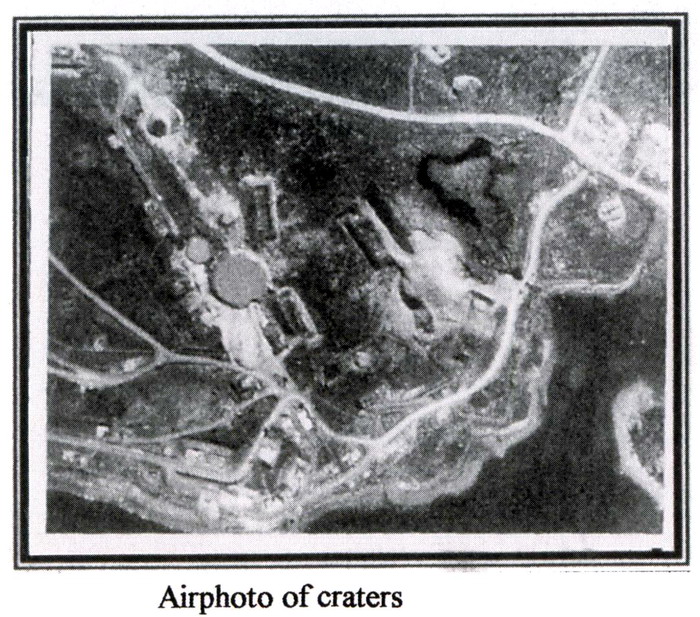
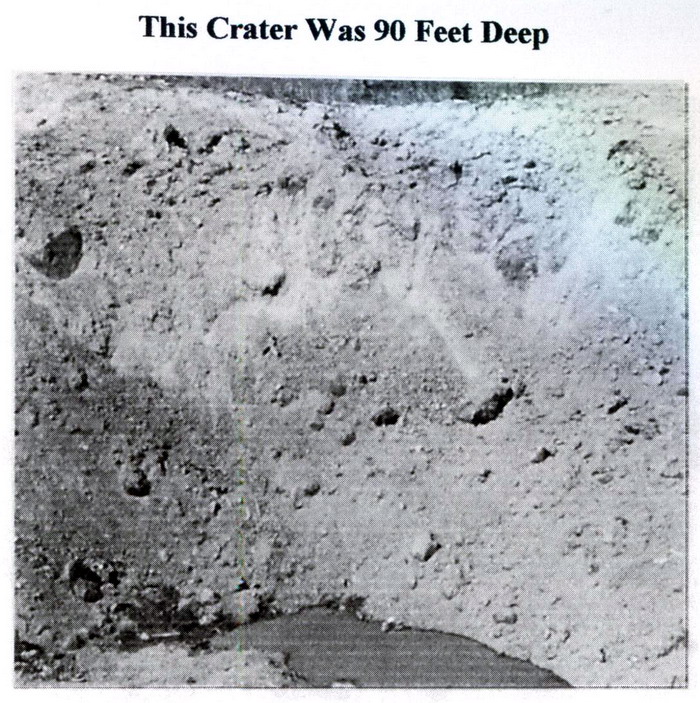



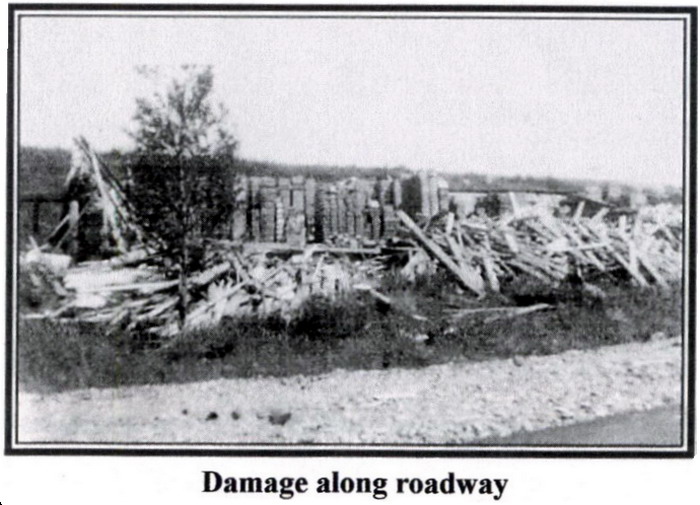

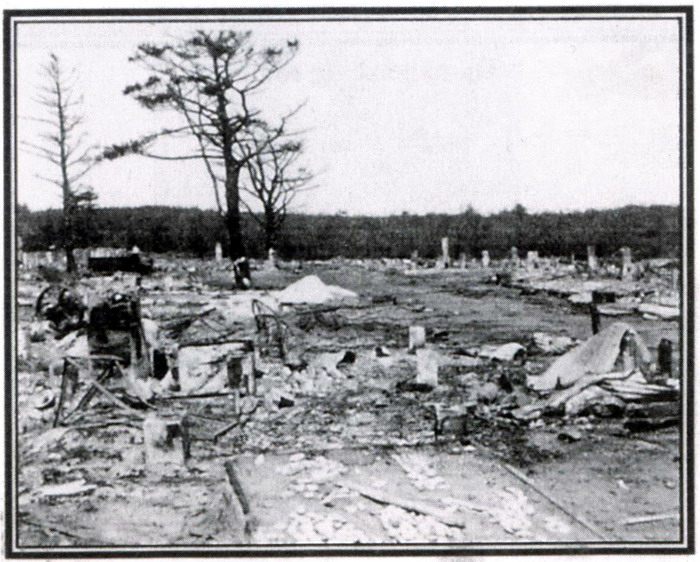
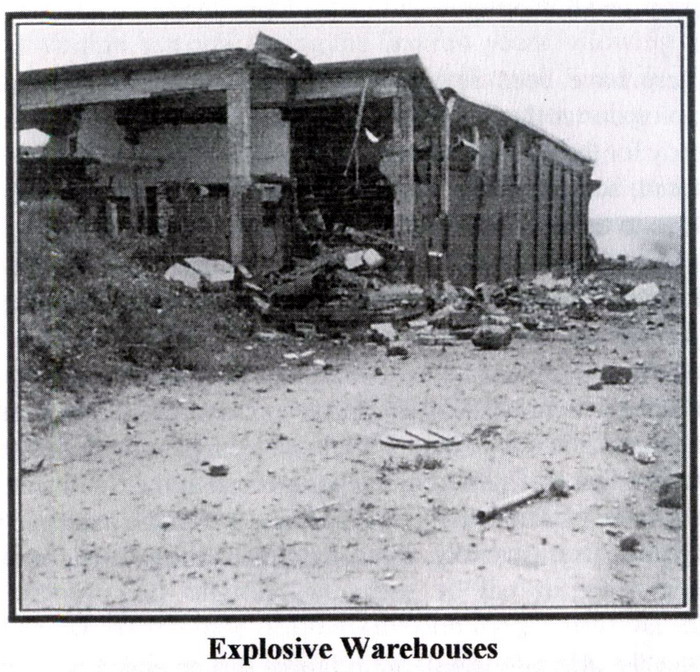
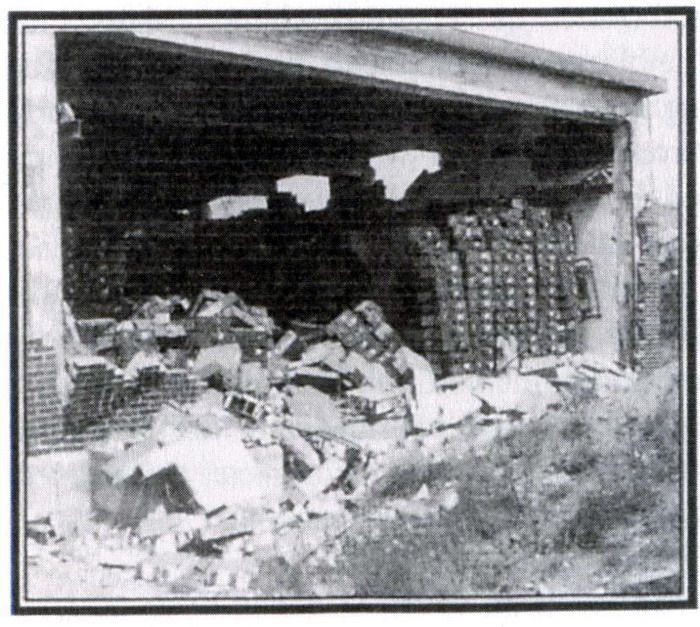
Chapter 10, Epilogue
There have been several theories as to the cause of the
explosions at the Bedford Magazine. The Magazine was not
ready for the massive quantities of ammunition that had to be
stored, so regulations were not observed. Those who were
close to the situation knew that real trouble was going to be
hard to avoid. Nothing was done to correct the improper
storage or handling of the discharge of explosives and on July
18, 1945, the inevitable happened.
Although there were many injuries, only one life was lost, and that in the line of duty.
Patrolman Henry Craig discovered
the fire that had started in the underbrush at the South Jetty,
ran up the pier to sound the alarm, and before he had time to
consider his own safety, he was killed by the first enormous
blast.
Once the alarm sounded, fire brigades sprung into action, and
Naval authorities quickly took charge. Many brave men
battled the blazes, defying the exploding ammunition which
was flying in all directions. But for their courage, the damage
could have been much worse. The civilian population
evacuated their homes and businesses without panic. Their
needs were attended by the many volunteer agencies that
quickly mobilized. Hundreds of buildings were damaged,
some beyond repair, both within the boundaries of the
Magazine, and in the north-ends of Halifax and Dartmouth.
Returning to their homes after the "all clear" was given, many
were shocked to find them completely destroyed. Full
compensation was committed and paid.
Much credit has to be given to the Military leadership and
personnel for their diligence in unearthing the unexploded
ammunition, not only during the first few years following the
explosions, but for the decades that followed. Security and
safety are rules by which the Magazine operates today.
Approximately 50% of the buildings in the Magazine prior to
July 18 were destroyed or severely damaged. Two permanent
buildings have been rebuilt along with a number of
"temporary" storage buildings for non-explosives. There are
plans underway to construct a new ammunition maintenance
facility, and additional temporary storage buildings to replace
some of the originals (now over 50 years old), also for non-explosives.
At present there are eight military personnel stationed at
CFAD Bedford, along with some 59 civilian employees.
Numbers vary slightly according to the responsibilities
assigned. At the time of the Explosion there were over 200
combined civilian and military personnel. The Magazine has
552 hectares of area enclosed by fence, of which 230 hectares
are high security. It is also the home to over 60 white-tailed
deer, which during the hunting season increases to well over
a hundred. They jump over an 8-foot high fence to escape
hunters roaming the area.
The facility performs an essential service to the many Naval
craft that require ammunition and other explosives for their
training and peace keeping duties. Its personnel are ever
working on new armaments and techniques. In its own quiet
way, the institution itself and its people are part of the Halifax
heritage, and will continue in that role for many years to
come.
Special
Acknowledgements
I wish to thank the commanding officer of CFAD Bedford, Lieutenant
Commander David Ireland, for his valuable critique of the material
presented in this book, and for his enthusiastic support throughout.
Mr. Glenn J. Vallance, Material Control and Environment Officer
provided me with documents and statistics which were essential to
the accuracy of the research. I also am indebted to Marilyn Gurney,
Curator of the Maritime Command Museum, who made available to me
much of the archival material and photographs I have been privileged
to use. Heather Harris agreed to read the manuscript for comment and
suggestions for improvement, and I very much appreciate her
contribution. There are many others, too numerous to name
individually, but I hope each will know how much I am indebted to
you for the recollections and data so willingly shared, which
information I used to verify conditions both within and outside the
Magazine during and after “The Other Halifax Explosion."
HMW


Resources
Interviews and newspaper accounts offered useful insights into "The
Other Explosion." Other materials that were helpful were Thomas Raddall’s
"The Warden of the North" and W. C. Borrett’s “Penalties
of War." The reports of the Naval Inquiry were invaluable. Others
included:
1. Halifax Nova Scotian, July 13, 1985
2. Chronicle Herald, Sept. 1989, August 1991
3. The Naval Service of Canada, Gilbert Tucker
4. Halifax Mail Star, May 5, 1987 (Alex Nickerson)
5. The Story of Firefighting in Canada, Donal Baird
6. The Senior’s Advocate, June 1986
7. The Royal Canadian Inquiry, April 4, 1946
8. CBC Staff Magazine, Radio Vol. 1, No. 10
9. The Halifax Mail, July 19, 20, 21, 23, 1945
10. The Daily News, Peter Hayes, "The Other Explosion" May 19, 1992
11. Ottawa Journal
12. Montreal Gazette
13. Ottawa Citizen
14. Toronto Globe and Mail
15. New York Herald Tribune
16. Trident, the Canadian Naval Newspaper, August 9,
1978, Felicity Hannington
17. Canadian Press, Gerry Arnold
18. Halifax Mail Star, July 20, 1945
19. Rube Hornstein
20. Don Tremaine
21. Sisters Mary Martin, Ellen Keller, Cecelia Rooney
22. Don Cunningham
23. In the Wake of the Alderney, Harry Chapman
24. Maritime Command Museum, Marilyn Gurney
25. Malachi Jones
26. David Jones
27. Lt. Cdr. David Ireland
28. Glenn Vallance
29. Jerry Doyle and Roy Nelson, Retirees
30. The Halifax Star
31. Halifax, The First 250 Years, Fingard, Guildford, Sutherland
32. Public Archives of Nova Scotia
33. Halifax City Regional Library, Reference Department

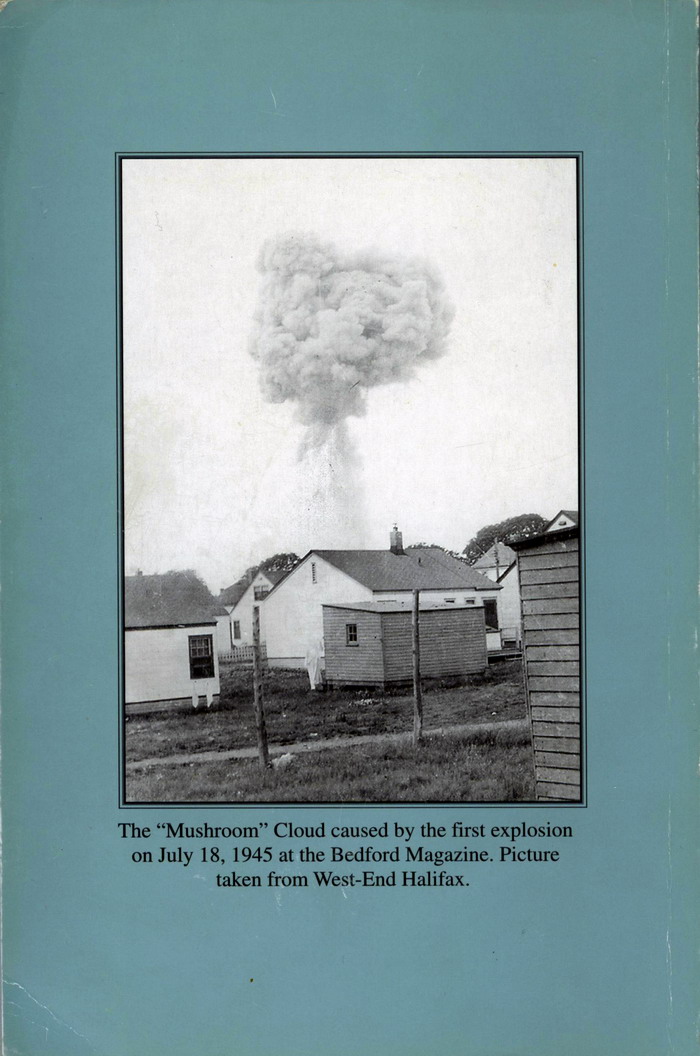
Mr. Wright is the author of
several other
interesting books,
5 of which, like this one, can be found at this public library link.
H. Millard Wright Books
A few
can also be purchased at Amazon.ca
And this is his latest book.
LOOKING BACK:
Wartime British Schoolchildren Come To Nova Scotia
Other Links
Here are some
other July 1945 Halifax/Bedford Magazine Explosion websites,
most with additional pictures and stories.
Wikipedia
http://en.wikipedia.org/wiki/Bedford_Magazine_Explosion
'An East Coast Port': Halifax in Wartime,
1939-1945
http://www.gov.ns.ca/nsarm/virtual/eastcoastport/results.asp?Search=ch7&Language=English&Start=91
Mysteries of Canada
http://www.mysteriesofcanada.com/Nova_Scotia/halifax_explosion_of_1945.htm
Magazine Hill Explosion - July 18, 1945
http://www.angelfire.com/ns/bkeddy/maghill.html
Bedford
Explosion 1945
Google Images
Halifax Explosion 1945
Google Images
The Memory Project -
Sarah Earldine Krys (audio)
Speaks about the V-Day riots as
well
http://www.thememoryproject.com/stories/88:sarah-earldine-krys/
The Memory Project -
Ernest Hayward Winter (audio)
Speaks about Navy life as well
http://www.thememoryproject.com/stories/1505:ernest-hayward-winter/
V-Day Riots in Halifax
Just a few weeks before the explosion
https://www.youtube.com/watch?v=hL2y87PoB3M
Any questions or comments can be sent by
clicking the email below.
mysteriousns@gmail.com
Copyright©2014mysteriousnovascotia.com
|
































































